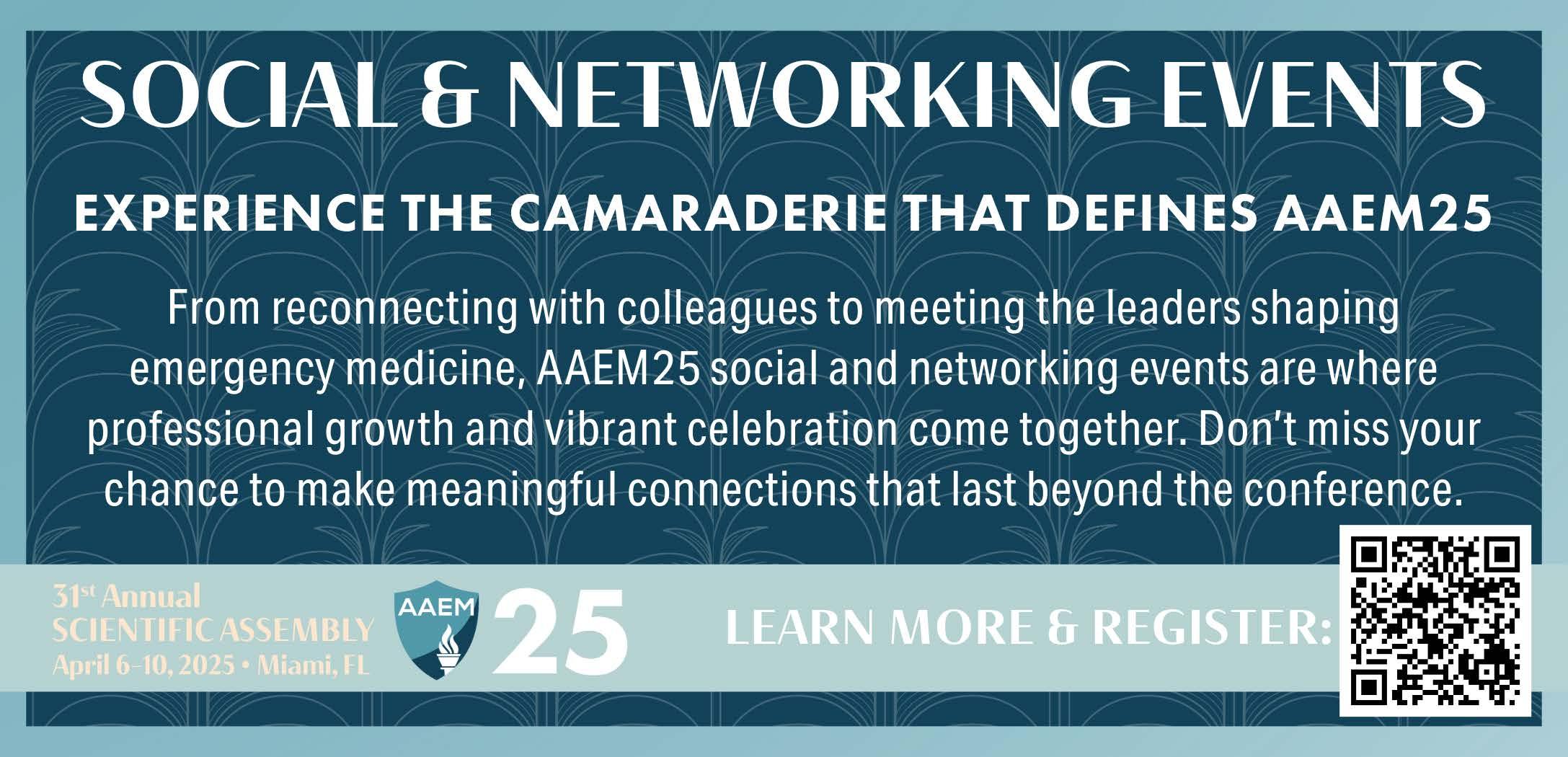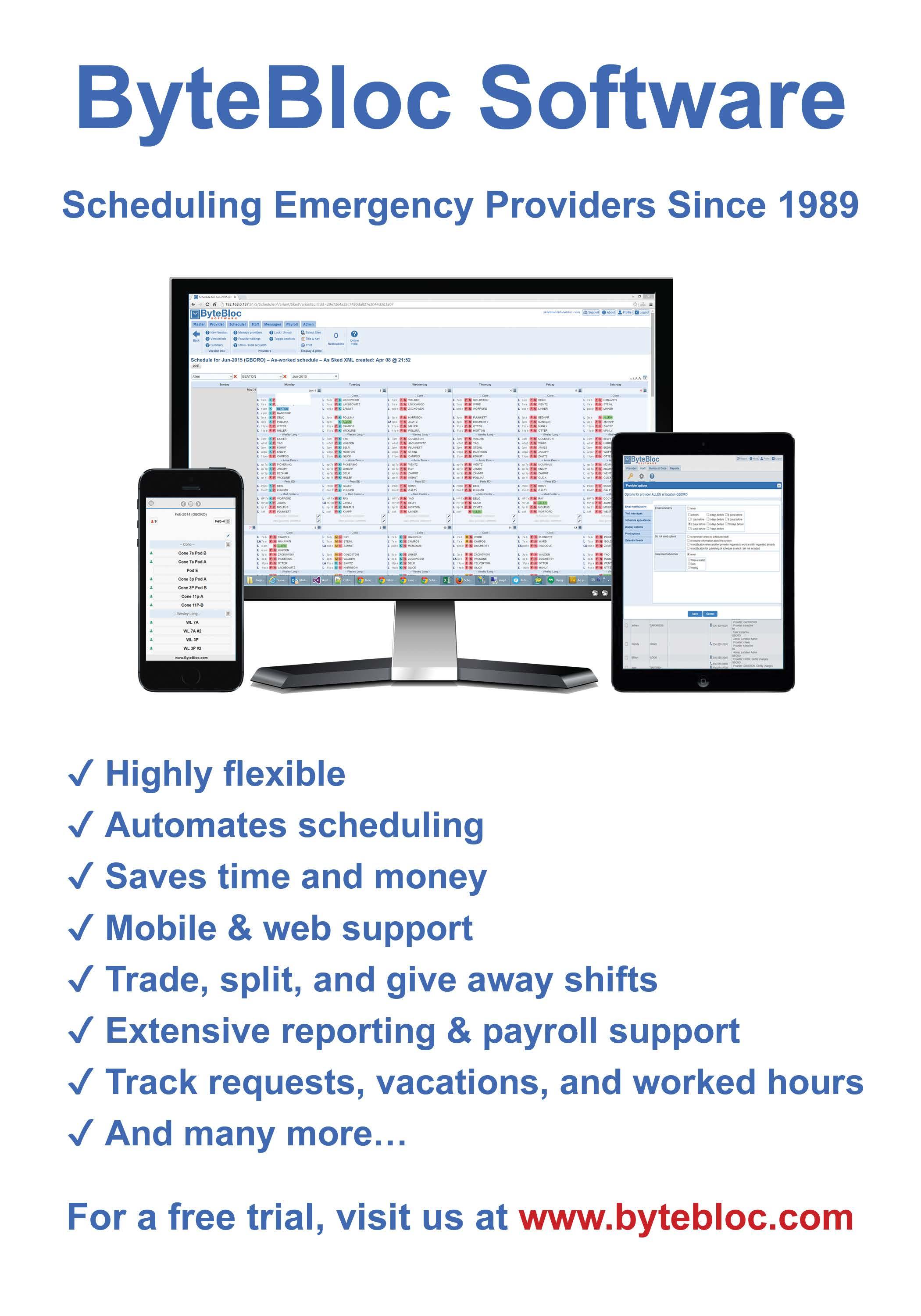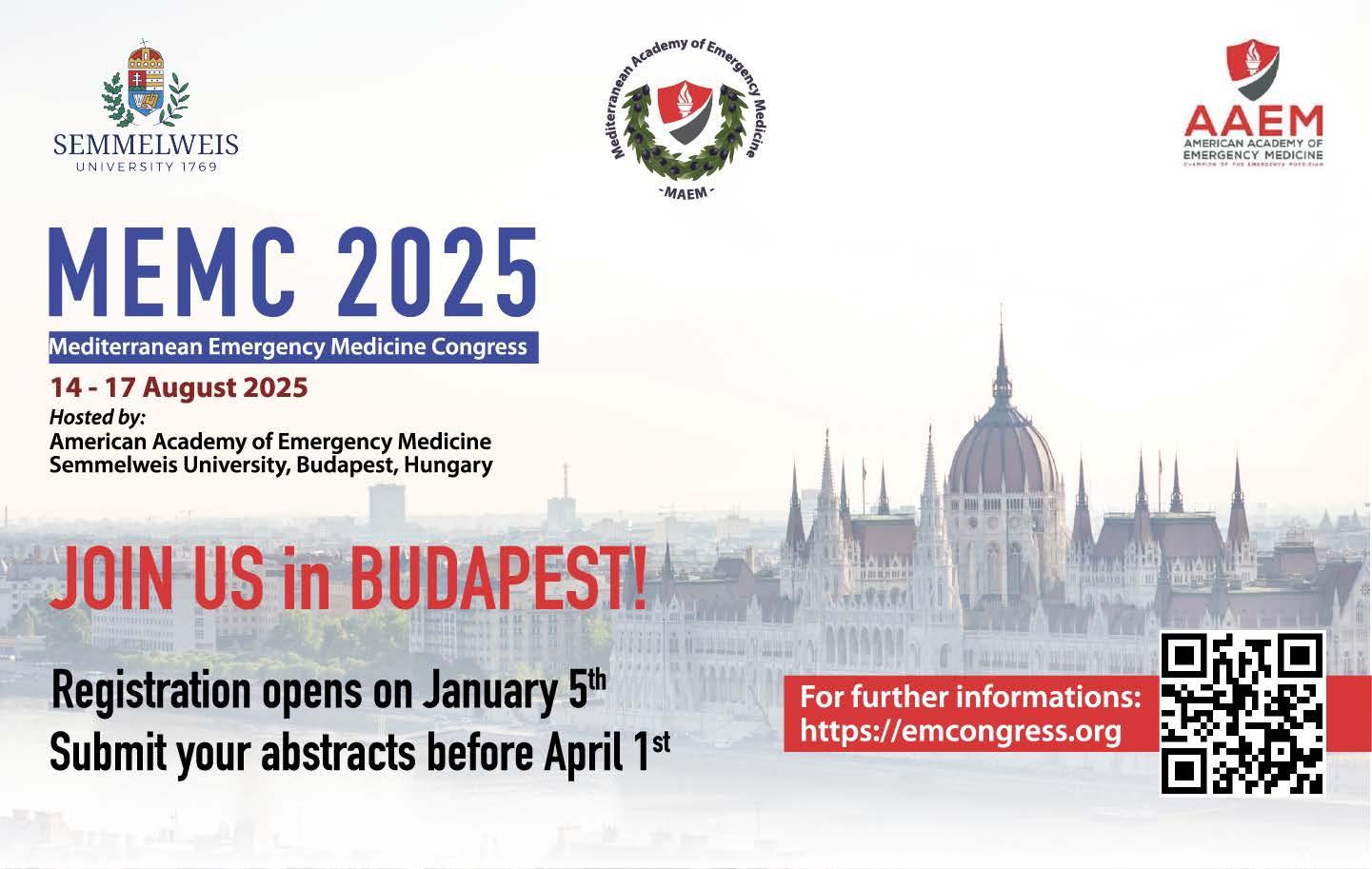
TM


TM
Officers
President
Robert Frolichstein, MD FAAEM
President-Elect
Vicki Norton, MD FAAEM
Secretary-Treasurer
Phillip A. Dixon, MD MBA MPH FAAEM CHCQMPHYADV
Immediate Past President
Jonathan S. Jones, MD FAAEM
Past Presidents Council Representative
Tom Scaletta, MD MAAEM FAAEM
Board of Directors
Heidi Best, MD FAAEM
Laura J. Bontempo, MD MEd FAAEM
Kimberly M. Brown, MD MPH FAAEM
Frank L. Christopher, MD FAAEM
Fred E. Kency, Jr., MD FAAEM
Robert P. Lam, MD FAAEM
Bruce Lo, MD MBA RDMS FAAEM
Kevin C. Reed, MD FAAEM
Kraftin Schreyer, MD MBA FAAEM
YPS Director
Haig Aintablian, MD FAAEM
AAEM/RSA President
Mary Unanyan, DO
CEO, AAEM-PG
Ex-Officio Board Member
Mark Reiter, MD MBA MAAEM FAAEM
Editor, JEM
Ex-Officio Board Member
Stephen R. Hayden, MD FAAEM
Editor, Common Sense
Ex-Officio Board Member
Edwin Leap II, MD FAAEM
Executive Director
Missy Zagroba, CAE
Executive Director Emeritus
Kay Whalen, MBA CAE
Common Sense Editors
Yash Chavda, DO MBA FPD-AEMUS FAAEM, Assistant Editor
Mel Ebeling, MS3, Resident Editor
Stephanie Burmeister, MLIS, Managing Editor
Articles appearing in Common Sense are intended for the individual use of AAEM members. Opinions expressed are those of the authors and do not necessarily represent the official views of AAEM or AAEM/RSA. Articles may not be duplicated or distributed without the explicit permission of AAEM. Permission is granted in some instances in the interest of public education. Requests for reprints should be directed to AAEM, 555 East Wells Street, Suite 1100, Milwaukee, WI 53202, Tel: (800) 884-2236, Fax: (414) 276-3349, Email: info@aaem.org
As part of AAEM's antitrust compliance plan, we invite all readers of Common Sense to report any AAEM publication or activity which may restrain trade or limit competition. You may confidentially file a report at info@aaem.org or by calling 800-884-AAEM.
Mission Statement
The American Academy of Emergency Medicine (AAEM) is the specialty society of emergency medicine. AAEM is a democratic organization committed to the following principles:
1. Every individual, regardless of race, ethnicity, sexual identity or orientation, religion, age, socioeconomic or immigration status, physical or mental disability must have unencumbered access to quality emergency care.
2. The practice of emergency medicine is best conducted by a physician who is board certified or eligible by either the American Board of Emergency Medicine (ABEM) or the American Osteopathic Board of Emergency Medicine (AOBEM).
3. The Academy is committed to the personal and professional well-being of every emergency physician which must include fair and equitable practice environments and due process.
4. The Academy supports residency programs and graduate medical education free of harassment or discrimination, which are essential to the continued enrichment of emergency medicine, and to ensure a high quality of care for the patient.
5. The Academy is committed to providing affordable high quality continuing medical education in emergency medicine for its members.
6. The Academy supports the establishment and recognition of emergency medicine internationally as an independent specialty and is committed to its role in the advancement of emergency medicine worldwide.
Membership Information
Fellow and Full Voting Member (FAAEM): $525* (Must be ABEM or AOBEM certified, or have recertified for 25 years or more in EM or Pediatric EM)
Associate: $150 (Limited to graduates of an ACGME or AOA approved emergency medicine program within their first year out of residency) or $250 (Limited to graduates of an ACGME or AOA approved emergency medicine program more than one year out of residency)
Fellow-in-Training Member: $75 (Must be graduates of an ACGME or AOA approved emergency medicine program and be enrolled in a fellowship)
Emeritus Member: $250 (Please visit www.aaem.org for special eligibility criteria)
International Member: $150 (Non-voting status)
Resident Member: $60 (voting in AAEM/RSA elections only)
Transitional Member: $60 (voting in AAEM/RSA elections only)
International Resident Member: $30 (voting in AAEM/RSA elections only)
Student Member: $40 (voting in AAEM/RSA elections only)
International Student Member: $30 (voting in AAEM/RSA elections only) Pay dues online at www.aaem.org or send check or money order
2
President’s Message: Knowledge Gap

“Here’s the hard truth,” says Dr. Frolichstein, “our lack of business understanding can leave us vulnerable.” The AAEM Board has made a new commitment to teaching the business of emergency medicine to our members. Read why this matters in this issue’s President’s Message.
4
Editor’s Message: Suits and Shackles, Saints and Sinners
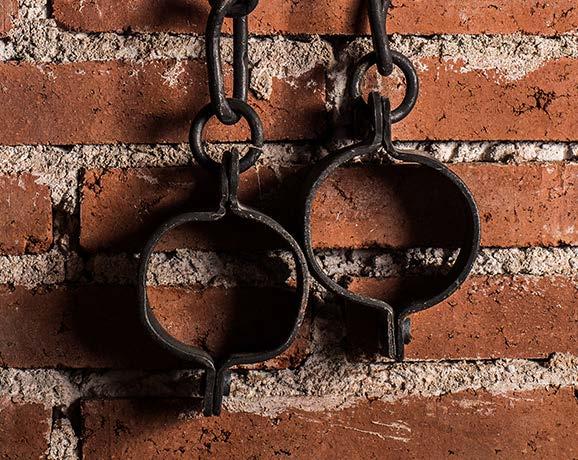
In his Editor’s Message, Dr. Leap discusses the outpouring of frustration with the US healthcare system that followed the murder of the UnitedHeath CEO in New York. And while the feeling of frustration is justified, by patients and physicians alike, we can work to make the system better. That’s what AAEM has always done and continues to do.
13
The Business of Emergency Medicine: Part One: The Basics

Following the introduction of the commitment to educating AAEM members on the business side of emergency medicine, Dr. Frolichstein follows up his President’s Message with the first installment of “The Business of Emergency Medicine” article series. This first article focuses on the basic business model of EM.
23 Critical Care Medicine Section: Redefining Preoxygenation Practices One Breath at a Time
Clinical practice guidelines are evolving, aligning with an expanding body of evidence that supports NIPPV and HFNC as important preoxygenation strategies for airway management. In this article, Drs. Owodunni and Gordon discuss how integrating NIPPV into our standard practice is no longer just advantageous, but exigent as we take a decisive step toward optimizing outcomes..

Tired. Long shift. Just discharged four patients from the ED and five more checked in on an otherwise blasé Saturday night. Some sniffles. A case of mild diarrhea. An earache. Dental pain in a meth addict. Vanilla cases really. “Gunshot! Gunshot!”
38
Pain and Addiction Committee: A Multi-State Solution to Linking People with Substance Use Disorder to High Quality Treatment
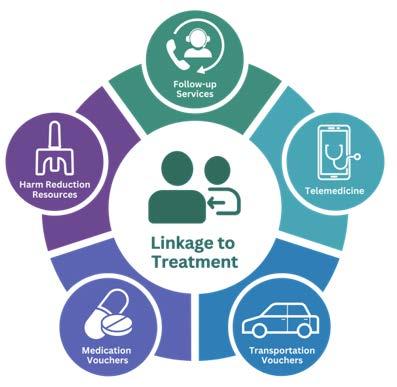
Why is linking patients with opioid use disorder to high-quality treatment so challenging? Do you face these same challenges? If you do, read this article to learn more about the development and optimization of Medication for Addiction Treatment and Electronic Referrals (MATTERS), a multi-state linkage, harm reduction, and telemedicine program!
Robert Frolichstein, MD FAAEM

The AAEM Board of Directors recently revisited and sharpened our strategic initiatives, reaffirming our commitment to education and advocacy as central pillars. These priorities, core to our mission, empower us to stand stronger as a collective. While we often focus on delivering world-class clinical education to enhance our bedside care, we are expanding our vision. Our board has made a critical addition to our education program: a commitment to teaching the business of emergency medicine.
Let me tell you why I think this matters.
Most emergency physicians never learned the fundamentals of business in medical school, residency, or even undergraduate studies. Sure, some of us have picked up knowledge from prior careers, personal interests, or through the gritty, hands-on experience of running a group practice. But for the majority of us, this knowledge gap is profound—and it’s costing us.
Here’s the hard truth—our lack of business understanding can leave us vulnerable.
Here’s the hard truth—our lack of business understanding can leave us vulnerable.
Vulnerable to being used. Vulnerable to being exploited. Vulnerable to having decisions made for us that prioritize someone else’s profits over our professionalism, our autonomy, and, ultimately, our patients’ well-being.”
Vulnerable to being used. Vulnerable to being exploited. Vulnerable to having decisions made for us that prioritize someone else’s profits over our professionalism, our autonomy, and, ultimately, our patients’ well-being.
As professionals, we provide a vital service, and we deserve to be compensated fairly and fully for it. Imagine asking your neighborhood teenager to mow your lawn. You agree on a price, the work gets done, and you pay the teen directly. Simple, fair, and transparent.
Now compare that to emergency medicine. The patient isn’t the payer, the one who receives
payment isn’t the physician, and the compensation is mediated by layers of complexity— insurance companies, physician groups both large and small, RCM companies, etc. Each of these parties is taking a piece of the pie. And too often, we don’t know how big that pie was in the first place.
This system thrives on lack of understanding. When emergency physicians fail to understand the business of our profession, we make it easy for others to profit off our work. This isn’t just about dollars; it’s about power, autonomy, and the essence of what it means to be a professional.

Emergency physicians often focus on their hourly pay without understanding how it relates to the revenue they generate. A company will always aim to offer a rate that ensures their profits. That’s business. Many of these companies don’t share the excess revenue (profit) you generate beyond your hourly expense. In groups not equally owned by physicians, this surplus often disappears into the pockets of corporate executives and shareholders.
And if your hourly rate seems inexplicably high, ask yourself—why? What’s being sacrificed elsewhere? Is your autonomy being traded for that paycheck?
Unlike other specialties, emergency medicine practices don’t have the overhead of maintaining clinical offices, making our operational costs relatively low. Yet, some groups charge physicians exorbitant fees for services like malpractice insurance or revenue cycle management. I’ve seen contracts where malpractice insurance is billed at two and a half times its actual cost.
Where does the extra money go? It’s not going to you. This is money siphoned off your hard work, and unless you understand these expenses, you won’t even realize it’s happening.
When outside entities profit from your labor without respecting your role as a professional, you’re no longer a physician—you’re a ‘provider.”
Here’s what’s at stake: your professionalism. When outside entities profit from your labor without respecting your role as a professional, you’re no longer a physician—you’re a “provider.” You lose control over your clinical and business decisions.
Autonomy is not just a privilege—it’s a responsibility. As professionals, we must make decisions that serve our patients’ best interests without interference. But autonomy requires knowledge—business knowledge—to ensure that no outside entity can exploit our labor or dictate our priorities.
This is a plea to every emergency physician: learn the business of emergency medicine. Understand how your revenue is generated, where it goes, and what is taken from you along the way. Arm yourself with the knowledge to demand transparency, fairness, and respect.
This isn’t just about protecting your paycheck— it’s about reclaiming your profession. It’s about standing up for your autonomy, your dignity, and your patients. It’s about refusing to let others profit from your ignorance. This is a long and difficult battle and we must arm ourselves with as much knowledge as we can.
Start today. Read the accompanying article in Common Sense on page 13. Educate yourself, ask questions, and hold those who profit from your labor accountable. This knowledge is your power. Use it to fight for the profession you deserve and the patients who depend on you.

Edwin Leap II, MD FAAEM
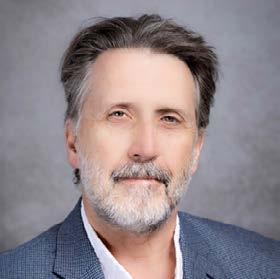
When Brian Thompson, UnitedHealth CEO, was murdered in New York City, the response was unsettling to say the least. Across the country, the execution-style killing was praised as an act of revolution. It was described as a justified and well-deserved example of vigilante justice. People in New York dressed up like Luigi Mangione, the killer, in celebration of his actions. He was viewed by many as a kind of odd sex symbol, not unlike the response to the surviving Boston Marathon bomber, Dzhokhar Tsarnaev, who was featured on the cover of Rolling Stone. In the wake of this, some even started publishing “hit lists” of other corporate CEOs who they thought might also deserve murder.
People are unpredictable. And certainly, a national sense of frustration with the high cost of healthcare and the role of insurance in that cost, clearly led to much of the outpouring of sympathy, not for the dead but for the murderer.
What bothered me most, though, was the general response by physicians, and especially emergency physicians, posting comments online. The things I read were disturbing.
“I feel bad for his family, but not for him.”
“He deserved it.”
“He was a mass murderer anyway.”
“He killed tens of thousands of people.”
Now, one of the things we seem to pride ourselves on as a specialty is our willingness to accept and treat everyone. We do this whether they are in suits or shackles, whether they are saints or sinners. We try to understand and show kindness to those who exhibit all sorts of behavior that we can’t personally understand. And, I applaud this. In fact, some of my favorite patients have come to me in orange jumpsuits, laughing with the police who escorted them.

[O]ne of the things we seem to pride ourselves on as a specialty is our willingness to accept and treat everyone. We do this whether they are in suits or shackles, whether they are saints or sinners.”
How many times have we had discussions about whether or not we should cooperate with police by obtaining drug screens, alcohol levels, or with the sedation of aggressive patients? How many times have people in our specialty rallied to defend the homeless, the addicted, the undocumented immigrant?
Of all specialties, we subscribe to a very deeply American idea, which is that everyone deserves care and everyone is “innocent until proven guilty.” And even when they are guilty, we see them as patients in our care, not enemies to be allowed to suffer. We understand that to treat people this way is not to approve all of their actions, but to recognize their humanity.
But not so Brian Thompson. Mr. Thompson was a very wealthy man, albeit one who came from fairly humble beginnings. Mr. Thompson represented an industry that is problematic—health care is expensive and so is health insurance. Insurance companies often deny care to those who need it. People, real people, do suffer when they cannot get the care they need. They
also die. (As an aside, this happens in countries with nationalized care as well, but that’s for another discussion.)
Still, I think that the response to the killing of Thompson was over the top. It seemed, to me, shameful and cruel. Not because I know anything about the man—I never met him, nor anyone in his family. But because I would say the same thing about anyone killed in cold-blood and accused of things like “mass murder” without ever having been arrested, charged, tried, or sentenced for the killings he was accused of so cruelly (and personally) orchestrating.
I also think that the response neglects another important reality. Luigi Mangione, if convicted, will likely spend the rest of his life in prison if he doesn’t receive the death penalty. In making him the proxy for national anger over healthcare, he has been consigned to a radically altered and possibly shortened life. He has, as it were, “the mark of Cain.” It’s hard to scrub that off. I am sad for >>
We can be frustrated with the system. And we can work to make it better. That’s exactly what AAEM has always done and continues to do.”

Brian Thompson and his family. And as a father, I am sad for Luigi Mangione and those who love him as well.
We can be frustrated with the system. And we can work to make it better. That’s exactly what AAEM has always done and continues to do. We do our research, we advocate, we pursue policy changes, we speak truth to power. Those physicians with incisive minds, who understand complex economic issues, can look at the data and find the places where change needs to happen for the good of our patients and the good of our profession.
However, the hard reality is that American healthcare economics is wildly complex. There is no easy explanation for high costs. It is unfair, inappropriate, and immoral to apply all of our collective frustration and venom on Brian Thompson, or to allow Luigi Mangione to be our unofficially sanctioned angel of justice. Particularly when he himself admitted that he did not understand the system he was railing against.
The rules, incentives, policies, and costs of American healthcare are a mixture of market forces, individual behaviors and government
regulations that make snake venom seem like a simple chemical. Unraveling all of this, or, to continue the metaphor, creating an antivenin, may be the work of a lifetime. But murder solves none of it. And celebration of murder only diminishes us as individuals and as a profession.
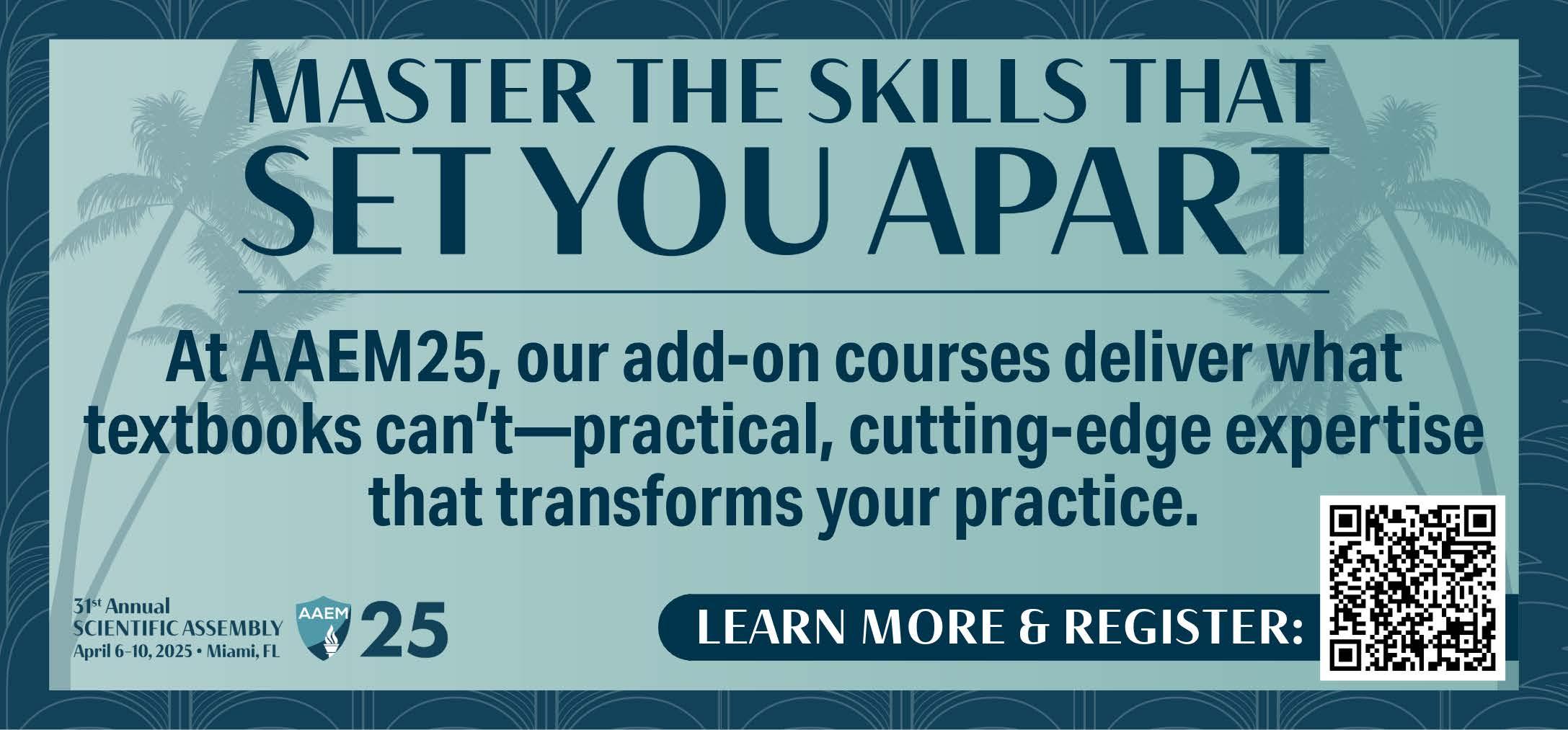
Loice Swisher, MD MAAEM FAAEM
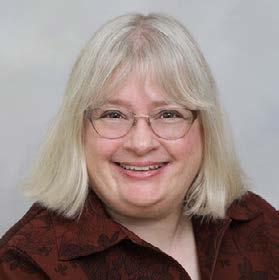
Yes—it is the holidays. More and more colored lights start to twinkle in the evening. A growing herd of reindeer take over lawns. Candles do gleam from inside. Old familiar Christmas songs fill the air so I sing along, “May your New Year dreams come true.”
But for me, this time of year is not about frosted window panes or painted candy canes.
Eight years ago, sitting comfortably at the first FIX conference chatting to the person next to me waiting for the next speaker to start, I had no idea that this season would become something else for me. Within minutes, continuous googling started. The presenter’s slides revealed something that somewhere deep inside I knew was true. However, seeing it in a huge bar graph on the screen brought the injustice into the light.
Was this also true of the organization I was most involved with? Would I be able to find that out? Is there information online? Has anyone ever looked at this before? Questions swirled in my mind as my fingers demanded answers from the screen on my phone. My justice-seeking brain engaged.
The injustice—women won much, much fewer awards than men from that national emergency medicine organization. The point was undisputable looking at the graph. However, it was not the group which I worked with the most. Was it true with mine?
My heart sank. Opening up the page of award winners, the first award had zero female names. Trying to explain this away to myself—it was a newer award. It started in 2012 and this was only 2017. The next award had started earlier. Of the 16 names, only two were women. Perusing over the third award honorees there were zero women. The next award only two of 19. Each page opening brought the same paltry results.
It was true. Just like the cousin organization, we did not recognize women’s contributions with awards. What was that about? Was it that women weren’t as involved? Were those award descriptions not for “women’s work”? Was it that women just were not recognized for their contributions?
A Nashville story drifted into my mind. Standing on the stage of the Ryman Auditorium in the Mother Church of country music, our tour guide smiled regaling the story of Patsy Cline. Having seen men constantly being inducted into the Grand Ole Opry family, Patsy walked up to Little Jimmy Dickens requesting to be inducted too. It seems the request was granted virtually immediately with no question. Just hadn’t been thought of before. Patsy Cline remains the only member to join the family by request.
Not long after I was at a meeting with a past president. Sneaking in a “by the way” question, I asked in his four years on the executive board how many women’s names he remembered came in for awards nominations. None. He remembered none.
There was our problem. Women can’t win awards if they are not put in for them. It seemed women didn’t throw their own hat in the ring. In addition, others don’t throw women’s hat in the ring either.
However, there was the answer too. Nominate women for awards. The rules are any voting member can nominate members for awards. I could do that. The only barrier was I had not paid attention enough to know what the awards were for or who might qualify. I was one of those members who did not consider myself a potential nominee or nominator. I failed to recognize women in exactly the way the speaker said.
So, it’s that time of year. It is the time for award nominations. It is my “Patsy Cline season” when I ask the board to recognize members
remembered for what they do.”
who have done great, potentially unseen or unrecognized, work for our Academy. I will put more than one name in for an award nomination if they qualify.
To be fair to men, I don’t see this as a malebased problem. I don’t think most men of the organization nominate anyone. A difference is more men will either self-nominate or ask a friend to nominate them.
Each year I specifically go looking for women who qualify for the award. I want women to be seen and remembered for what they do. I search the leadership of every committee and state chapter. I re-read newsletters. I ask opinions of other members. Then I write nominations.
In the seven years between 2018 in San Diego to 2024 in Austin, there have been an additional
27 female AAEM awards to add to the 12 in the initial 17 years. There is no award without a women honoree. The percentage reflects our Academy: 36%.
Before anyone gets upset, I want to be clear. I am not against men receiving AAEM awards. I have nominated more men for Master of AAEM and the McNamara Award than women. I nominate qualified AAEM members. More men have asked me to write nominations for them. Thus, I put more effort in my search to recognized AAEM women.
I am proud of AAEM for the changes. I am proud that I as one member could really make an impact. My new year dream is that others will see this and nominate people that inspire them from our Academy.
Introducing the AAEM and AAEM/RSA Events Calendar — your go-to source for conferences, webinars, workshops, and more.
Explore the latest opportunities to connect, learn, and grow in emergency medicine by scanning the QR code.
AAEM Events
31st Annual Scientific Assembly
April 6-10, 2025 (Miami, Florida) https://www.aaem.org/aaem25/
XIIIth Mediterranean Emergency Medicine Congress August 14-17, 2025 (Budapest, Hungary) emcongress.org/
2025 Oral Board Review Courses aaem.org/education/oral-boards/ Registration to Open Mid-February 2025.
Jointly Provided
Re-Occurring Monthly Spanish Education Series*
Jointly provided by the AAEM International Committee https://www.aaem.org/committees/international/spanish-education-series/ (CME not provided)
Re-Occurring Monthly
Unmute Your Probe Season 4
Jointly provided by the Emergency Ultrasound Section of AAEM (EUS-AAEM) https://www.aaem.org/get-involved/sections/ eus/resources/unmute-your-probe/
February 24-28, 2025
44th Annual Emergency Medicine Winter Conference
Jointly provided by UC Davis Health Recommended Online CME
Recognizing Life-Threatening Emergencies in People with VEDS thesullivangroup.com/TSG_UG/VEDSAAEM/ 2025 Oncologic Emergency Medicine Conference – Past, Present, and Future February 7-8, 2025 (Houston, TX) mdanderson.cloud-cme.com/course/ courseoverview?P=5&EID=41528
The Difficult Airway Course: EmergencyTM May 2 - 4, 2025 (Boston, MA); May 30 - June 1, 2025 (Orlando, FL); September 19 - 21, 2025 (Denver, CO); November 14-16, 2025 (San Diego, CA) theairwaysite.com/a-course/ the-difficult-airway-course-emergency/
Explore AAEM CME Online, where we understand the fast-paced nature of emergency medicine (EM) and the need for concise, accessible education. This platform is designed to provide members of the American Academy of Emergency Medicine (AAEM) and AAEM Resident and Student Association (AAEM/ RSA) with top-tier continuing medical education (CME) resources right at their fingertips. Access today!
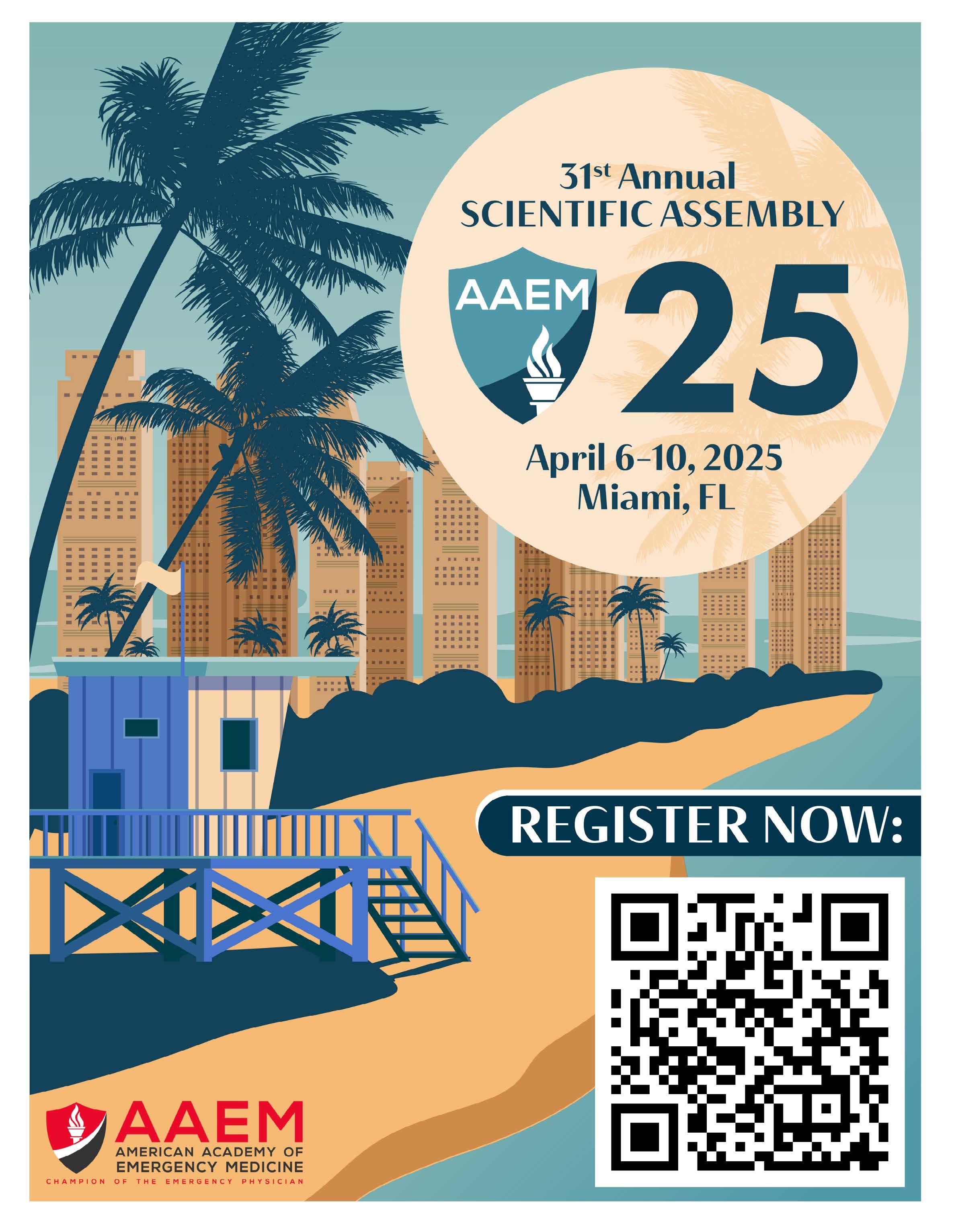
AAEM established its Foundation for the purposes of (1) studying and providing education relating to the access and availability of emergency medical care and (2) defending the rights of patients to receive such care and emergency physicians to provide such care. The latter purpose may include providing financial support for litigation to further these objectives. The Foundation will limit financial support to cases involving physician practice rights and cases involving a broad public interest. Contributions to the Foundation are tax deductible. Levels of recognition to those who donate to the AAEM Foundation have been established. The information below includes a list of the different levels of contributions. The Foundation would like to thank the individuals below who contributed from 1/1/2024 to 1/1/2025.
Contributions $1000 and above
Bruce M. Lo, MD MBA RDMS FAAEM
David W. Lawhorn, MD MAAEM
Frank L. Christopher, MD FAAEM
Fred Earl Kency, Jr., MD FAAEM FACEP
Jonathan S. Jones, MD FAAEM
Kimberly M. Brown, MD MPH FAAEM
Kraftin E. Schreyer, MD MBA FAAEM
Peter G. Anderson, MD FAAEM
Robert A. Frolichstein, MD FAAEM
Robert P. Lam, MD FAAEM
Tom Scaletta, MD MAAEM FAAEM
Contributions $500-$999
Charles Chris Mickelson, MD FAAEM
Daniel F. Danzl, MD MAAEM
Eric D. Lucas, Sr., MD FAAEM
Glenn I. Goodwin, DO FAAEM
Jane D. Scott, Former NHLBI
Julianne Wysocki Broadwater, DO FAAEM
Leonard A. Yontz, MD FAAEM
Lillian Oshva, MD FAAEM
Nate T. Rudman, MD FAAEM
Travis J. Maiers, MD FAAEM
William E. Franklin, DO MBA FAAEM
Contributions $250-$499
Alex Alers Fuentes, MD FAAEM
Benjamin D. Walrath, MD MPH FAAEM FAEMS
Bruce E. Lohman, MD FAAEM
Catherine V. Perry, MD FAAEM
Charlotte A. Ransom, MD FAAEM
Christopher R. Grieves, MD FAAEM
David C. Crutchfield, MD FAAEM
David S. Rosen, MD MPH FAAEM
Deborah D. Fletcher, MD FAAEM
Eric W. Brader, MD FAAEM
Garrett Clanton II, MD FAAEM
James J. Schlesinger, DDS MD
Jonathan D. Apfelbaum, MD FAAEM
Joseph M. Reardon, MD MPH FAAEM
Joseph T. Bleier, MD FAAEM
Joshua J. Faucher, MD FAAEM
Karl A. Nibbelink, MD FAAEM
Kathleen P. Kelly, MD FAAEM
Kevin Allen, MD FAAEM
Kian J. Azimian, MD FAAEM
Laura J. Bontempo, MD MEd FAAEM
Lauren LaRoche, MD FAAEM
Mark D. Thompson, MD FAAEM
Mary Ann H. Trephan, MD FAAEM
Michael Luszczak, DO FAAEM
Oscar A. Marcilla, MD FAAEM
Patrick A. Aguilera, MD FAAEM
Salvador Villanueva, MD FAAEM
Scott P. Marquis, MD FAAEM
Steven Schmidt
Teresa M. Ross, MD FAAEM
Contributions $100-$249
Alexander Tsukerman, MD FAAEM
Alexandra Terskiy, MD PhD FAAEM
Azalea Saemi, MD FAAEM
Benjamin Kober, DO FAAEM
Bradley K. Gerberich, MD FAAEM
Brian R. Potts, MD MBA FAAEM
Carlos F. Garcia-Gubern, MD FAAEM
Chad J. Hansen, MD FAAEM
Chaiya Laoteppitaks, MD FAAEM
Christopher M. Tanner, MD FAAEM
Clayton Ludlow, DO FAAEM
Daniel T. McDermott, DO FAAEM
David R. Hoyer Jr., MD FAAEM
David R. Steinbruner, MD FAAEM
Don L. Snyder, MD FAAEM
Donald L. Slack, MD FAAEM
Eric J. Muehlbauer, MJ CAE
Eric S. Kenley, MD FAAEM
Ernest L. Yeh, MD FAAEM FAEMS
Jalil A. Thurber, MD FAAEM
Jeffrey A. Rey MD, MD FAAEM
John R. Matjucha, MD FAAEM
John Stroh Jr., FAAEM
John Tobias Nagurney, MD MPH FAAEM
Jorge L. Infante, MD FAAEM
Joseph Roarty, MD FAAEM
Julian G. Mapp, MD MBA MPH FAAEM
Katrina Kissman, MD FAAEM
Keith D. Stamler, MD FAAEM
Kevin C. Reed, MD FAAEM
Kevin Robert Brown, MD FAAEM
Marianne Haughey, MD FAAEM, MAAEM
Mark A. Antonacci, MD FAAEM
Mark A. Foppe, DO FAAEM FACOEP
Mark A. Newberry, DO FAAEM FPD-AEMUS
Mark E. Zeitzer, MD FAAEM
Mary Jane Brown, MD FAAEM
Matthew B. Underwood, MD FAAEM
Michael L. Martino, MD FAAEM
Michael M. Dickerson, MD FAAEM FAPWCA
Michael Timothy Schultz, MD FAAEM
Nancy L. Kragt, DO FAAEM
Nicholas Boyko, DO FAAEM
Paul M. Clayton, MD FAAEM
Paul W. Gabriel, MD FAAEM
R. Lee Chilton III, MD FAAEM
Ramon H. Nunez, MD FAAEM
Robert Bruce Genzel, MD FAAEM
Robert E. Gruner, MD
Robert J. Feldman, MD FAAEM
Rosa K. Gigliotti, MD FAAEM
Saba A. Rizvi, MD FAAEM
Sarah B. Dubbs, MD FAAEM
Scott D. Reiter, MD FAAEM
Stephanie Eden, MD FAAEM
Stuart M. Gaynes, MD FAAEM
Susan T. Haney, MD FAAEM FACEP
Tim J. Carr, FAAEM
Vinicius Knabben, MD
William E. Swigart, MD FAAEM
William K. Clegg, MD FAAEM
William Peter Kehr, MD FAAEM
William T. Freeman, MD FAAEM
Yamila Vazquez-Gonzalez, MD FAAEM
Yedidiach Ortiz Gonzalez, MD, MPH, FACEP
Contributions up to $99
Adam Hill, MD FAAEM
Amanda Dinsmore, FAAEM
Ameer Sharifzadeh, MD FAAEM
Andrew M. Flanagan, DO FAAEM
Anthony Catapano, DO FACOEP FAAEM
Anthony J. Buecker, MD FAAEM
Brian Gacioch, FAAEM
Brian Knight
Dan M. Mayer, MD FAAEM FACEP
Daniel Luis Puebla, MD
David I. Arbona-Calderon, MD FAAEM FACEP FAEMS
Dylan M. Hendy, DO FAAEM
Edward T. Grove, MD FAAEM MSPH
Eric J. Schwiger, DO FAAEM
Eric M. Ketcham, MD MBA FAAEM FASAM
Gabriel Ochoa, MD FAAEM
Irving Jacoby, MD FAAEM
James P. Alva, MD FAAEM
Jon J. Carpenter, MD
Justin L. Berkowitz, DO FAAEM
Katherine Ryan, MD FAAEM
Kevin Barber, FAAEM
Laura Harvey, DO FAAEM
Lawrence Mendiola, DO FAAEM
Michael Loesche, MD, PhD
Michael O’Neil, MD FAAEM
Moath Amro, MD
Neal Handly, MD
Neil Gulati, MD FAAEM
Noel T. Moore, MD FAAEM
Patrick W. Daly, MD FAAEM
Paul Chester Jesionek, MD FAAEM
Peter H. Hibberd, MD FACEP FAAEM
Regan Wylie, MD FAAEM
Rex Villanueva, DO FAAEM
Rian Pillitteri, MD FAAEM
Ric Roc
Russell L. Reinbolt, MD FAAEM
Scott Beaudoin, MD FAAEM
Stephanie A. Ayala, DO
Stephen P. Stewart, MD FAAEM
Tabitha Williams, FAAEM
Thomas J. Grosheider, MD FAAEM
Tina F. Edwards, FAAEM
Vanessa C. Hannick, MD FAAEM
Vincent K. Huynh
Virgle O. Herrin Jr., MD FAAEM
Walter M. D’Alonzo, MD FAAEM
Yeshvant Talati, MD

AAEM PAC is the political action committee of the American Academy of Emergency Medicine. Through AAEM PAC, the Academy is able to support legislation and effect change on behalf of its members and with consideration to their unique concerns. Our dedicated efforts will help to improve the overall quality of health care in our country and to improve the lot of all emergency physicians.
All contributions are voluntary and the suggested amount of contribution is only a suggestion. The amount given by the contributor, or the refusal to give, will not benefit or disadvantage the person being solicited.
Levels of recognition to those who donate to the AAEM PAC have been established. The information below includes a list of the different levels of contributions. The PAC would like to thank the individuals below who contributed from 1/1/2024 to 1/1/2025.
Contributions $1000 and above
Fred Earl Kency, Jr., MD FAAEM FACEP
Mark S. Penner, DO FAAEM
Contributions $500-$999
Julianne Wysocki Broadwater, DO FAAEM
Contributions $250-$499
Bruce E. Lohman, MD FAAEM
Daniel F. Danzl, MD MAAEM
Eric W. Brader, MD FAAEM
Joseph M. Reardon, MD MPH FAAEM
Mark D. Thompson, MD FAAEM
Peter G. Anderson, MD FAAEM
Robert A. Frolichstein, MD FAAEM
Steven Schmidt
Travis J. Maiers, MD FAAEM
Contributions $100-$249
Alexander Tsukerman, MD FAAEM
Brian R. Potts, MD MBA FAAEM
Catherine V. Perry, MD FAAEM
Chaiya Laoteppitaks, MD FAAEM
Cynthia Martinez-Capolino, MD FAAEM
David R. Hoyer Jr., MD FAAEM
David R. Steinbruner, MD FAAEM
Emile El-Shammaa, MD FAAEM
Eric M. Ketcham, MD MBA FAAEM FASAM
Garrett Clanton II, MD FAAEM
Jalil A. Thurber, MD FAAEM
Jeffrey A. Rey MD, MD FAAEM
John Stroh Jr., FAAEM
Jorge L. Infante, MD FAAEM
Joseph T. Bleier, MD FAAEM
Julian G. Mapp, MD MBA MPH FAAEM
Katrina Kissman, MD FAAEM
Lillian Oshva, MD FAAEM
Mark A. Foppe, DO FAAEM FACOEP
Matthew B. Underwood, MD FAAEM
Nate T. Rudman, MD FAAEM
Nicholas Boyko, DO FAAEM
Paul M. Clayton, MD FAAEM
R. Lee Chilton III, MD FAAEM
Ramon H. Nunez, MD FAAEM
Robert Bruce Genzel, MD FAAEM
Rosa K. Gigliotti, MD FAAEM
Scott P. Marquis, MD FAAEM
Stephanie Eden, MD FAAEM
Steven Parr, DO FAAEM
Stuart Meyers, MD FAAEM
Vinicius Knabben, MD
William T. Freeman, MD FAAEM
Zachary J. Sletten, MD FAAEM
Contributions up to $99
Adam Hill, MD FAAEM
Alex Kaplan, MD FAAEM
Amanda Dinsmore, FAAEM
Ameer Sharifzadeh, MD FAAEM
Anthony Catapano, DO FACOEP FAAEM
Brian Gacioch, FAAEM
Donald L. Slack, MD FAAEM
Elizabeth Lojewski, DO FAAEM
James P. Alva, MD FAAEM
Justin L. Berkowitz, DO FAAEM
Kevin C. Reed, MD FAAEM
Laura Harvey, DO FAAEM
Lawrence Mendiola, DO FAAEM
Marc D. Squillante, DO FAAEM
Neil Gulati, MD FAAEM
Patricia Phan, MD FAAEM
Peter H. Hibberd, MD FACEP FAAEM
Peter M.C. DeBlieux, MD FAAEM
Stuart M. Gaynes, MD FAAEM
Thomas A. Richardson, MD
Tina F. Edwards, FAAEM
Contributions $1000 and above
Fred Earl Kency, Jr., MD FAAEM FACEP
Jonathan S. Jones, MD FAAEM
Contributions $250-$499
Alex Alers Fuentes, MD FAAEM
Bruce E. Lohman, MD FAAEM
Catherine V. Perry, MD FAAEM
Dale S. Birenbaum, MD FAAEM
David W. Lawhorn, MD MAAEM
Eric W. Brader, MD FAAEM
Frank L. Christopher, MD FAAEM
Joseph T. Bleier, MD FAAEM
Kian J. Azimian, MD FAAEM
Lillian Oshva, MD FAAEM
Oscar A. Marcilla, MD FAAEM
Robert A. Frolichstein, MD FAAEM
William E. Hauter, MD FAAEM
The AAEM Institute for Leadership, Education & Advancement in the Development of Emergency Medicine, Inc. (LEAD-EM) was established after the tragic and unexpected death of AAEM president, Dr. Kevin G. Rodgers.
The Kevin G. Rodgers Fund and the Institute will LEAD-EM just like Dr. Rodgers did. The funds will support important projects such as development of leadership qualities, and clinical and operational knowledge of emergency physicians with a view toward improving and advancing the quality of medical care in emergency medicine, and public health, safety and well-being overall. LEAD-EM would like to thank the individuals below who contributed from 1/1/2024 to 1/1/2025.
Contributions $100-$249
Andrew Langsam, MD
Bradley K. Gerberich, MD FAAEM
Brian R. Potts, MD MBA FAAEM
Edward T. Grove, MD FAAEM MSPH
Eric S. Kenley, MD FAAEM
Jalil A. Thurber, MD FAAEM
Jeffrey A. Rey MD, MD FAAEM
John R. Matjucha, MD FAAEM
Julian G. Mapp, MD MBA MPH FAAEM
Julianne Wysocki Broadwater, DO FAAEM
Kailyn Kahre-Sights, MD FAAEM
Kevin C. Reed, MD FAAEM
Marc D. Squillante, DO FAAEM
Mark A. Antonacci, MD FAAEM
Mark A. Foppe, DO FAAEM FACOEP
Mark E. Zeitzer, MD FAAEM
Matthew B. Underwood, MD FAAEM
Paul W. Gabriel, MD FAAEM
Ronny Mario Otero, MD FAAEM
Rose Valentine Goncalves, MD FAAEM
Scott P. Marquis, MD FAAEM
William T. Freeman, MD FAAEM
Contributions up to $99
Anthony J. Buecker, MD FAAEM
Brandon H. Richardson
Casey Brock Patrick, MD FAAEM FAEMS
Chaiya Laoteppitaks, MD FAAEM
David A. Yacynych, MD
Eric M. Ketcham, MD MBA FAAEM FASAM
Gerald E. Maloney, Jr., DO FAAEM
Ivan C. Rokos, FAAEM
Jon J. Carpenter, MD
Jose G. Zavaleta, MD
Justin L. Berkowitz, DO FAAEM
Leah C. Harbison, MS
Mary Jane Brown, MD FAAEM
Neil Gulati, MD FAAEM
Nicole A. Outten
Paul Chester Jesionek, MD FAAEM
Paul M. Clayton, MD FAAEM
Robert E. Gruner, MD
Stuart M. Gaynes, MD FAAEM
Thomas A. Richardson, MD
Thomas G. Derenne
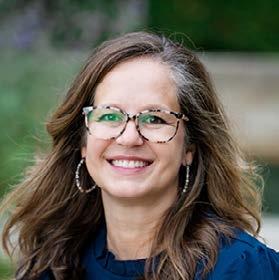
Amanda Dinsmore, MD, Kendra Morrison, DO, and Laura Cazier, MD
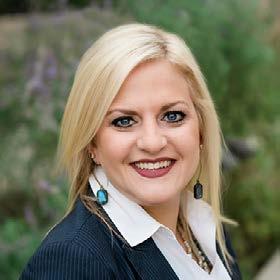
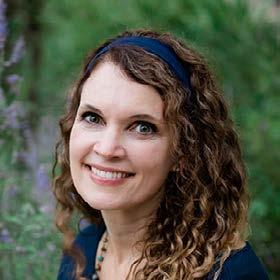
an you relate to this? When I was in third grade, the fifth graders seemed impossibly old. At age 15, I thought 20-year-olds were positively ancient. And let’s not forget the “29ers Club” members my college friends and I mercilessly mocked for hanging out in our peer group—didn’t those almost 30-year-old geezers have anything better to do than to socialize with students?
We were convinced we’d be “grown up” by 18 and fully developed adults by our mid-20s. After all, wasn’t that when the brain was supposed to stop developing?
Maturity is far more nuanced than we thought. While “immature” behavior—like cracking inappropriate jokes—might fade with time, paying bills, having kids, or even saving lives in the emergency department doesn’t automatically elevate us to the mythical status of “fully mature adult.” When we can hold down a job, pay a mortgage, and file our taxes, we increase the evidence of our maturity. Surely, when we have kids of our own, we have reached the pinnacle of adult maturity, right?
Not so fast.
In fact, adulthood often brings the humbling realization that maturity is a lifelong process, not a fixed state we can achieve.1 Even as experienced emergency physicians, most of us sometimes display emotional immaturity—whether it’s getting completely ticked off at a patient or trash-talking another physician.
It’s pretty eye-opening to realize that as a 40-something-year-old “grownup,” you still have a lot of maturing to do. This was me just a few short years ago. Today, I am comfortable knowing I still show up immaturely a good bit of the time, and I am consistently trying to “grow up.” When I was rolling along thinking I was as grown up as grown-up got, and then had the rude awakening that I was, in fact, still pretty immature—it was both humbling and transformational.
Perhaps you are already at the pinnacle of adult maturity. If so, you are in the minority. According to psychological research, there is no definitive answer to how many people reach full emotional maturity, but estimates suggest that only a small percentage, perhaps around 10-15% of the population, achieve a high level of emotional maturity during their lifetimes.
Maturity is multifactorial, highly complex, and difficult to measure.
Not surprisingly, psychological maturity is of great interest to psychologists. Decades of research have been done on the subject, but in 2024, a group of Turkish psychologists published research validating the development of an instrument to measure maturity.2 The Psychological Maturity Scale is a four-dimensional model for understanding psychological maturity, represented by the acronym SAFE, which stands for Self-Awareness, Autonomy, Flexibility, and Ego Resilience.
Self-Awareness: Knowing
Self-awareness is the foundation of emotional maturity. It’s about understanding our needs, strengths, weaknesses, and motivations—and using that insight to guide our actions.
• Mature Behavior: I recognize that my irritation stems from personal exhaustion rather than a nurse’s delayed response, and I adjust my tone accordingly. (It’s my problem, not hers.)
• Immature Behavior: Snapping at a team member without considering my emotional state or its impact on others.
Traits of self-aware persons include:
• Awareness of personal desires and needs.
• Recognizing strengths and weaknesses.
• Identifying what is within our control and striving to improve our negative traits.3
Autonomy is the ability to make decisions confidently, set boundaries, and act in alignment with our values. For physicians, autonomy can mean being clear with an argumentative consultant or addressing workplace dynamics constructively.
• Mature Behavior: Politely declining an unreasonable request (can’t you just put that four-year-old with the dog-bite-shredded legs back together yourself in the ED?) while maintaining professionalism. (“No, Dr. Plastics, you need to take her to the OR. See you soon. Thanks.”)
[E]stimates suggest that only a small percentage, perhaps around 10-15% of the population, achieve a high level of emotional maturity during their lifetimes.”
• Immature Behavior: Agreeing to a task out of guilt or fear, then complaining to colleagues later. (“I spent two hours sewing that kid up, and she screamed the whole time!”)
Can I set boundaries in relationships and work environments, and do I make decisions based on my own values rather than external pressures?
>>
Flexibility is the capacity to see situations from different perspectives, acknowledge human error, and adapt to changing circumstances.4 In the ED, flexibility can mean handling unexpected complications with grace.
• Mature Behavior: Taking constructive criticism from a colleague, considering its validity, and adjusting our approach if necessary.
• Immature Behavior: Brushing off feedback as irrelevant or reacting defensively to protect our egos.
Flexible individuals tend to:
• Strive to understand events without bias or prejudice.
• Acknowledge that mistakes are part of life.
• Evaluate situations from multiple perspectives.
When things go wrong, do I pause to consider different perspectives, or do I dig in my heels?
Ego resilience is the ability to face adversity with composure, adapt to challenges, and persevere without giving up. In the ED, where chaos is the norm, this skill often separates effective physicians from overwhelmed ones.
• Mature Behavior: A physician who calmly triages patients during a sudden bolus in critical cases demonstrates ego resilience. They approach problems head-on and adapt creatively to resource limitations.
• Immature Behavior: In contrast, a colleague might avoid confronting the problem, leaving their team to pick up the slack while they vent frustrations.
Key traits of ego resilience include:
• Coping effectively with losses or sudden challenges.
• Persevering through difficulties without giving up.
• Approaching problems directly rather than avoiding them.
Do I believe the challenges I face are a normal part of the flow of life, and do I cope with them accordingly?
Psychological maturity isn’t just a personal virtue—it’s a professional necessity. As physicians, we’re entrusted with the physical and emotional well-being of others, often under extreme pressure. Maturity affects
References
1. Infurna FJ. Utilizing Principles of Life-Span Developmental Psychology to Study the Complexities of Resilience Across the Adult Life Span. Gerontologist. 2021 Aug 13;61(6):807-818. doi: 10.1093/ geront/gnab086. PMID: 34387342.
2. Eryılmaz A, Uzun AE. Embarking on the SAFE Route: Exploring the Psychological Maturity Scale. Alpha Psychiatry. 2024 Jan 1;25(1):101-110. doi: 10.5152/alphapsychiatry.2024.231453. PMID: 38799493; PMCID: PMC11114205.
everything from how we interact with patients and colleagues to how we cope with the inevitable challenges of the job. But perhaps most importantly, research shows that as the level of our psychological maturity increases, so does our well-being and life satisfaction.
[G]rowing up is a journey, not a destination…It’s okay if it takes a long time to get there and stay there.”

Growing up doesn’t mean losing our sense of humor. These days, for me at least, maturity is acknowledging my immaturity with a laugh—like when I get riled up at a patient’s bossy parent or try to give my nurse practitioner unsolicited life advice. I’ll sometimes call out my own immaturity and we all get a good laugh about it. In these moments, I remind myself that growing up is a journey, not a destination.
So, fellow BAFERDs, if you are on your own journey of “growing up,” the SAFE framework can be a valuable guide to becoming better doctors and better humans. Following it can lead us to better relationships and a better life. And we can still laugh and have fun. Actually, we’ll have even more fun when we can consistently show up in a mature, calm, regulated way. Being a grown-up is awesome. It’s okay if it takes a long time to get there and stay there. After all, we’re all still growing up.
3. Berenstain LK, Markowitz SD, Byerly SI. Physician Coaching. Anesthesiol Clin. 2022 Jun;40(2):337-348. doi: 10.1016/j. anclin.2022.01.007. Epub 2022 May 7. PMID: 35659405.
4. Perrella A. Room for improvement: Palliating the ego in feedback-resistant medical students. Med Teach. 2017 May;39(5):555-557. doi: 10.1080/0142159X.2016.1254757. Epub 2016 Dec 9. PMID: 27934556.

Robert Frolichstein, MD FAAEM

Understanding the basic business model of a group of emergency physicians is important for several reasons. A general understanding will allow you to decide if you are being paid a reasonable wage for the service you provide. It will help you understand if the group is distributing revenue in a manner that is reasonable and fair. An understanding of the business model will make it more likely that you will notice if you are being taken advantage of. You will have an appreciation of the complexity of the model and be more comfortable paying money to someone to help run your business. Groups are better able to make informed decisions about physician coverage, judicious use of NP/PAs, night shift differentials, bonus money, vacations, family leave policy, and a host of other decisions groups will have to make. Let’s review the basics.
Just like any business you have money that comes in (revenue) and you have expenses associated with generating that revenue. Emergency medicine is a service industry and like most services those that furnish the service decide how much those services are worth and charge this amount to those that receive the services. This is when it gets messy. Unlike many services, there are a bunch of middlemen between the basic concept of furnish the service, charge for service, the recipient pays for that service. These middlemen are primarily insurance companies, the federal government and physician employers. The effect of these middlemen are a separation of the one who furnishes the service and the recipient of those services such that it destroys any natural market that could develop. Add to that already messy scenario the fact that emergency physicians are professionals and are best equipped to determine the needs of the patient—not the consumer. This framework is easy to corrupt. It is corrupted by the middlemen as they determine the payment of the service. It can be corrupted by the physician as they determine what services (care) the recipient (patient) receives. The physicians can be influenced by their employers, hospitals, pharmacy and even their own greed. Let’s review the revenue side of this business transaction.
The emergency physician (EP) that provides the service is obliged to charge for that service. This is typically a decision a group makes and all physicians within the group charge the same for similar services. EPs use their expertise to evaluate (history, physical, diagnostic testing, differential diagnosis, analysis of data) and manage (treatments, disposition, education). These are referred to as evaluation and management (E&M) charges. Additionally, EPs will occasionally perform procedures that warrant a separate charge that have a unique CPT code.
[H]aving a basic financial literacy empowers emergency physicians to advocate for themselves, avoid being taken advantage of, and contribute to the sustainability and success of their careers.”
These charges vary based on the complexity of the presenting problem and the management required. E&M codes typically generate 90% or so of a group’s revenue. Established federal guidelines (recently changed) help a physician decide what the E&M level should be for a given service. The codes for these charges are 99281, 99282, 99283, 99284, and 99285. A “level five” (99285) chart documents a more complex encounter than a level two chart. Additionally, emergency physicians will routinely provide critical care (99291).
It is the obligation of the physician to assign the appropriate E&M level to the patient encounter. This obligation is most often delegated to professional coding companies, most of which handle billing and collections. These revenue cycle management (RCM) companies have the relevant expertise and put many processes in place to assure physicians are getting paid appropriately for the work they have performed. If documentation does not exist that supports the charges, it is considered fraudulent. Government agencies exist to audit charts and determine if billing is being performed accurately.
Commonly EPs find it necessary to perform procedures on patients to restore their health or prevent further harm. Procedures such as laceration management and reduction of dislocated joints have a code that can be billed and paid in addition to the E&M service. Procedures typically make up about 10% of a group’s revenue. Proper documentation to support the indication and proper performance as well as describing the complexity of the procedure are needed.
This is where the story gets interesting and unique in the business world. Charges are determined by the physician and the bill is sent to one of three places.

Medicare and Medicaid make up the vast majority of federal payers. Each of these entities establish fee schedules indicating the payment for physician services. Every CPT code including 99928X has a predetermined amount of “allowable” to be paid to the physician that provided the service. This amount is determined by assigning a unit of work to each code. This unit of work is called a RVU. This fee schedule is updated regularly by the Center for Medical Services (CMS). Periodically they ask for and receive input from a team of physicians and other experts that is a subcommittee of the American Medical Association (AMA). This committee is called the Relative Value Scale Update Committee (RUC). A physician may see a patient in the emergency department and care for a sick patient and charge for a level five (99285) visit. The physician has established a charge of $500 for that visit. Medicare receives the charge, looks on their table and pays the physician $176.55. Medicaid will pay $101. The current Medicare payment schedule for E&M codes is 99282 - $42.02, 99283 - $72.18, 99284 - $121.32, 99285 - $176.55, 992919 (critical care) - $275.50
Insurance companies such as United, Aetna, etc, are, as a group, commonly referred to as commercial payers. In general, commercial payers pay significantly more per charge (E&M and procedures) than do Medicare and Medicaid. When discussing payments received from commercial payers it is common to discuss them in terms of a percentage of Medicare. There is not a formal tie between entities. You will often hear about Aetna paying 160% of Medicare for example. What they actually do pay usually has relatively little to do with the actual charge but rather whether you are in their network (participating in the insurance company network) or out of network (non-participating).
Insurance companies create networks of physicians. Their reported reason for doing so is to be able to direct their clients (our patients) to the best doctor. The actual reason they do this may be different but that is a discussion beyond the scope of this article. When a doctor is in network or participating that means the insurance company and the doctor have agreed upon what the doctor will accept as payment in full for the services they have provided to the patient. This negotiation is crucial and an area where the large groups have performed well in comparison to some smaller independent groups. The negotiations define a payment table for CPT codes (E&M services included) that is agreed upon by both parties. It may be that the payment table is based upon the Medicare table and so the contract may be for 180% of Medicare for all CPT codes. Rarely there are case rates where both parties agree for a fixed amount for all patients regardless of their E&M level and additional billable procedures. Even more rarely a physician may have an agreement to accept as payment a percentage of the physician charge. All of these scenarios would necessitate an agreement between the payer and physician to participate in the insurance companies’ network.
A physician (or group) may choose to not participate (non par) in an insurance company network and be out of network. Before the No Surprises Act (NSA) that went into effect in 2022, physicians charged a patient using their charge table and sent the bill to the insurance company. The insurance company did not have an agreement with the physician so they would pay the “usual and customary amount.” The physician could bill the patient directly for the uncovered portion, or balance, of the charge. The NSA now forbids the physician for billing the patient for the balance. A physician that choses to not participate in a payer network now bills the insurance company and the insurance company pays the physician an amount that is usual and customary (that they define) with no consideration of the charge for the service provided. If the physician does not agree with the payment there is a process for dispute resolution. The process is unfortunately expensive and time consuming. The process starts with an amount that takes into account the insurance companies stated rates for the service and is arbitrated from there. The process as it stands now is not consistent with the spirit of the law that was passed that expressly forbid using the payers usual and customary charge as the starting point.
The typical emergency physician will see many patients that have no insurance. We must see them and perform enough testing to determine that no emergency medical condition exists. This mandate stems from the EMTALA law and is unfunded. In general emergency physicians are proud that we see anyone at any time regardless of complaint or ability to pay. From a business perspective this mandate can have a significant negative effect. A physician may and typically does bill patients that have no insurance. The expected collection is 1-2% of billed charges.
Most if not all patients a physician will see in the emergency department will fall into one of the three categories described above. We know that collections received from insurance companies are higher than those that are received from federal or state payers and collections from self-pay patients is negligible. The relative proportion of patients in those classes has a huge impact on the overall collection rate for an emergency physician. The proportion is often referred to as a payer mix. For example, the payer mix may be 50% Medicare/Medicaid, 30% commercial and 20% self-pay. As an example, assume:
y Medicare average collection: $135/patient
y Commercial payer average collection: $225/patient
y Self-pay average collection: $10/patient
y Total annual patients: 20,000
The revenue is calculated using:
Revenue = (Medicare Patients × 135) + (Commercial Patients × 225) + (Self-Pay Patients × 10)
It is evident that a higher percentage of commercial and lower percentage of self-pay will result in a higher average collection per patient visit. An emergency physician can also track average collection per RVU. This average collection per visit (APV) or average collection per RVU is a key component of how much revenue an emergency physician (or group) receives.
The volume or number of patients seen and procedures performed will also significantly impact the overall revenue. The more patients per hour or shift a physician sees will dramatically impact the revenue per hour or shift. In emergency medicine, the number of patients seen per hour directly influences annual revenue. By understanding how variations in patient volume affect collections, physicians can better balance efficiency, workload, and financial outcomes. Below, we calculate annual revenue for a range of patient volumes, assuming an average collection of $150 per patient and a workload of 1,440 hours per year: Patients per Hour (PPH)
1.8 1.8 × 150 × 1440 = $388,800
2.0 2.0 × 150 × 1440 = $432,000
2.2 2.2 × 150 × 1440 = $475,200
2.4 2.4 × 150 × 1440 = $518,400
2.6 2.6 × 150 × 1440 = $561,600
2.8 2.8 × 150 × 1440 = $604,800

The emergency physician group must balance the desired hourly rate, the safety of patients, and the burden of work. Groups should make this decision with input of all physicians. It is not difficult to create a staffing plan and schedule that includes the groups desired workload (PPH), arrival pattern of patients, and the expected number of patients per day.
The business model of an emergency physician group is intricate and multifaceted. While the complexity of revenue generation, payer mix, and the impact of middlemen such as insurance companies and the federal government may seem daunting, it is crucial for physicians to have a basic grasp of how their work translates into revenue and how expenses are managed. Without this understanding, physicians may be vulnerable to unfair compensation practices or unfavorable contract terms. Armed with this knowledge enables physicians to participate actively in group decision-making and to recognize when financial practices may not align with their interests. It will allow EPs to critically evaluate advertised hourly rates and understand that some rate will exceed the expected revenue from the work that they do and ask the question—where is the money coming from? Ultimately, having a basic financial literacy empowers emergency physicians to advocate for themselves, avoid being taken advantage of, and contribute to the sustainability and success of their careers.


Alexandra Walton, MD
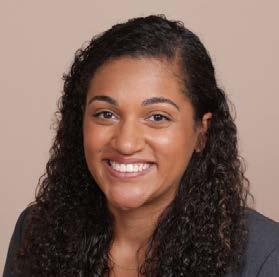
As I began the first few months of my final year of residency, I found myself in an unfamiliar position for the first time in over 13 years. The path in medicine had always been clear—college prerequisites, extracurriculars, medical school, and residency—yet now, for the first time, I found myself wondering: what’s next? I spent the majority of my 20s and early 30s working to attain the goal of becoming an emergency medicine physician. Now that I was reaching the end of that chapter, I had a sense of accomplishment and excitement to embark on my next journey but felt hesitant about moving forward.
I remember recently meeting up with my co-residents and future 2025 EM residency graduates following our program’s weekly conference. We sat in our hospital cafeteria chatting about our upcoming post-graduation plans. We were a rare class with most of us foregoing fellowship training to pursue full-time work in community hospitals. We were all in different stages of the job application process, some researching work within the Indian Health Services and many of us on the search for positions locally as well as out of state. While our conversation was filled with excitement, there was also some level of trepidation and fear of the unknown. Many of us felt a sense of exhaustion after nearing the completion of a grueling four-year residency program. I found that my classmates similarly felt overwhelmed by the decision to find the perfect job to fit their personalities and career goals.
As I embarked on my post-residency job search, I learned about many subtle differences in the ways that emergency departments are run in the community. When searching for jobs there are both technical questions to ask prospective employers but also social and personal nuances that may affect our satisfaction
As I began the first few months of my final year of residency, I found myself in an unfamiliar position for the first time in over 13 years…I found myself wondering: what’s next?”
with our jobs. This article shares my process in navigating the search for my first job in emergency medicine and I hope will make it a less daunting experience for others who are currently in the process of their job search.
As with most other times that I’ve entered into unfamiliar territory, I started by reaching out to my mentor. The first piece of advice he shared with me was simple: connect with people currently working in the field.
I learned that reaching out to both recent graduates and experienced emergency physicians is crucial for gaining valuable insights into what’s most meaningful when selecting a job. Recent graduates offered fresh perspectives on factors like work-life balance, growth potential, and balancing multiple part-time positions. More seasoned EM doctors shared lessons learned over time, emphasizing the importance of job stability, professional development, and aligning personal values with workplace culture. The more people I spoke with, the more I gained perspective on both the positive and negative aspects of working at various hospitals, locally and beyond. This allowed me to start to identify factors that were important to me in narrowing down my job search.
With guidance from faculty, friends, and recent graduates of my residency program, I created a list of what I was looking for in a job, drawing on insights from a career guidebook written by one of my program’s alumni.1 The first part of my list focused on factors I believed would foster a healthy work environment and support a good work-life balance, while the second part included more personal elements that I feel are essential for my happiness and well-being at work—things that help me feel fulfilled and energized. Although this list isn’t exhaustive—and the more I reflect, the more I could add—here are some of the main considerations I prioritized when evaluating potential job opportunities.
>>
How many shifts are required per month?
What are shift lengths?
How many nights and weekends are required per month?
Is the site a STEMI/Stroke/Trauma center?
What is the average number of patients per hour?
Average number of patient visits per year?
Which consultant services are available/not available?
What is the compensation?
What type of compensation? (ex: hourly, salary, RVU)
After formulating this list, I next focused on doing some background research about the hospitals in my area.
The hospital selection process of my job search felt relatively straightforward. Using search engines recommended by colleagues, I likened it to an apartment hunt on Zillow. I started by reviewing a map of hospitals within a 50-mile radius and narrowing down my options. I visited hospital websites to gather information about each emergency department and its services. Next, I reached out to friends to see if they knew anyone with past or present experience at those hospitals. I felt fortunate that the emergency medicine community is so tight-knit, making it easier to find connections at hospital sites. After making those connections, I asked if they could put me in touch with the department’s medical director.
Speaking with medical directors and touring emergency departments was one of the most
Is there a culture of support and collaboration among coworkers?
What is the patient population like?
Is there single-physician coverage?
What is the commute time?
What is the sign-out culture?
exciting parts of the process and allowed me to imagine myself working on my own. During these visits, I consciously evaluated the technical factors I had prioritized, such as patient volume, available resources, and shift schedules. However, I also paid close attention to my gut feeling while walking through the department. Did the space feel welcoming? Was there a sense of camaraderie among staff? Could I envision myself thriving in this environment? These intangible impressions often tipped the scales when I was torn between two otherwise comparable options.
Perhaps the most important realization for me was understanding that I don’t need to find the “perfect” or “lifetime” job immediately after residency. At this stage in my career, the priority is gaining diverse experiences, honing my clinical and professional skills, and finding what makes me happiest in a work environment. By keeping an open mind and allowing room for trial and error, I’ve embraced the idea that my first job is a steppingstone rather than a definitive destination.
As I’ve thought about my job plans for my first year after residency, I have had to take a step back to remind myself that completing residency training is a huge achievement. It represents the results of over a decade of hard work, dedication, and sacrifice. While the job search and planning can feel overwhelming, it is important to take time to reflect on our accomplishments. After years of training, it’s essential to embrace this milestone before diving into the next chapter of our careers.
1. Chioma Anaebere, T., MD. (2024). The Emergency Medicine Career Navigator: A Career Development Guide for the Emergency Medicine Resident Physician.
As I’ve thought about my job plans for my first year after residency, I have had to take a step back to remind myself that completing residency training is a huge achievement.”

Chris Tanner, MD FAAEM
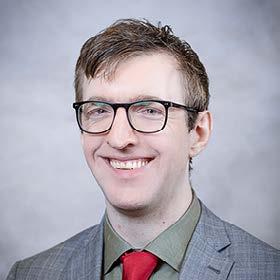
“Why are you going there? Your skills are going to atrophy.” My attending’s voice was thick with judgement. Despite his skepticism, the idea of going to a critical access hospital made sense to me. Thanks to my background as an EMT, I was familiar with the stress of being on my own caring for a patient. That experience had to be useful in a rural setting. Besides, there was money to be made. I would spend half my time working and the other half enjoying the city. I didn’t fully know what I was signing up for, after all, what new attending does?
It’s my first shift after finishing residency. I pull up to the ED, sun hanging high. Across the street horses meander as the waiting room fills. Within hours, I’m managing my first trauma patient. Shortly after, I’m dealing with a case of epiglottitis with an airway that is thankfully stable. Before long we have another pediatric airway with anesthesia driving in from their home. My old attending’s prediction that my skills will decay are unfounded.
I have only known the bustle of Chicago during my formative years. Why then would I choose a rural hospital? I had turned down an offer from a CMG after citing concerns about unsafe staffing and having to blindly cosign charts on patients I would not see or hear about. The hourly pay was low with the unguaranteed promise of bonuses. Meanwhile, a steak
dinner was all it took for many of my classmates to sign a bad contract our lawyer had analyzed. I understand why they made the choices they did. Especially as financially vulnerable new graduates. It was those discussions plus seeing the excess of these organizations at the ACEP scientific assembly that inspired me to learn more about AAEM.
After turning down the CMG job I was in a precarious situation. I was late in the hiring cycle and in desperate need of prospects. A car repair and anemic checking account added to the pressure. I found a better job with a great group in Chicago. Physician-led care and a better hourly rate for the city. Despite this I kept looking. I dug through my emails and found a job referral posted by an alumnus of our program (Go Browncoats!). My program director gave me his information and just like that I had a lead.
I had just finished a night shift and texted him. He was also getting off shift at the same time. His phone answered from a small-town diner as the clang of porcelain punctuated our conversation. He encouraged me to view myself as a business. To ask what was being offered on both sides of the negotiation table. Longer shifts meant fewer days working. Extra shifts meant more money. Where many of my attendings had never left the academic bubble, there were docs taking jobs where they were needed. There was demand and more importantly, a new frontier of opportunity.

In my first years, I learned that critical access is its own field of medicine. You need to know what you can and cannot handle at your site.
It’s not an easy choice to leave the comfort of the familiar. But if it’s right for you, countless treasures await.”
In my first years, I learned that critical access is its own field of medicine. You need to know what you can and cannot handle at your site. Diverting an ambulance at the right time or calling a chopper to get your patient out. Sometimes you need to push back against a consultant that doesn’t know the reality of your situation. If you don’t have a resource, you become resourceful. Every night shift, at the stroke of midnight, it falls to myself and two nurses to manage the entire department. The art of triage is crucial. Thankfully, the reward of an empty waiting room and department is achievable.
Learning how to be an attending is something that develops over time. Just like becoming a part of a community. The smaller the town the more likely you are to run into someone you know. A honking ambulance waving at you as you are out for a run. Or perhaps your trip to the post office turns into an impromptu dinner because a nurse recognized you. That patient you spent extra time with smiles at you at the farmer’s market. Where physicians are scant our impact is even more powerfully felt. I’ll be honest, I initially came out here because it made the most sense financially and professionally to do so. I was committed to having it all, dividing my time between Chicago and the countryside.
Living in a more rural environment took adjustment. On my days off I drove to visit my girlfriend in Chicago. I found a nice and reasonably priced apartment close to my hospital. It became convenient to stack my shifts together and my scheduler was more than accommodating. I increasingly found activities to keep me near my rural site. The local free clinic was looking for volunteers and I took them up on it. It felt good to help patients stay healthy. There I’m surrounded by people helping their fellow neighbors. Shortly after I was approached by the local county board of health and human services. They were looking for a physician to serve on the board. To qualify they needed someone living within the
county. I took them up on the offer and have enjoyed advocating for our patients and the future of medicine.
As things grew more serious with my partner we discussed where to set down roots. My fondness for my rural community crept up on me, much like the decision to propose to my wife. We entertained the suburbs closer to the city, but what truly made a difference was her job becoming fully remote. The professional anchor of the metropolis no longer holds sway over our lives. We weighed the pros and cons of moving away from the city where we had met. A better cost of living means we keep more of the money we make. Fewer days in the ED means more days together, and more time spent on living.
Why am I telling you this? I suppose because it’s not just someone from a rural area that can find a life out here. I came out here for money and opportunity. I have my financial ambitions and encourage others to do the same. By turning down my first job offer I found something significantly better. More importantly I found other valuable experiences and opportunities with their own rewards. It’s not an easy choice to leave the comfort of the familiar. But if it’s right for you, countless treasures await.
If physicians don’t go to communities where they are needed something else will fill that void. I’ve seen horrifying substandard care from people practicing without proper medical training. From my time spent with Health and Human Services, our education is needed for policy makers to make responsible decisions. We need to advocate at every level. From the federal bastion of Washington D.C. to the state capitals to the local county governments.
My wife and I now have lived here full time for three years. We’ve made friends and found ways to nurture our professional aspirations and goals. We live in a wonderful community that is a great place to raise kids. At work I am constantly engaged and challenged. If you’ve ever wondered about making a change or exploring critical access, join the Rural Medicine Interest Group through AAEM (learn more by scanning the QR code).This can include auto-generation of discharge instructions, inclusion of incidental findings and appropriate follow up in discharge summaries, and relevant follow-up referrals and recommended discharge prescriptions based on ED management and results. This can reduce the time required for physicians to perform discharges, and allow them to focus their time on providing direct patient care.
Scan to learn more about the Rural Medicine Interest Group!


Michael DeFilippo, DO, Brian Pringle, DO, and Chris Root, MD
Introduction
The decision to utilize ground or air transport for interfacility transfers of critically ill patients is a routine yet high-stakes decision in emergency medicine and critical care. This choice impacts patient outcomes, resource allocation, and healthcare costs, and affects the safety of both the patient and transport crews. Understanding the factors that influence this decision is essential for physicians to ensure timely, safe, and appropriate patient care with crew safety in mind. Additionally, this decision can be further supported by evidence-based guidelines from leading medical organizations, as well as a growing body of literature exploring transport risks and outcomes. By weighing these guidelines and evidence, physicians can make more informed, patient-centered choices that optimize both safety and resource use in critical transport situations.
Patient Condition and Stability. The severity and stability of a patient’s condition, as well as expedited transport for time-sensitive interventions, are the primary considerations for most physicians when determining flight versus ground transport. For critically ill and unstable patients, physicians usually elect for air transport given the increased speed and ability to fly directly “as the crow flies” bypassing traffic and adverse road conditions to reach definitive care or intervention more swiftly. For instance, patients experiencing severe trauma or acute stroke may benefit from the speed of air transport, bypassing road delays to reach definitive care more swiftly.
Distance and Geography. Long distances and challenging terrains, especially in rural communities or tribal nations located within the United States, necessitate air transport to reduce transport time. Recognizing the ongoing need for timely transport in rural areas, helicopters are strategically stationed near rural facilities, allowing rapid deployment when required. For shorter distances such as in urban environments, or when weather conditions are unfavorable for flight, ground transport is typically more appropriate.
Availability of Resources. The availability of EMS crews and transport resources within a local community is another consideration in determining air versus ground transport. In urban areas, resources may be more readily available for interfacility transfers, whereas in rural or remote locations, EMS resources are often stretched thin, impacting response times and availability. In rural communities or tribal nations, where ambulance availability is often limited, a single ambulance may need to cover both 911 response and interfacility transports, making resource conservation critical. To ensure that the community doesn’t lose an essential 911 resource, private ground EMS transport agencies are sometimes utilized; however, for these areas generally fixed-wing flights or helicopters are used.
Transport Program Capabilities. Regardless of geography, some patients require capabilities beyond that of a standard BLS or ALS ambulance. Titration of vasoactive medications, invasive hemodynamic monitoring, and mechanical ventilation management are all examples of skills that may be beyond the scope of standard ground ambulance. Specialty Care Transport is a service level recognized by CMS for ambulance reimbursement. If the patient requires Specialty Care Transport capabilities, a flight service may be the only program capable of meeting the patient’s needs.
Cost Considerations. Air transport is generally more expensive than ground transport. Therefore, the benefits of faster transport must be weighed against the higher costs, especially when ground transport can provide comparable care within an acceptable time frame.
>>

“For critically ill and unstable patients, physicians usually elect for air transport given the increased speed and ability to fly directly ‘as the crow flies’.”
In rural communities or tribal nations, where ambulance availability is often limited, a single ambulance may need to cover both 911 response and interfacility transports, making resource conservation critical.”
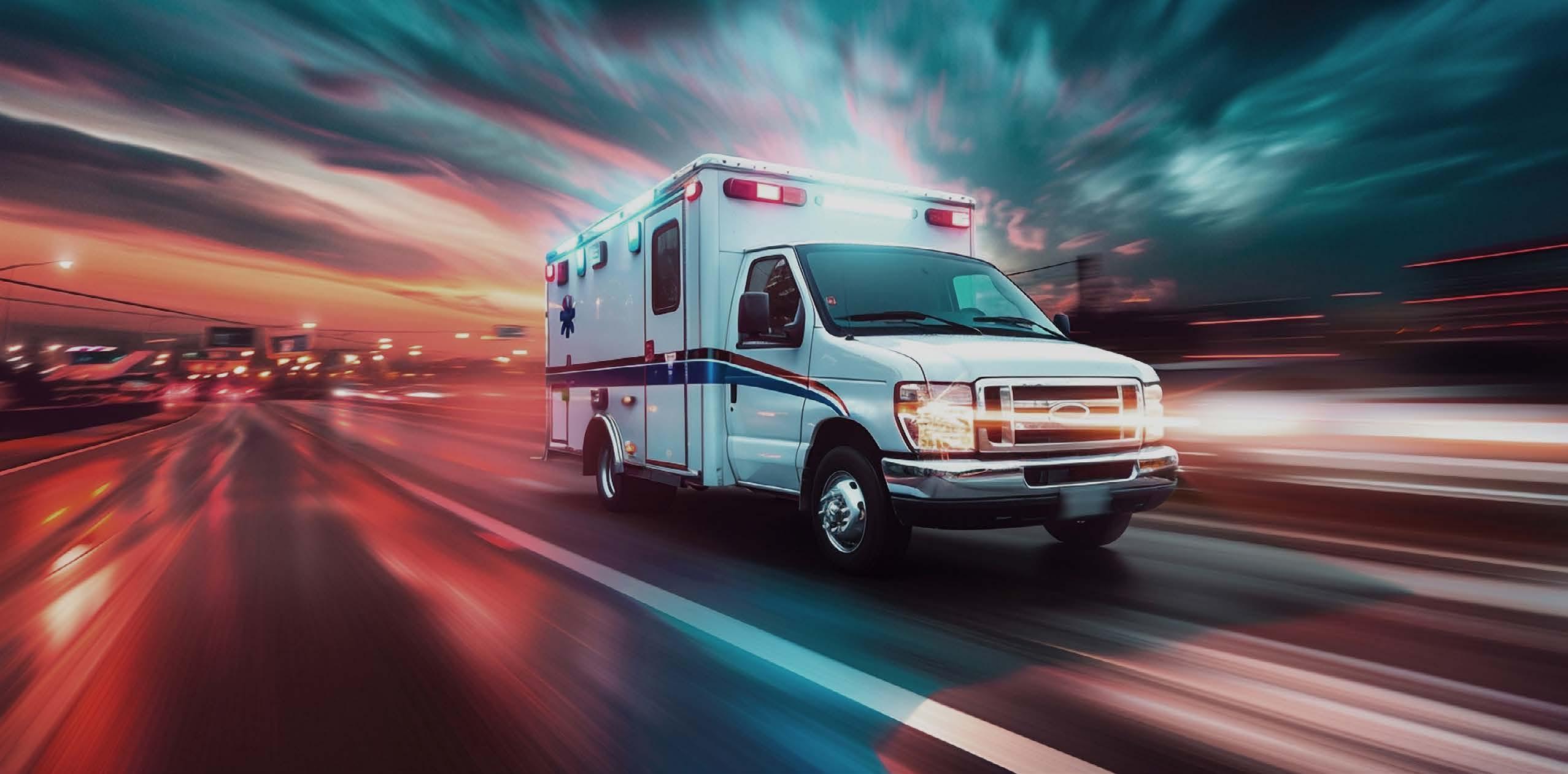
Risk Assessment. Physicians must evaluate the unique risks associated with each transport mode, balancing the potential hazards to both patient and crew.
y Air Transport Associated Risks. At higher altitudes, particularly within fixed-wing aircraft, patients are exposed to reduced atmospheric pressures which can exacerbate hypoxemia. Likewise, altitude can induce physiological changes due to atmospheric pressure alteration that can exacerbate certain conditions such as pneumothorax. Additionally, aircraft (both fixed wing and helicopter) often have limited space, making it difficult to maneuver around the patient or access equipment quickly should patient conditions necessitate bedside intervention.1
y Ground Transport Associated Risks. Ground transport is generally slower than air, which can be a significant disadvantage for time-sensitive cases such as STEMI transfers for PCI, strokes requiring thrombectomy, and trauma cases. Ground transport units often lack the advanced monitoring and intervention capabilities available in air transport, potentially limiting their capacity to manage deteriorations en-route.1
In determining the optimal mode of transport for critically ill patients, several leading organizations, including NAEMSP, AMPA, AAEM, and ACEP, provide evidence-based guidelines to support patient-centered and safe decision-making.
y The National Association of EMS Physicians (NAEMSP), in collaboration with the American College of Emergency Physicians (ACEP) and the Air Medical Physician
Association (AMPA) recommend air transport for time-critical conditions (eg, severe trauma, stroke) where rapid access to specialized care is essential. NAEMSP highlights the importance of integrating air medical services into EMS systems to ensure efficient and safe patient and crew outcomes.2
y The AMPA provides specific patient selection criteria, recommending air transport when patients have unstable vital signs or need immediate intervention, particularly if they are in a remote area. They stress the need for skilled, certified flight teams and urge caution, considering factors such as weather and resource availability.3
y The American Academy of Emergency Medicine (AAEM), in collaboration with AMPA, ACEP, and NAEMSP, co-authored the policy resource and education paper titled “Appropriate and Safe Utilization of Helicopter Emergency Medical Services.” This document provides a comprehensive guideline on the appropriate use of helicopter EMS, emphasizing patient selection criteria, safety considerations, and integration into the EMS system.4
Several studies have examined the outcomes associated with ground versus air transport for critically ill patients:
y Mortality Outcomes. A study published in the “Air Medical Journal” investigated whether air transport was associated with lower mortality in patients being transported to a critical care resuscitation unit. Despite common perceptions favoring air transport, the findings suggested that air transport did not significantly reduce mortality as compared to ground transport—emphasizing the need to consider individual patient circumstances when deciding on optimal transport modality.5
y Adverse Events. A meta-analysis in the “Air Medical Journal” reviewed adverse events associated with interhospital transfers. The literature showed that altitude-related hypoxemia and equipment related limitations in confined spaces were common in air transport, while vehicle-related events (collisions, breakdowns) and traffic delays were common in ground transport. These findings further emphasize the need for careful decision-making to minimize adverse events on the patient’s specific needs.6
y Transport Safety. Research in “Critical Care” discussed the safety of interfacility transport for critically ill patients, noting that dedicated critical care transport teams with specialized training (including paramedics and nurses) and equipment are crucial for ensuring patient safety during transit.7
1. Douglas, L., & Hedges, M. (2023). Aeromedical transport for critically ill patients: Risks and considerations. Critical Care Clinics, 39(1), 123135. https://doi.org/10.1016/j.ccc.2023.08.007
2. National Association of EMS Physicians. (n.d.). Appropriate Air Medical Services Utilization and Recommendations for Integration of Air Medical Services Resources into the EMS System of Care: A Joint Position Statement and Resource Document of NAEMSP, ACEP, and AMPA. Retrieved from https://naemsp.org/position-statement/appropriate-air-medical-services-utilization-and-recommendations-for-integration-of-air-medical-services-resources-into-the-ems-system-of-care-ajoint-position-statement-and-resource-document-of-naem/
3. Air Medical Physician Association. (n.d.). Principles and Direction of Air Medical Transport, 2nd Edition. Retrieved from https://www.ampa. org/principles-and-direction-of-air-medical-transport-2nd-edition
The decision to utilize ground versus air transport for interfacility transfers of critically ill patients is multifaceted, involving patient condition, transport distance, resource availability, and cost considerations. Current literature suggests that while air transport offers speed, it does not universally translate to better outcomes and carries its own risks. Emergency and critical care physicians should assess each case individually, considering the specific needs of the patient and the capabilities of the transport team, to determine the most appropriate mode of transport. Ultimately, using a tailored, case-by-case approach enables physicians to match each patient’s clinical needs with the safest and most effective transport mode. In this way, they can ensure that each transport decision aligns with the best practices outlined in professional guidelines and is grounded in a commitment to optimizing patient care and outcomes.
4. American Academy of Emergency Medicine, Air Medical Physician Association, American College of Emergency Physicians, & National Association of EMS Physicians. (n.d.). Appropriate and Safe Utilization of Helicopter Emergency Medical Services. Policy Resource and Education Paper (PREP). Retrieved from https://www. acep.org/siteassets/new-pdfs/preps/appropriate-and-safe-utilization-of-helicopter-emer.-medical-services---prep.pdf
5. Bell, M., & Gerardo, J. (2024). Air or ground transport to the critical care resuscitation unit: Does it matter? Air Medical Journal, 43(2), 85-91. https://doi.org/10.1016/j.amj.2024.01.003
6. McIntyre, T., & Smith, A. (2024). Safety matters: A meta-analysis of interhospital transport adverse events. Air Medical Journal, 42(5), 311-318. https://doi.org/10.1016/j.amj.2024.02.012
7. Galea, M., & Chassé, M. (2020). Safety and outcomes in interfacility transport of critically ill patients: A systematic review and meta-analysis. Critical Care, 24, Article 3924. https://doi.org/10.1186/cc3924

Oluwafemi P. Owodunni, MD* and David Gordon, MD †
Airway management in critically ill patients can be fraught with complexities and life-threatening challenges.1,2 Intubation is most often necessitated by an inability to maintain oxygenation or ventilation, airway protection in patients with altered consciousness, or the imminent onset of respiratory failure.1–5 This complexity deepens with the presence of a physiologically “difficult airway,” where factors like impaired gas exchange, hemodynamic instability, and metabolic acidosis significantly increases the risk of peri-intubation complications.6,7 The high rates of peri-intubation complications highlights an opportunity for a highly strategic and cautious strategies for airway management.1,7,8
Rapid sequence intubation (RSI) is the most common approach used to effectively secure the airway while minimizing the risk of aspiration.9 Fastacting sedatives and neuromuscular blocking agents are used in combination, to allow for a safer intubation by preventing reflex movements, improving visualization of the vocal cords, and maximizing rates of first-pass success.10 Effective preoxygenation is important in preventing
desaturation during the apneic phase by maximizing alveolar recruitment and oxygen reserves. Oxygen delivery options span from low-flow devices delivering <20 L/min to high-flow systems capable of >20 L/min, each playing a role in optimizing oxygenation depending on patient needs.9,11 Additionally, appropriate positioning, equipment, and overall preparedness is key for success and may mitigate adverse events.9,12
Preoxygenation strategies using various oxygen delivery devices have been rigorously studied in critical care settings. In a first randomized controlled trial (RCT), Baillard and colleagues evaluated 53 critically ill, hypoxemic patients with comparable age and clinical profiles. They compared the utility of noninvasive positive pressure ventilation (NIPPV( NIPPV (n=27) to nonrebreather (NRB (n=26) for preoxygenation. The results were compelling, NIPPV significantly outperformed NRB, leading to superior preoxygenation and a marked reduction in desaturation events (p<0.001).13 Furthermore, the NIPPV group demonstrated higher hemoglobin saturation levels both prior to intubation and up to 30 minutes
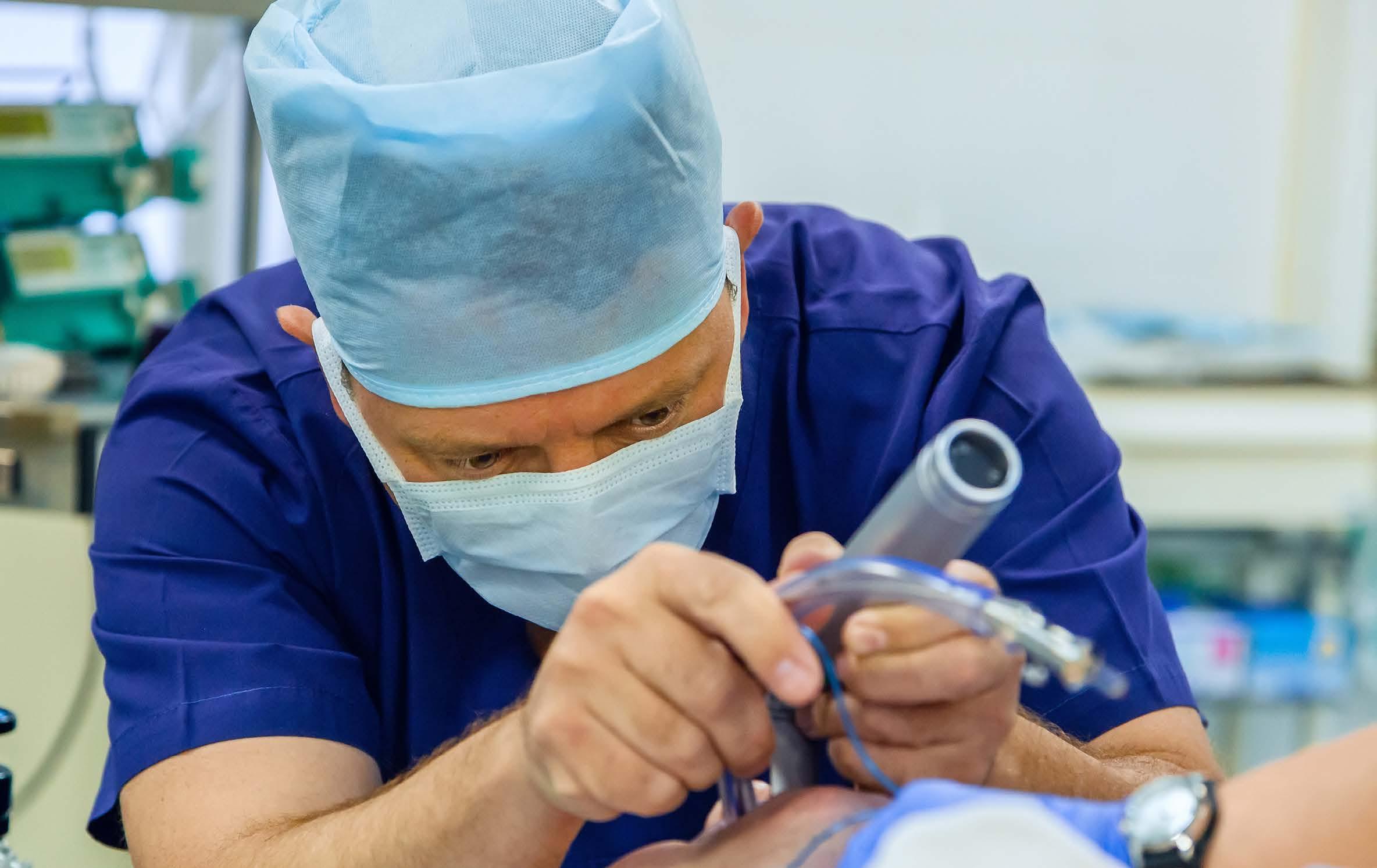
[I]ntegrating NIPPV into our standard practice is no longer just advantageous, but exigent as we take a decisive step toward optimizing outcomes.”
post-intubation (p<0.05). Importantly, there were no statistical differences between the groups in terms of aspiration or new infiltrates on chest X-ray (n=3 and 4, respectively).13
In a follow-up multicenter RCT, Baillard and colleagues included 201 patients, (NIPPV [n=99], to NRB [n=102]), and compared adverse events during preoxygenation and intubation as secondary endpoints.14 Although statistical significance between the groups was not achieved, there was a clear trend favoring NIPPV, with a 0% preoxygenation failure rate (0/45) compared to 11% in the NRB group (5/46) reported. Additionally, desaturation to SpO₂ <80% during intubation occurred more frequently in the NRB group, with rates of 17% (7/45) in the NIPPV group, and 41% (19/46) in the NRB group reported.14 Of note, an important finding emerged when patients initially preoxygenated with NIPPV were switched to NRB, resulting in a marked increase in adverse events (OR: 5.23, 95% CI: 1.61-16.99; p=0.006). Furthermore, the only aspiration event occurred in the NRB group.14 While overall deemed a negative trial, these findings offer important insights to the discourse on preoxygenation strategies.
In the recent PREOXI RCT, Gibbs and colleagues evaluated 1301 patients, comparing preoxygenation with NIPPV (n=645) to oxygen masks (NRB or bag-valve mask [BVM; n=656]). There was a significant reduction in desaturation with an absolute risk difference of −9.4% (p<0.001) between the NIPPV (57/624) and oxygen mask groups (118/637) from pre-induction to two minutes post-intubation. Notably, the lowest median oxygen saturation occurred in the oxygen mask group.15 Cardiac arrest was less frequent in the NIPPV group (1 vs. 7 [oxygen mask]).15 Additionally, aspiration occurred less frequently in the NIPPV group (6 vs. 9 [oxygen mask]), reflecting another safety advantage. Quality metrics also favored NIPPV, with patients experiencing more ventilator-free and ICU-free days, while in-hospital mortality was notably higher in the oxygen mask group.15
A possible reason for the reduced risk of aspiration and strategic advantage of NIPPV over NRB reported by the authors may be attributable to the controlled positive end-expiratory pressure (PEEP) delivered during NIPPV. Unlike BVM, which often uses high flow rates and short inflation times that result in high peak airway pressures,18 NIPPV allows for precise control over PEEP, effectively avoiding the risk of exceeding the lower esophageal sphincter pressure. When peak airway pressure surpasses this pressure gradient in an unintubated patient, gastric inflation
References
*University of New Mexico School of Medicine, Department of Emergency Medicine
†Medstar Washington Hospital Center Department of Critical Care
1. Higgs A, McGrath BA, Goddard C, et al. Guidelines for the management of tracheal intubation in critically ill adults. Br J Anaesth. 2018;120(2):323-352. doi:10.1016/j.bja.2017.10.021
can occur, thereby increasing the risk of aspiration.18,19 With its controlled pressure delivery, NIPPV maintains peak airway pressures within a safe range, reducing stomach inflation and optimizing airway protection.
Exploring other oxygen delivery strategies, the PROTRACH study, comparing high-flow nasal cannula (HFNC) to BVM with a reservoir bag in non-severely hypoxemic patients found no significant differences in the lowest oxygen saturation during intubation.16 However, HFNC demonstrated a clear advantage by reducing the incidence of intubation-related adverse events, including fewer occurrences of any moderate to severe complications and a lower rate of esophageal intubation.16 The FLORALI-2 multicenter RCT, conducted across 28 intensive care units in France, and enrolled 322 patients intubated for acute hypoxemic respiratory failure, characterized by a PaO₂/FiO₂ ratio of ≤300 mmHg report on the advantages of NIPPV over HFNC.17 Patients were randomized to NIPPV or HFNC, with stratification based on the severity of hypoxemia (PaO₂/FiO₂ ≤200 mmHg vs >200 mmHg). While the overall analysis showed no significant difference in the risk of hypoxemia between the two oxygenation strategies, their sensitivity analysis noted a significantly reduced risk of severe hypoxemia when preoxygenated with NIPPV (OR 0.56, 95% CI 0.32–0.99, p=0.05) in patients with severe hypoxemia (PaO₂/FiO₂ ≤200 mmHg).17 HFNC in the PROTRACH study demonstrated a clear advantage by reducing the incidence of intubation-related adverse events, including fewer occurrences of any moderate to severe complications and a lower rate of esophageal intubation. In addition the comparable efficacy of HFNC to NIPPV makes it a good addition to clinicians preoxgenation repertoire.
Clinical practice guidelines are evolving, aligning with an expanding body of evidence that supports NIPPV and HFNC as important preoxygenation strategies for airway management.9,12,20 A 2024 international Delphi study published by an international steering committee in the journal of intensive care medicine lends support to this paradigm shift through their expert consensus.12 Beyond advocating for NIPPV, the guidelines reiterate the clinical relevance of optimizing hemodynamically unstable patients, and incorporating a human factors approach to optimize first-pass success.12 Moreover, it is also important to gauge institutional capacity for implementation efforts, and streamline processes to deliver optimized care effectively. Based on this guidance, integrating NIPPV into our standard practice is no longer just advantageous, but exigent as we take a decisive step toward optimizing outcomes.
2. Dunham MC, Barraco RD, Clark DE, et al. Guidelines for Emergency Tracheal Intubation Immediately after Traumatic Injury. J Trauma Acute Care Surg. 2003;55(1):162. doi:10.1097/01.ta.0000083335.93868.2c
3. Developed by the American Society of Anesthesiologists Task Force on Difficult Airway Management: Robert A. Caplan, Jonathan L. Benumof, Frederic A. Berry, Casey D. Blitt, Robert H. Bode,
Continued on page 49 >>
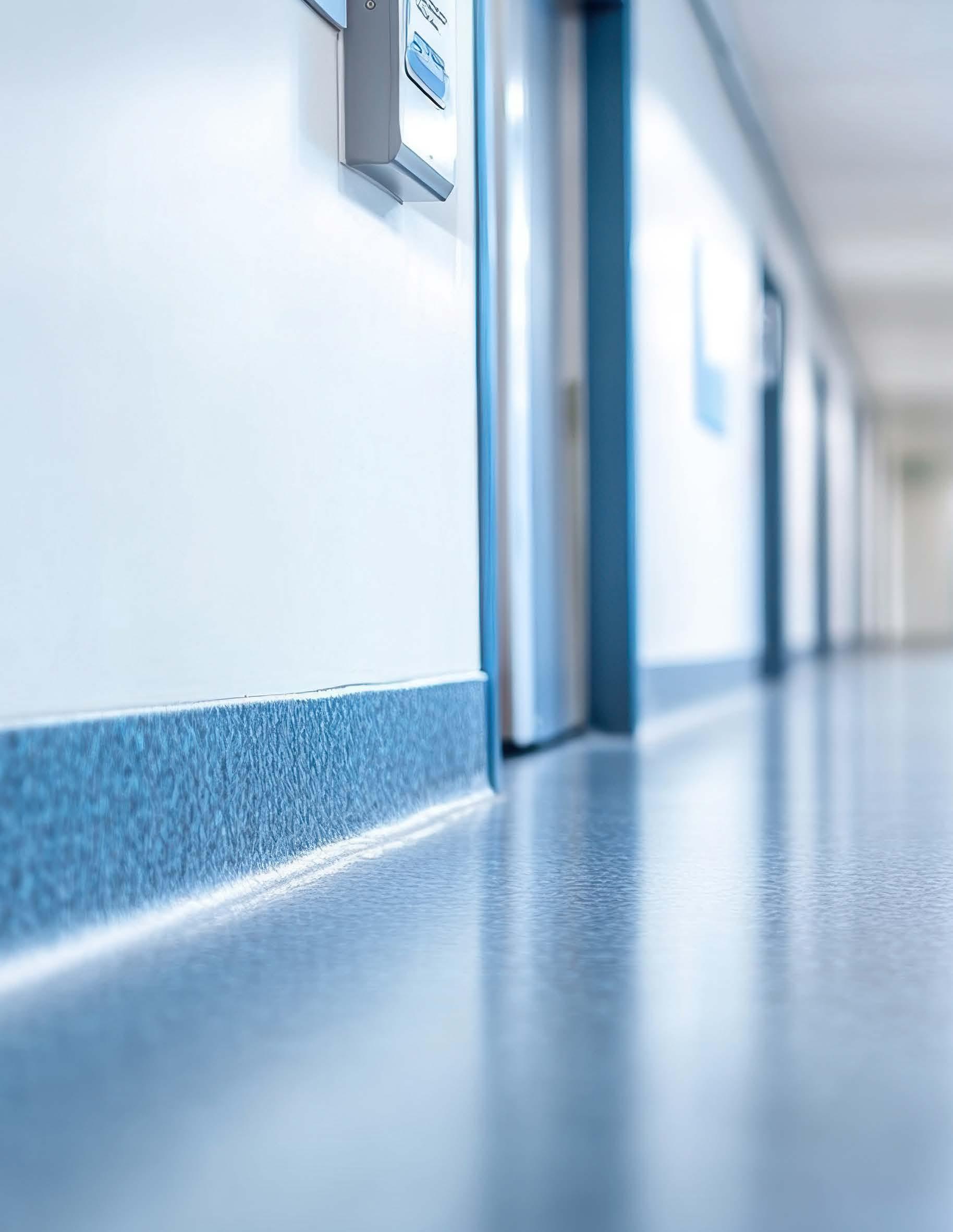
Cecilia Hurtado, MS, Victor Cisneros, MD MPH CPH FAAEM, and Jordan Vaughn, MD
ase: Denise is a 53-year-old monolingual Spanish-speaking woman accompanied by her 6-year-old grandson who presents to the emergency department with severe epigastric abdominal pain. The attending physician knows minimal Spanish and asks the patient’s grandson to assist with interpreting; the grandson hesitantly agrees. Denise is treated with famotidine for gastroesophageal reflux disease and sent home with return precautions that are explained to and interpreted by the grandson. Denise presents to the ED again the following day with substernal chest pain and is found to have a STEMI.
What could have been done differently to optimize Denise’s care?
For many undocumented immigrants, visits to the emergency department may be their only access point for healthcare and are complicated by fears of the healthcare system and discrimination. In the United States, undocumented immigrants comprise 11 million individuals, the largest group of uninsured individuals with an estimated uninsured rate of 50 percent. Emergency departments are vital as the country’s healthcare safety net, especially among uninsured and under-resourced communities. The Emergency Medical Treatment and Labor Act ensures that all patients, regardless of ability to pay or immigration status, receive emergency medical treatment.
Undocumented immigrants are ineligible for federal health coverage, and nearly four in ten cite no usual source of care besides the emergency department.1 Although some states have expanded access to health coverage for specific undocumented immigrant populations, such as children or pregnant people, many undocumented immigrants remain fearful of accessing healthcare and assistance programs.2 Among immigrants who are eligible for coverage, many cite enrollment barriers, including confusion about eligibility policies and language and literacy challenges. Moreover, undocumented immigrants accessing care in emergency departments endorse fears of negative consequences on immigration status, family separation, denial of services, and interactions with law enforcement, including Immigration Customs Enforcement (ICE).
Emergency medicine physicians can improve care for and mitigate fears among undocumented immigrants in several vital ways.
The emergency department should be seen as a safe haven for patients presenting for care. Medical and mental healthcare facilities are considered “protected areas” by the Department of Homeland Security—ICE officers are instructed to refrain from enforcement actions, including
arrests and apprehensions, at or near these sites.3 Do not contact ICE, as this can break the therapeutic relationship between physicians and their patients and propagate fear and medical mistrust among undocumented communities.
Avoid assuming or asking about a patient’s immigration status, as many undocumented immigrants avoid healthcare settings due to fears that their immigration status will be reported or that their background will impact their quality of care. Avoid documenting a patient’s immigration status in the medical record. Instead, if relevant, “immigration-related concerns” can be listed under the social history.
As more than 25 million people in the US, including many undocumented immigrants, have limited English proficiency (LEP), it is essential to provide language-concordant care, which improves patient outcomes, reduces communication-related medical errors, and increases patient satisfaction.4,5 Furthermore, it is mandated by the Americans with Disabilities Act, Civil Rights Act of 1964, and Affordable Care Act that healthcare settings offer interpretation services to patients. Avoid using gestures instead of spoken words, a phenomenon referred to as “getting by.”6 Additionally, avoid ad-hoc translations from patients’ family members, especially minors. When in-person interpreters are not available, telephone and video-based interpretation are also useful. For more information, please refer to AAEM’s guide, “Best Practices for Caring for Patients with NonEnglish Language Preferences and/or Who Are Deaf/Hard of Hearing in Emergency Departments.”7
Visible displays of policies and education about patients’ rights in the emergency department can allay patient’s fears about accessing care. Written and spoken communication can convey patients’ right to formal interpretation service in their preferred language. The American Academy of Emergency Medicine has recently published “Be Empow(ER)ed,” a guide to patients’ rights in the ED and tips for navigating healthcare settings.7 Waiting areas or patient rooms should display educational materials in various languages. If immigration status is discussed, reassure patients that their information is protected by HIPAA and will not be shared outside the healthcare system.
For
many undocumented immigrants, visits to the emergency
department may be their only access point for healthcare and are complicated by fears of the healthcare system and discrimination.”
Undocumented immigrants have expressed the desire for referrals to resources and education during healthcare visits.8 Providing all patients with these referrals and educational materials as part of the after-visit summary can increase community awareness of essential information. Resources should be provided in both English and their native language to increase the opportunity for this information to reach the patient and their community. Discharge materials can include lists of local community resources (e.g., free clinics, student-run clinics at a nearby medical school, community-based organizations) and information about patients’ legal rights. One example is a discharge navigator used in San Francisco that provides information and links to resources, including housing, food,
References
1. Key Facts on Health Coverage of Immigrants. KFF. September 17, 2023. Accessed May 12, 2024. https:// www.kff.org/racial-equity-and-health-policy/fact-sheet/ key-facts-on-health-coverage-of-immigrants/
2. Ornelas C, Torres JM, Torres JR, Alter H, Taira BR, Rodriguez RM. Anti-immigrant Rhetoric and the Experiences of Latino Immigrants in the Emergency Department. West J Emerg Med. 2021;22(3):660-666. doi:10.5811/westjem.2021.2.50189
3. Protected Areas and Courthouse Arrests | ICE. Accessed May 24, 2024. https://www.ice.gov/about-ice/ero/protected-areas
4. Karliner LS, Pérez-Stable EJ, Gregorich SE. Convenient Access to Professional Interpreters in the Hospital Decreases Readmission Rates and Estimated Hospital Expenditures for Patients with Limited English Proficiency. Med Care. 2017;55(3):199-206. doi:10.1097/ MLR.0000000000000643
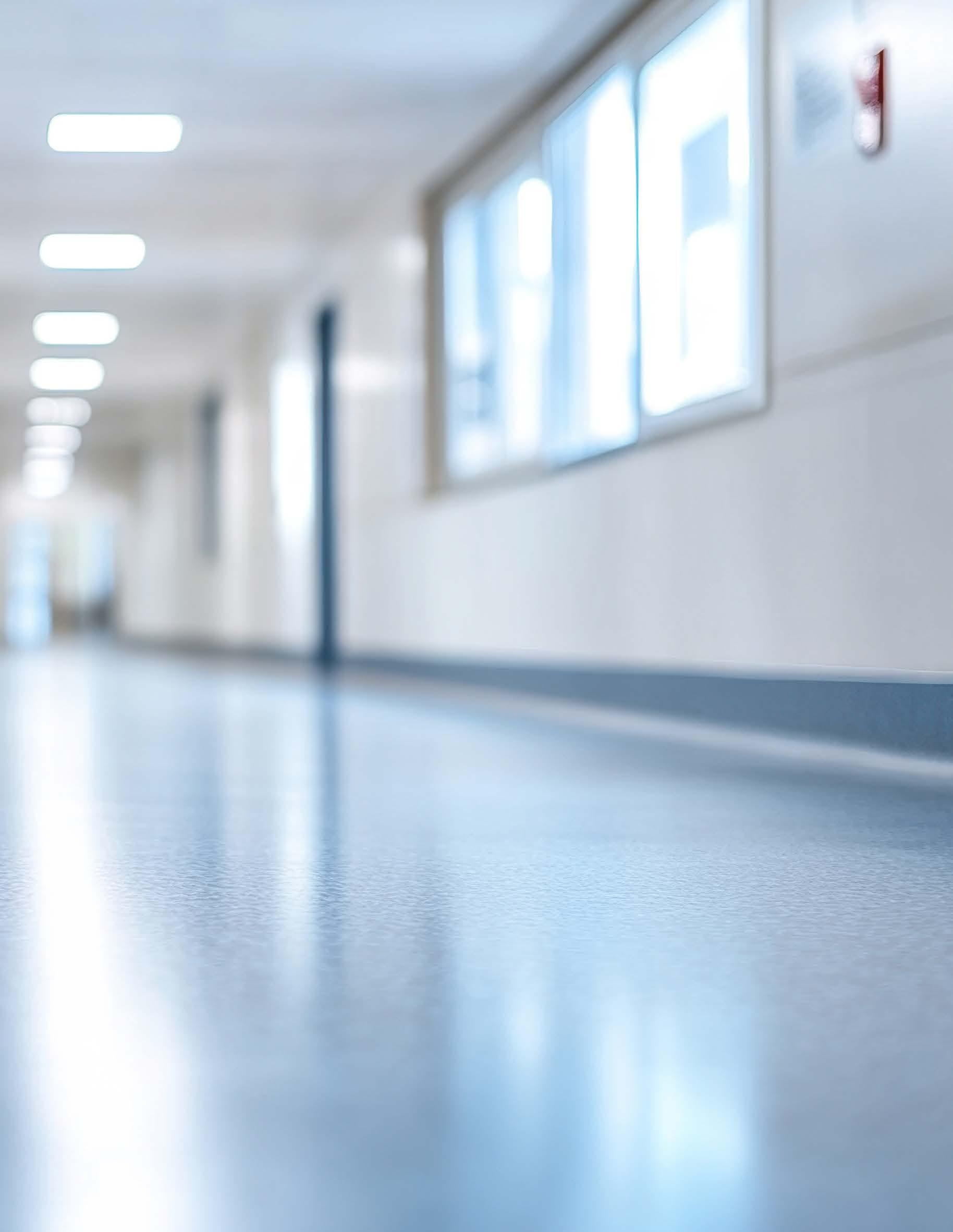
and support for survivors of intimate partner violence.9 Some states may also offer health coverage to undocumented immigrants with specific criteria. Sharing this information with patients may foster trust in the emergency department and healthcare system.
Wrapping up the case: To optimize Denise’s care and ensure an adequate understanding of her clinical history, her emergency department could utilize a phone, video, or in-person interpretation service instead of relying on her grandson, a minor, for interpretation. Using certified interpreters can avoid missing critical pieces of clinical history, which, in this case, may have revealed that her symptoms were likely cardiac-related rather than GERD. Discharge instructions and resources could be provided in both Spanish and English.
5. Kwan M, Jeemi Z, Norman R, Dantas JAR. Professional Interpreter Services and the Impact on Hospital Care Outcomes: An Integrative Review of Literature. Int J Environ Res Public Health. 2023;20(6):5165. doi:https://doi.org/10.3390/ijerph20065165
6. Diamond LC, Schenker Y, Curry L, Bradley EH, Fernandez A. Getting By: Underuse of Interpreters by Resident Physicians. J Gen Intern Med. 2009;24(2):256-262. doi:10.1007/s11606-008-0875-7
7. JEDI-AAEM Resources. AAEM. https://www.aaem.org/get-involved/ sections/jedi/resources/
8. Lee J, Bruce J, Wang NE. Opportunities for Supporting Latino Immigrants in Emergency and Ambulatory Care Settings. J Community Health. 2021;46(3):494-501. doi:10.1007/ s10900-020-00889-7
9. SF Service Guide | San Francisco. https://sfserviceguide.org
Christopher Colvin, MD

Tired. Long shift. Just discharged four patients from the ED and five more checked in on an otherwise blasé Saturday night. Some sniffles. A case of mild diarrhea. An earache. Dental pain in a meth addict. Vanilla cases really.
Loud noises. Shouting. Hurried feet.
The squeaky axle and tacky rubber tread of an old wheelchair.
“Gunshot! Gunshot!”
Time: Zero
I look at a gray body slumped over the rail covered in vomit. Blood-soaked black hoodie and sweatpants. I grab some powder dry blue gloves. I’ve done this thousands of times.
“On the bed. One, two, three. Make him naked. What’s your name? Hey!” Rub his chest hard to wake him up. A grimace. Trauma shears shred his clothes. A kid. Just a kid. Cut through his boxers.
Bright red froth shoots into the air over the rails of the bed and pours onto the floor.
“Shit. It’s his artery.” I lean heavily on his thigh over the gaping hole. It does little. I can feel the heavy red rain on my boots. The heat and flow of his life through my fingers is accelerating.
“I need IV’s. Tourniquets. Two units of packed cells. Gram of TXA, please. We don’t have vascular. Call the trauma center. We need to get him out of here. Hey kid! Kid! What’s your name?” His eyelids open then close.
Nurse One: “I have an IV in his right AC but he’s so sweaty the tape won’t stick. Give me some coban.”
First tourniquet has been locked down. Still bleeding.
“I need a central line. Need a second tourniquet. One above and below the wound. Hold pressure here.”
Nurse Two: “Below the wound?”
“Yes. Back bleeding. Where’s the blood?”
Nurse Three: “On its way. I have the TXA.”
“Give it. What’s the blood pressure?”
Nurse Four: “It won’t cycle. Heart rate is 190.”
“Manual BP please. I’m placing the central line on the other side. Let’s get this on.”
Nurse Two places second tourniquet and I help her adjust them while holding pressure in the groin and on the open wound.
“Pull them both tight. Then I want a pressure dressing over this as well. Tight as it will go.”
“Argghhhh!” Kid screams.
“What’s your name?”
He mumbles then cries.
“I’m dying,” he mutters.
His eyes close.
His face looks relaxed.
The color is all gone from his cheeks.
“I know. I know. I’m trying. Open your eyes!
Wake up!” I rub his chest hard with my knuckles.
Eyes open and close.
ER tech: “Blood is here.”

I examine his body for other wounds.
Entrance and exit.
One round.
Lungs clear.
Belly soft.
Head normal.
Pale. Gray. Sweaty.
Nurse One: “I got a second IV in his left AC.”
Nurse Three: “TXA given. Blood started on pressure bags.”
Nurse Four: “Right AC IV is not flowing well.”
I look at the monitor.
Heart rate 190.
Blood pressure 70/40.
Oxygen 98%.
Protecting his airway.
Three Minutes
I hang my coat on the monitor and tell the charge nurse.
“He’s going to die. I need him in an OR.”
Charge Nurse: “We called. EMS enroute.
Two minutes.”
“Roger.”
I pull on the gown, the hat, clean the other groin. Size 8 sterile gloves. Introducer needle. Flash of dark blood. I’m in the vein. Thread the wire. I’ve done this thousands of times.
“What’s his pressure?”
Nurse One: “90/60.”
I look over.
Nurses did a great job with the pressure dressing.
Kid is moaning.
Blood has stopped pooling over the floor tiles.
“Hey! Don’t move. Don’t move. I’m in your vessel. Someone hold his leg.”
Kid passes out again.
“Give it. Both units.” Did I do enough?”
Five Minutes
EMS: “What you got?”
“Single GSW to femoral artery. Shock. Two units given. TXA. Two IV’s and a central line. Two tourniquets and a pressure dressing.
Don’t know his name. Protecting his airway and moaning. BP up from nothing to 90/60. NRB for now. Sats are 100%. Lungs clear.”
Nurse Two: “Do you want Levophed or fluids?”
“No, thank you. Just needs more blood and a surgeon. They can give the plasma and platelets there.”
EMS: “Ready to move him? We have blood in the truck.”
“Yeah.” I look and both of our units are dry. Kid is whispering.
His eyes are open.
I can’t hear him.
“What?” I ask.
“I’m thirsty,” he says.
“Good. That’s good.”
Seven Minutes
I stand there watching the medics load him in the back of the ambulance and the kid gives me a thumbs up. I’m covered in blood from my mask to my boots. I tear away the gown and gloves. Go to the bathroom. Blood splattered in my beard and beneath my jaw. Couple of droplets apparently hit my ear. Wipe my face with cold tap water and a rough brown paper towel. Walk into the hall.
Drunk Patient: “Hey! You the doctor? I’ve been waiting 20 goddamn minutes and no one has come in here.”
“Sorry. Will be there in a bit.”
Drunk Patient: “No. I ain’t waiting for nobody.”
“Well, you look fine. I’ll be there in a bit. Take a seat in your room.”
Drunk Patient: “I want another doctor!”
“Sorry. It’s just me. One doctor. That’s it. That’s all you get.”
Drunk Patient: “Then I want your supervisor.”
“That’s me too. I’m the supervisor. Please go to your room.”
Nurse Three: “Come on. Back in your room.
He’ll be right there. We just had a sick patient.”
Drunk Patient: “I don’t care! He’s a shitty doctor if he can’t run this place by himself. Fuck him!”
Nurse Four: “The patient in room nine wants to ask more questions about why her period is so irregular.”
“Fine. She speaks Pashtun. Set up the translator again and I’ll explain a second time what dysfunctional uterine bleeding is for peri-menopausal women.”
Nurse Five: “Can you go talk to the mom again about her kid’s chest x-ray? I know you said no pneumonia, but she wants to see it.”
“Is she a doctor?”
Nurse Five: “No, she wants to take a picture of it to show her pediatrician. She thinks her kid has pneumonia.”
“No pictures. No pneumonia. No fever. Just a runny nose. She can go. I don’t need to repeat that.”
Nurse Six: “Can you resend the meds for room 12? She changed which pharmacy she wanted them to go to.”
“Sure.”
ER Tech: “Here’s another ECG for you to sign. Patient just showed up in triage.”
“Thank you.”
ECG is normal.
I sit down and start charting on the GSW.
Did I do enough?
He’s a kid.
I didn’t want to waste time.
I hope he makes it.
He may not.
That was a lot of blood.
I hope he makes it.
Drive home for an hour. Road is dark. Highway is busy, but I’m able to go as fast as I can without getting in trouble with the DPS officer on the side of the road. Eyes are heavy. I’m so tired.
Stay awake.
Stay awake.
Did I do enough?
Did I do enough?
Pull into the driveway. Turn off the truck. Wife and daughter are out of town at a competition.
House is quiet. Refrigerator hums. I put down the briefcase. Need to shower. Phone rings. It’s almost 1:00am.

“What’s up?”
“Hey, doc. That kid with the GSW?”
“Yeah.” I begin to worry.
“They called in another vascular surgeon, but he’s alive, and it looks like he’s gonna make it.
Got three surgeons working on him right now.”
“No shit?”
“Yeah. No shit.”
“Thanks.” I reply.
“You bet.”
See a soft glow in the back room. Head down the hall and my teenager is still awake. He’s about the same age as the GSW.
“That your new video game you wanted?”
“Yeah,” he replies. “How was work?”
“Not bad. Not bad.”
I fall into the couch next to him and watch the vivid colors and action sequences. I can feel the worry ease as the ED shift static becomes quieter and quieter. The background noises of monitors and alarms and loud voices flows into whatever that large black box is in the back of my mind. The vivid colors get softer. I can feel my son’s reassuring hand on my shoulder.
“Close your eyes, Dad. Just rest. You’re home.”
I think I did enough.
I hope it was enough.
I’m so tired.
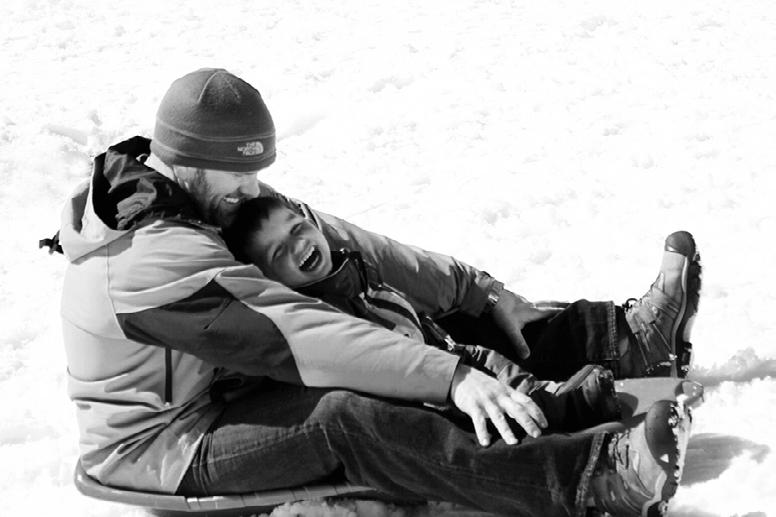
Kadie Stephens, MS4
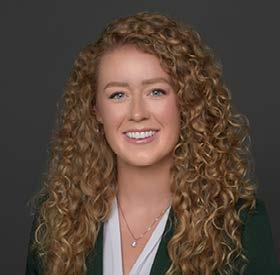
Being a physician is often romanticized in popular media as a glamorous and a noble profession dedicated to healing and caring for others. However, beneath this idealistic facade lies a pressing issue: the lack of self-care by physicians and the increasing prevalence of physician suicide. Recent studies show that physicians are at a higher risk for suicide compared to the general population, with various factors contributing to this critical situation.
Suicide rates among physicians are alarmingly high. According to a 2020 study published in the Journal of the American Medical Association (JAMA), “male physicians have a suicide rate of approximately 1.4 times higher than that of the general male population, while female physicians face an even more severe disparity, with a suicide rate nearly 2.5 times higher than their female counterparts in the general population.” Factors such as high stress, burnout, stigma surrounding mental health, and access to lethal means contribute significantly to these tragic outcomes. The demanding nature of the medical profession, especially in emergency medicine is characterized by long hours, high-stakes decision-making, and emotional strain—can lead to burnout, depression, self-isolation from family, substance abuse, and anxiety among EM physicians. The pressure to excel often precludes self-care, resulting in a detrimental cycle where EM physicians neglect their own well-being.
Promoting wellness in medicine is not just beneficial but essential. The “ideal model for physician wellness should include both
References
individual factors and the organizational structure and environment in which physicians work.”3 Implementing conversations about physician suicide and wellness, mindfulness training, resilience-building workshops, and peer support programs can foster a healthier work environment. Additionally, hospitals that prioritize work-life balance, offer mental health resources, and create a culture where seeking help is encouraged rather than stigmatized can help decrease suicide rates in physicians. By addressing these issues, we can help prevent physician burnout and ultimately reduce the risk of suicide.
State physician health programs (PHPs) are an avenue that serves as an intermediary between medical licensing boards and physicians seeking help with mental health and substance abuse issues. Notably, one of the key benefits of PHPs is their commitment to confidentiality. While PHPs can be a valuable resource for physicians addressing mental health and substance abuse issues, it is crucial to recognize that not all programs are equally effective. Therefore, vigilance is essential to identify and avoid subpar programs.
The issue of physician suicide underscores the urgent need for systemic change in the field of medicine. By prioritizing wellness and destigmatizing mental health discussions, we can create a more supportive environment for healthcare professionals. State physician health programs play a role in this transformation, providing confidential assistance that encourages physicians to seek help without fear of judgment.
1. Earley, Paul, MD DFASAM. Emory Grand Rounds, “ Addiction Among Physicians and the Georgia Physician Health Program”. January, 23rd, 2024. https://youtu.be/RMP_ZKfpZlU?si=9buK4hkiCjfknlZr
2. Dante Duarte, MD, PhD; Mirret M. El-Hagrassy, MD; Tiago Castro e Couto, MD, PhD; Male and Female Physician Suicidality: A Systematic

The issue of physician suicide underscores the urgent need for systemic change in the field of medicine.”
As we move forward, it is imperative for medical institutions, policymakers, and healthcare communities to work collaboratively to address these challenges, ultimately ensuring that those who dedicate their lives to caring for others can also care for themselves. Together, we can foster a culture of wellness that promotes not only individual physician health but ultimately enhances the overall quality of patient care.
If you or someone you know is struggling, please reach out to a healthcare professional or contact a state physician health program for assistance.
National Suicide Prevention Lifeline: 1-800-273-TALK (8255)
American Foundation for Suicide Prevention: afsp.org
Physician Health Programs by State: fsphp.org/state-programs
Review and Meta-analysis. (2020). March 4. et al. JAMA Psychiatry. 2020;77(6):587-597. doi:10.1001/jamapsychiatry.2020.0011
3. Stehman, Christine R, et al. “Wellness: Combating Burnout and Its Consequences in Emergency Medicine.” The Western Journal of Emergency Medicine, U.S. National Library of Medicine, 13 Apr. 2020, pmc.ncbi.nlm.nih.gov/articles/PMC7234720/.
William Durkin, MD MBA MAAEM FAAEM*
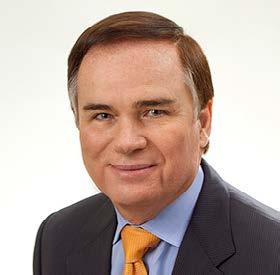
On November 20 and 21 I travelled to Capitol Hill to meet with members of Congress in order to promote the Physician and Patient safety Act (Due Process), and try to obtain co-sponsors. It was a very successful trip! Thanks to Sue Emmer and Brian Young of I Street Advocates, our lobbying firm. I was able to meet with Representatives Raul Ruiz (D-CA), August Pfluger (R-TX), Rich McCormick (R-GA), Ronny Jackson (R-TX), the staff of Representative Scott Peters (D-CA), as well as Senator Marshall (R-KS).
I had first met Representative Ruiz in 2013, while I was AAEM President. We had several meetings during that year. He is an EM physician and understands our issues. He has been a champion of the Academy since then and is the original sponsor of the bill on the House side. He has agreed to continue to work with us in the next Congress and re-introduce the bill.
Representative Pfluger has also agreed to co-sponsor the bill. We had a very productive meeting and I believe that he will be an ally to the Academy going forward.
Next was a meeting with the staff of Representative Peters who is my Representative. We had an excellent discussion of the issue and they did show some interest in our bill. This meeting served to introduce them to our issues and discuss why this bill is so important to us and our patients. We will have further meetings with them as we try to get the Representative to be another co-sponsor.
My last meeting of that day was a dinner with Representative McCormick and his staff. We had an in depth discussion not only about this bill, but other issues that are affecting the practice of medicine. He is very well informed about what is happening in the medical field, and I believe that he too, will be a supporter of our issues. He agreed to be a co-sponsor of the bill.
The next morning began with a breakfast meeting with Representative Jackson. He is also an EM physician and former White House physician during the Bush, Obama, and part of the first Trump administration. We also met back in 2012 and have kept in touch over the years. He is a very enthusiastic supporter of EM and will remain a supporter of our bill in the next Congress.
My final meeting was with the co-sponsor of our Senate bill, Senator Marshall. He is as anxious as I am to get the bill moving and promised to re-introduce it in the next Congress along with Senator Warren (D-MA). He is also open to exploring other means of moving this issue along and promised to discuss it with the incoming Secretary of HHS.
Overall, a busy yet very productive two days. Several of the members and staffers mentioned how important it is to not only get the message out to all of our Representatives but also to the general public. Increasing awareness of this bill and why it is so important is key to getting the bill passed. I urge all of our members to write to your Representatives and Senators, asking for their support and making yourself available to discuss the issue with them. We need to increase awareness on the Hill and the best way to do so is to have all of our members write and have as many of you as possible attend the fly in on the Hill (dates to be announced in the coming weeks). For those of you who feel you need some instruction, we are offering an HPEM course at SA and another just before the meetings in June. I hope to see all of you there!
References
*Past President, PAC Treasurer, Co-Chair Government Affairs Committee

Increasing awareness of this bill and why it is so important is key to getting the bill passed.”
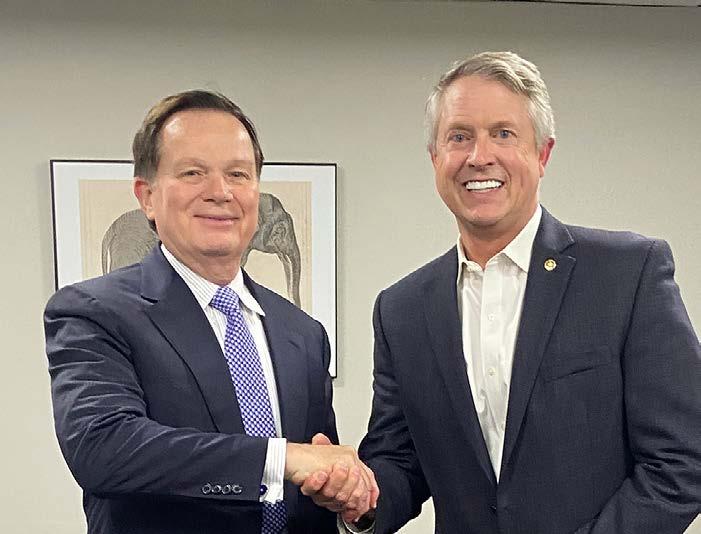
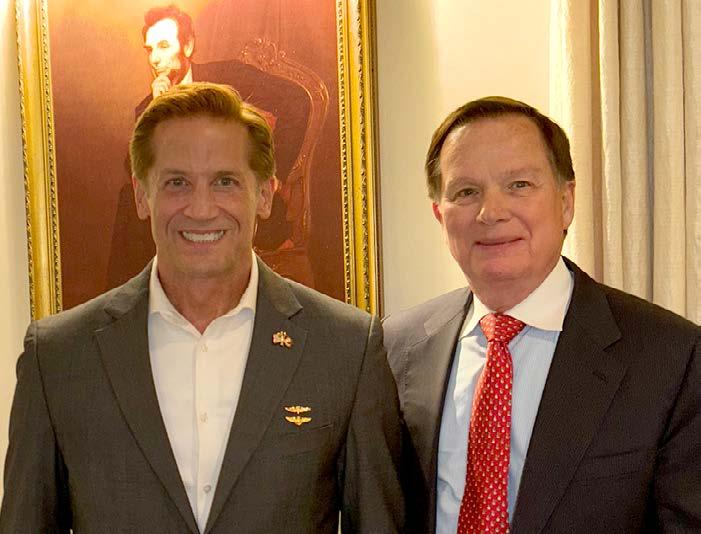
Aymane Rouchdy, MS4
Growing up as a child of Moroccan immigrants in New York City, I rarely met other kids who shared my American-born, Middle Eastern and North African (MENA) cultural background. This disconnect was apparent during my early clinical exposures. Although New York has a sizable MENA population, encountering a MENA-identifying physician was the exception, not the rule. This lack of representation inspired me to pursue medicine to help bridge that cultural gap and bring a missing perspective to patient care.
Now, as I apply for emergency medicine residency, I’m struck by the progress being made toward greater inclusion. For the first time in its history, the AAMC offers residency applicants in Match 2025 the opportunity to self-identify as MENA and specify their country of origin. The addition is more than a checkbox—it marks a first step toward clearly recognizing this community in healthcare and acknowledging the diversity MENA physicians bring, which has been largely invisible until now.
Early data from the AAMC highlights just how significant this change is. According to CORD’s trends for the 2025 cycle, 332 out of 4,784 emergency medicine applicants this year identified as MENA, approximately 7% of the applicant pool. Previously these individuals were often classified as “white” or “other,” leaving us with an incomplete view of the workforce’s diversity. This new data offers a more accurate understanding of our workforce, which is essential for any DEI effort to be effective.
A similar shift is happening nationwide. While the 2020 U.S. Census did not offer a MENA category, a MENA designation is expected in the 2030 Census. This change reflects a growing recognition of our community’s identity. Current estimates suggest that 3.5 million MENA people live in the United States, comprising roughly 1% of the population. Though this may be an undercount, given that MENA individuals have historically been categorized as “white.” The MENA community has remained largely invisible on a national level and as a result, our self-advocacy efforts have fallen short.

This shift in the ERAS application will, above all, benefit our patients.
A MENA patient arriving in the ED could encounter a physician who looks like them, understands their cultural background, and speaks their language. A MENA-identifying physician might explain the need for emergent IV access to a patient fasting during Ramadan or recognize the hesitancy of a female patient being evaluated by a male physician. These are a few examples of the nuanced factors that shape healthcare decisions within MENA communities. Such cultural understanding can make a meaningful difference in communication, comfort, and patient outcomes. The trust and rapport that develop when a patient meets a physician who “speaks” their culture is invaluable.
But this goes beyond understanding our patients—it’s about understanding each other. Working alongside colleagues unfamiliar with MENA cultures, MENA physicians add an important layer of cultural awareness to their teams. By sharing our backgrounds and stories, we deepen our colleagues’ understanding of the patients we care for together. This collaborative awareness not only makes us better physicians, but fosters a more inclusive, informed, and compassionate healthcare environment.
Historically, MENA-identifying students have faced barriers in medicine including limited mentorship, scarcity of role models, and few resources. Representation matters. With accurate data, residency programs, and DEI initiatives can recognize our community as distinct, with needs and contributions as valid as any other minority group. Including a MENA designation in ERAS allows programs to establish mentorship, create DEI task forces, and build outreach programs that will help MENA applicants feel seen, valued, and supported.
Looking ahead, I envision an emergency medicine workforce where MENA medical students see their future selves reflected in their mentors, and where patients from diverse backgrounds encounter physicians who understand their needs. This ERAS change may seem small but it’s the beginning of a broader movement, one that brings us closer to an inclusive, representative, and supportive future in medicine.

Including a MENA designation in ERAS allows programs to establish mentorship, create DEI task forces, and build outreach programs that will help MENA applicants feel seen, valued, and supported.”
Michelle Romeo, MD FAAEM
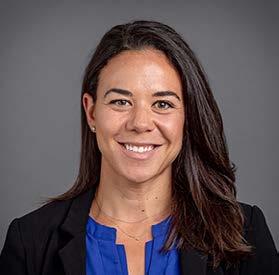
One of the most frustrating parts of our jobs is being unable to give patients what they may be most in need of. Whether that be constant access to food, steady housing, health insurance, or rehabilitation, there are many times I’ve discharged someone feeling like I never actually helped them at all. As someone who joined a practice in a city I was unfamiliar with, where social work is not consistently available, I have had to do a lot of the heavy lifting to understand what my options were to assist with patients’ social needs upon discharge. It’s a pattern that I’ve become accustomed to with various relocations every few years secondary to my career path.
A unique opportunity presented itself within the residency didactic program of our department. I was given the opportunity to host multiple sessions throughout the year focused on structural competencies. These sessions would focus on teaching residents more about recognition and care of patients’ social determinants of health. The structure allowed me to invite guest lecturers to talk on many topics, from medicare to prison health to disability access. What I found to receive positive feedback on were lectures that gave real world/community resolutions to issues that can feel daunting and unable to combat.
With this feedback, the focus turned to inviting community programs to talk to our faculty and residents about the services they provide, the limits of their programs, and a front line view of what happens with referrals and patient interactions. Our guest speakers included program representatives from wound care clinics, homelessness outreach services, street medicine groups, disability advocacy groups, clinics for uninsured and undocumented, and asylum resources. By the end of each visit, contact numbers were exchanged, warm introductions made, and general awareness spread. Ancillary staff have requested zoom call in options, follow up materials, and summaries after every presentation.
[T]here are many times I’ve discharged someone feeling like I never actually helped them at all.”
Not only have these discussions given residents and faculty a toolbox to reach into but I have found it allows for more comfort in having these tough discussions with patients. Many avoid asking about social needs, in part because our ability to solve these issues is outside of our medical practice and training. While I may not have hard data on patient’s utilization and physician satisfaction, I have witnessed in real time more meaningful interactions and referrals.
I recognize that there is structured time in our residency for discussions surrounding structural competencies and I view it as a luxury. For those in practices without carved out educational times, I think it is feasible to find ways for introductions and education around resources in your community. Whether it be during faculty meetings or even just email or virtual introductions, many representatives are eager to disseminate information. These are vital resources that address issues that plague a large number of our patients.
Prioritizing exposure and education of your community programs will not only give you more options for your patients but can assist with follow up, decreasing return visits, and access to vital basic needs. I urge you all to be a liaison in your department, to continue to be curious about your patients beyond their medical complaints, and to do the work to allow them the best outcomes outside of your brief but important interaction with them. Just a bit of food for thought, try bringing your community to you.


Mary Unanyan, DO
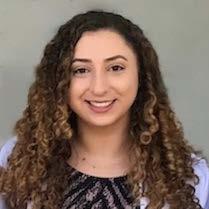
The transition from intern to senior resident is one of the most transformative chapters in emergency medicine training. It’s a leap from being the learner to becoming the leader, from managing your patients to managing the entire team. While the idea of stepping into this role may be intimidating, it is also a unique opportunity to hone your skills, solidify your knowledge, and discover the kind of physician—and leader—you want to be.
As an intern, the focus is on building a strong foundation: how to evaluate patients efficiently, order the right tests, navigate the complexities of the hospital system, and develop clinical confidence. You focus on refining your clinical acumen and learning to survive—and eventually thrive—in the fast-paced world of emergency medicine. As a senior resident, your role shifts. Now, you’re expected to see the department as a whole. Suddenly, you’re not just managing patients but also managing the room and guiding the team through the organized chaos of the emergency room.
The senior resident is the person others look to in moments of uncertainty for assurance and decisive action. When the intern feels overwhelmed while managing a crashing patient, you’re the one who steps in when things go sideways. When a medical student struggles during a laceration repair, you’re the one who teaches with patience and reassurance. But it’s not just about making decisions—it’s about making others feel empowered even when the pressure is on. And as a senior resident, you have the power to set the tone for the team—your attitude, communication, and leadership style can make or break morale.

One of the most fulfilling aspects of being a senior resident is teaching. In the emergency department, every case offers a lesson. You’ll explain procedures, share pearls of wisdom, and guide junior learners through their own challenges. What you may not expect is how much teaching others will teach you in return. It forces you to articulate your reasoning, uncover gaps in your own understanding, and push yourself to master concepts you once struggled with.
Perhaps the biggest shift in mindset as a senior is learning to balance individual patient care with department flow. You’ll need to see the big picture: recognizing when to escalate care, who needs imaging urgently, when to push for a disposition, the order of operations for your to-dos, and when to guide your learners versus step back. It’s a balancing act and the ability to juggle all these moving parts is a skill that requires intuition, experience, and adaptability—one that you will continue to develop even into attendinghood.
The shift from intern to senior resident is more than just a change in title; it’s a rite of passage. This transition is your chance to grow—not just as a physician, but as a leader and mentor. Embrace the moments that challenge you because those are the moments that shape you. Remember why you chose emergency medicine: the adrenaline, the variety, the chance to make a difference in someone’s worst day.
This responsibility can feel daunting, but that’s okay. Growing pains are part of the process. Imposter syndrome may rear its head and there will be moments when you are uncomfortable and question your readiness. These feelings are natural and often a sign of how much you care. The key is to lean into the discomfort—it’s where growth happens. There will be moments when you become overwhelmed and will need the support and guidance of your own seniors. That is also a natural part of your growth. Every shift, every difficult case, every tough decision is molding you into a stronger physician.
The good news is that you’re not alone. Mentorship from attending physicians, support from peers, and feedback from your team will help you navigate this transition. Take time to reflect on your leadership style, celebrate small victories, and embrace mistakes as opportunities to learn.
[L]eadership isn’t about knowing all the answers— it’s about staying steady and empowering those around you so that you can find the answers together.”
Your journey as a senior resident will be full of highs and lows, but with every shift, you’ll become stronger, more confident, and more capable. You’ll walk out of this phase not only as a better doctor but as a mentor of strength and support for your juniors. Even on the hardest days, remind yourself: leadership isn’t about knowing all the answers—it’s about staying steady and empowering those around you so that you can find the answers together.
MESSAGE

Mel Ebeling, BS
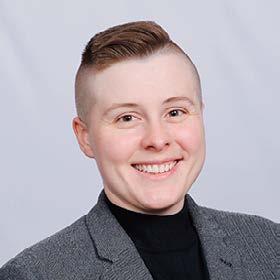
Gifted to me in my final year of medical school by a former professor, “A Little Book of Doctors’ Rules,” originally published in 1992 by the late Dr. Clifton Meador, is a short, sometimes humorous guide offering over 400 tips and tricks on the practice of medicine. Seemingly lost in time, this book provides rather sage advice to the new clinician while prompting the occasional chuckle—for example, “Rule 33: Tell patients to remove the foil from a suppository before insertion.” Indeed, perusing its pages reveals powerful insights about the elements of a great physician, elements that, despite drastic advancements in medical science, appear to have largely remained the same since its publication. Now just months away from making the monumental transition from student to emergency medicine resident physician, I reflect on Dr. Meador’s Rules with reverence. What steps can I take as a new physician to become a great physician?
Rule 2: Always examine the part that hurts. Put your hand on the area…warns against laziness when performing physical examinations. Always take the time to inspect the area rather than palpating through the clothing or neglecting the physical exam altogether. Seeing is believing.
Rule 8: The good clinician knows what he or she does not know…is a reminder to stay humble. Medicine is a lifelong art and science; there is always something to learn from our textbooks, colleagues, students, and patients. Refrain from making assumptions or firm statements in the face of uncertainty both in the clinical decision-making process and in patient counseling.
Rule 43: When you are telling patients what they do not have, be sure to include those diseases most feared and especially those that have killed close members of the family. Do this only if you are sure you have excluded those diseases…provides practical cautionary advice for counseling patients. We ought to have the emotional intelligence to uncover and address our patients’ fears, especially in emergencies.
Rule 52: Learn to watch people’s faces.
Rule 53: Learn to watch people’s nostril size.
And, Rule 54: Learn to watch the lower lip then the upper lip again emphasize the importance of emotional intelligence. Patients need not always verbalize how they are feeling; astute observation of facial expression is often all that is needed. It is this body language that often tells more than any words the patient can offer.
Rule 68: Just because you know a lot of physiology, biochemistry, and anatomy does not mean you know anything about life or people. Let your patients and other people teach you…is a reminder to me that the end of medical school only marks the beginning of
A
Little Book of Doctors’ Rules’… reveals powerful insights about the elements of a great physician, elements that, despite drastic advancements in medical science, appear to have largely remained the same since its publication.”
physicianhood, and medical school alone does little to teach you about the workings of life and the people you serve. Similar to rule eight, remaining humble is important for prosperity and longevity in this career.
Rule 104: Develop a list of physicians you trust and respect, nurture your relationship with them, and contact them about difficult cases. Select one in each of the specialties and call them as often as you need…stresses the necessity of physician camaraderie, both for the sake of quality improvement and combating burnout. I consider it convenient that my closest friends intend to match into psychiatry.
Rule 148: Try to leave every patient smiling, no matter how grim the circumstances…brings attention to the notion that we should remember to treat the patient, not just the disease. As we strive to provide patients with the time and opportunity to pursue happiness by way of evidence-based medicine, we ought to preserve realistic hope.
Rule 152: You are the patient’s advocate. You work for no one else…highlights a core function of physicianhood. When in doubt, champion the needs of the patient first.
Rule 365: There is no substitute for direct observation…is an admonition to return the bedside when a concern is raised. The time taken to do so will likely always be less than the time spent fixing the miscommunications or the decompensated patient that would otherwise result.
Rule 422: The four fundamental components of good clinical judgement: Intelligence, Knowledge, Experience, Continuous critical analysis of results…is a final proclamation on the elements comprising a great physician. Only when base intelligence is supplemented with continued education as experience is gained, and when recent patient encounters are approached with healthy reflection and appraisal for quality improvement, can the good clinical judgment that defines an exceptional physician be achieved.
With these rules in mind, I am at peace with the physicianhood that is rapidly approaching. Medical science changes every day, as do computer systems and insurance and billing requirements; although, being present and humble for our patients is the core tenet that is yet to change. Workforce wellness begins here, with recognizing the defining principles of the privilege of physicianhood and the qualities its members possess.


Brian Pringle DO, Michael DeFilippo DO, and Christopher Root, MD
Patient refusal is a complex and uncomfortable issue. It pits the ethical principles of autonomy and beneficence against each other, and raises valid concern for legal risks associated with patient care decisions.
EMS responders make high-consequence decisions in a fast-paced environment, managing critical tasks like scene management, medical stabilization, and patient transport. By efficiently coordinating these efforts, EMS teams expedite definitive care for their patients while ensuring resources are swiftly available for their community’s next emergency. In this time-sensitive environment, among the most challenging and consequential situations prehospital responders face is a patient refusing transportation or treatment.
Patient refusal is a complex and uncomfortable issue. It pits the ethical principles of autonomy and beneficence against each other, and raises valid concern for legal risks associated with patient care decisions. A prehospital responder could fairly ask, “If I respect a patient’s wishes and leave, is it abandonment?” Or, conversely, “If I force care or transport, could it be seen as assault or battery?” Indeed, there have been several instances of high-profile, refusal-related litigation. Navigating these stressful encounters ultimately relies on the appropriate determination of one nuanced but critical element: decision making capacity (DMC).
If an adult patient has DMC, their right to independently choose what happens to their body should be respected, even if those choices contradict what medical professionals feel is in
their best interest. Though there is no universally accepted definition for capacity in acute care settings, expert consensus dictates that a patient’s ability to guide care relies on four parallel abilities:
• The ability to receive and retain information
• The ability to process and understand information
• The ability to deliberate and reason
• The ability to make and convey stable choices
See Figure 1 for a visual summary of the foundational elements of decision-making capacity.
If a patient has been appropriately informed as to the benefits and risks of proposed and alternative options, and demonstrates the above-mentioned tenets, they have the capacity to consent to or refuse EMS intervention. But what if a patient has been deemed incompetent?
court-established incompetence for cognitive or behavioral health concerns. Understanding the distinction between competence and DMC is essential in EMS, as it allows EMS responders to make informed decisions in real-time, ensuring that patient autonomy is respected when appropriate while safeguarding against unsafe refusals in critical situations.
Determining DMC in the field can be a difficult task given the clinical urgency and information deficits inherent to prehospital care. Moreover, common issues like intoxication, dementia, and psychiatric conditions can compound the difficulty further. Research by O’Conner, et al., demonstrated that there may be significant discordance in capacity determinations between hospital-based and EMS responders. This suggests that increased attention to prehospital determination is needed.
One potential barrier to the accuracy of prehospital capacity assessment is that formal determinations rely on protracted evaluation and subtle neurocognitive criteria. That said, Larkin and colleagues suggest that the most practical approach to DMC determination, one that is likely familiar to most emergency physicians, is through simple conversation. By asking a patient to restate and explain their understanding of immediate options and potential consequences, responders can often assess whether the essential components of decision-making capacity are present.
How can a medical director help their team on the capacity determination frontlines? Though the answer will certainly vary between agencies, there are several avenues to support our prehospital responders in their effort to efficiently and accurately assess DMC in the field.
It is important to note that capacity and competence are not one in the same. Competence is a legal term established through judicial proceedings that relates to an individual’s aptitude to participate in legal proceedings. DMC is solely an individual’s ability to make informed decisions in a given moment, and exists apart from competence. In medicine, DMC is ascertained by care practitioners. Most importantly, a person may have capacity despite >>
Given the potential clinical and medicolegal ramifications of capacity determination, it should be approached with the same gravity as other high consequence clinical situations. Developing protocols for when and how to
Figure 1. Basic elements of medical decision making capacity
Patient has been counseled on the benefits and risks of proposed treatment/transportation, as well as potential risks of alternatives.
Receive & Retain Information Processing & Understanding Deliberation & Reasoning Make, Convey & Defend Choice
Patient has attention and receptive language abilities
Patient has ability to store information in working memory to facilitate processing
Patient applies risks and benefits of options to self and situation
Patient assigns personal values to risk and benefits of options
determine DMC, and what to do in cases where it is not present (i.e. seek advanced directives, medical power of attorney, or surrogate decision makers; or force transport) can provide valuable support and mitigate both ambiguity and confusion in a prehospital setting.
The availability of well-trained, on-call support can provide both guidance and reassurance for field responders. In addition, consider incorporating reviews of capacity determinations and patient refusals into quality assurance and improvement programs. This practice can help identify areas for refinement and reinforce the importance of clear documentation, which is essential for medicolegal protection.
EMS responders operate amid diverse environmental, social, and clinical stressors. Simple, structured tools like checklists, algorithms, or flowcharts can aid decision-making in the field and support consistent documentation of capacity assessments. Though there are no evidence-based tools specifically designed for prehospital determination of decision making capacity, including the basic elements of DMC determination on refusal forms may help lessen a responder’s cognitive burden and increase both self-reliance and efficiency.
With varying degrees of education and experience, the EMS workforce relies on continued training to develop and maintain clinical skills. By including capacity-specific simulation in EMS curriculum, one can reinforce foundational knowledge surrounding this important topic. A study by Du Pont, et al., demonstrated
Patient envisions and compares potential consequences of options
Patient demonstrates rational and logical approach to information
that on-shift simulation training significantly increased EMS clinicians’ confidence in assessing DMC, highlighting the effectiveness of simulation-based education in this area.
Capacity and refusal are legally complex issues. Being well-versed in state legislation pertaining to capacity and EMS operations is essential for an agency to practice in accordance with the law. Since states vary in their legal approach to issues like suicidal ideation, it’s essential for your team to understand and interpret the specific regulations in each state. Additionally, many states provide “good faith” protections for EMS personnel, often offering prehospital responders stronger legal safeguards than those available to hospital-based professionals. Being familiar with and applying these legal considerations to protocol development, training and medical control support can help ensure legally defensible capacity determination.
Accurately assessing decision-making capacity in prehospital settings is vital for respecting patient autonomy while ensuring safety. EMS responders face unique challenges in this area, necessitating robust protocols, ongoing training, and a thorough understanding of relevant legal frameworks. By implementing structured decision-making aids, engaging in simulation training, and staying informed about state-specific laws, EMS agencies can enhance their capacity assessments, thereby improving patient outcomes and reducing medicolegal risks.
Further Reading
• PWW EMS Law. (n.d.). Court case illustrates importance of following patient refusal. Page, Wolfberg & Wirth LLC. Retrieved
H&P must confirm that patient can communicate
Patient comes to and communicates a stable conclusion
October 31, 2024, from https://www. pwwemslaw.com/resources/law-library/ compliance/court-case-illustrates-importance-following-patient-refusal
• Du Pont, D, Bar J, Baca J, et al. Assessing the Feasibility of On-Shift Simulation to Improve Capacity Assessments by EMS Clinicians: A Pilot Project. International Journal of Paramedicine, 2024;5:118–124.
• Karmelić E, Lindlöf H, Luckhaus JL, et al. Decision-making on the fly: a qualitative study of physicians in out-of-hospital emergency medical services. BMC Emerg Med. 2023;23(1):65.
• Jones CM, Cushman JT, Lerner EB, et al. Prehospital Trauma Triage Decision-making: A Model of What Happens between the 9-1-1 Call and the Hospital. Prehosp Emerg Care. 2016;20(1):6-14.
• Larkin GL, Marco CA, Abbott JT. Emergency determination of decision-making capacity: balancing autonomy and beneficence in the emergency department. Acad Emerg Med. 2001;8(3):282-284.
• O’Connor L, Porter L, Dugas J, et al. Measuring Agreement Among Prehospital Providers and Physicians in Patient Capacity Determination. Acad Emerg Med. 2020;27(7):580-587.
• Potts v. Board of Leavenworth Country. L.C. KN. No. 97,828. 2008.
• St. George v. City of Deerfield Beach. 68 So.2d 931, 1990.
• Stuhlmiller D, Cudnik M, Sundheim M, et al. Adequacy of online medical command communication and emergency medical services documentation of informed refusals. Acad Emerg Med. 2005;12: 970–7.

Joshua Lynch, DO FACEP* and Lucy Connery, MPH †
Why is linking patients with opioid use disorder to high-quality treatment so challenging? For years, emergency medicine has relied on handing patients a list of resources to follow up with after being discharged from the emergency department (ED). Even after the removal of the X-waiver, we still struggle to prescribe buprenorphine to patients who qualify. Do you face these same challenges? Read on to learn more about the development and optimization of Medication for Addiction Treatment and Electronic Referrals (MATTERS), a multi-state linkage, harm reduction, and telemedicine program!
The opioid crisis continues to devastate communities across the nation, with healthcare workers on the frontlines facing dynamic challenges in linking patients to timely and effective treatment. Amidst this growing public health emergency, MATTERS is transforming how clinicians bridge the gap between patients with opioid use disorder (OUD) and the care they need. By addressing common barriers for patients and streamlining workflows for physicians, MATTERS ensures that individuals are linked to essential resources early on, including telemedicine services and harm reduction supplies, before being referred to outpatient treatment. In a healthcare landscape where time and resources are limited, MATTERS offers a groundbreaking solution that redefines treatment for substance use disorder.
The MATTERS concept was developed in 2016 by Joshua Lynch, DO FAAEM FACEP, Associate Professor of Emergency and Addiction at the University at Buffalo Jacobs School of Medicine and Biomedical Sciences who saw the inadequacies in how our healthcare system treated patients with OUD. Upon leaving the hospital, patients were typically given a list of outpatient facilities to call themselves, oftentimes listing old numbers and leading patients to a dead end when seeking care. If physicians were willing to try to contact an outpatient treatment organization to schedule an appointment, it took time away from other patients, interrupted their workflow, and often led to frustration. With the support of the University at Buffalo Jacobs School of Medicine and Biomedical Sciences, UBMD Emergency Medicine, and the John R. Oishei Foundation, MATTERS set out to develop strategic partnerships with various community-based and statewide stakeholders to launch an electronic referral system for people with OUD in 2019.1 The rapid referral platform began as a pilot with one hospital in western New York and three outpatient treatment organizations. Through demonstrated success, applicability to various other health settings, and outreach efforts, the referral network grew into a multi-state, rapid referral system.
Today, MATTERS partners with over 330 referring sites, 250 treatment organizations, and over 1,000 pharmacies to facilitate linkage to treatment and resources for OUD (see Figure 1). Referrals are completed in about three minutes, require zero phone calls, and can be made from any location, including EDs, inpatient units, law enforcement agencies, telehealth settings, schools, and community-based organizations. Individuals who are referred can select where they would like to follow up for care from over 2,500 weekly appointment slots, and all participating treatment organizations will accept any patient, regardless of insurance status, previous treatment history, and polysubstance use.
Since its inception, MATTERS has consistently followed a methodical approach, initiating its services on a small scale, rigorously evaluating outcomes, and expanding based on demonstrated efficacy and need. For instance, when developing a rapid referral system, the MATTERS team needed to address the perception that outpatient treatment organizations were unable to accept new patients.4 The program conducted outreach and found that treatment organizations were accepting new patients but needed flexibility when scheduling appointments. MATTERS approached this concern by gathering weekly appointment availability for participating treatment organizations and offering those slots to patients being referred through the program. To ameliorate any gaps in access to medication, MATTERS developed a referral protocol for participating clinicians that includes a suggested buprenorphine bridge prescription for up to 14 days. Several studies have found that emergency department-initiated medication for opioid use disorder (MOUD) programs improve follow-up rates and retention in treatment for OUD.1,3,6 However, MATTERS
recognizes that many people seeking treatment for OUD experience financial and transportation barriers to long-term care.
In response to these issues, MATTERS sought region-specific and statewide grant funding to provide patients with transportation for their first follow-up appointment and a voucher that covers the cost of any buprenorphine/naloxone prescription for the uninsured for up to two weeks. As an added layer of support, everyone referred through the program can choose to be linked to a peer in recovery to navigate the early stages of recovery. These services help individuals navigate common barriers to treatment, improve follow-up rates, and provide a one-stop solution for clinicians linking people with OUD to treatment (see Figure 2). MATTERS continually searches for additional ways to refine the program to reduce even more barriers that patients may encounter.
Still, the opioid crisis has continued to challenge clinicians; the COVID-19 pandemic led to an increase in people using drugs alone and a subsequent rise in opioid overdose deaths across the United States. When telemedicine prescribing flexibilities were offered nationally, MATTERS launched two virtual emergency departments to provide evaluations, prescriptions, and referrals to treatment for OUD. Although these emergency departments are based in Buffalo, NY, the program serves individuals across all of New York state and received an average of 185 calls related to OUD each month in 2023. With the support of a SAMSHA MAT-PODA grant, MATTERS and community-based partners concurrently launched the Western New York Opioid Addiction Hotline, a 24-hour service for individuals seeking treatment for substance use disorder.2 In 2023, this hotline completed over 1,600 visits for substance use disorder, 80% of which resulted in linkage to medication, and 60% received a MATTERS referral to treatment. Individuals referred from virtual settings receive the same support as those who sought care in-person, including MATTERS’ medication and transportation vouchers.

MATTERS’ Medical Director of Telemedicine, Renoj Varughese, MD, stated, “Telemedicine has emerged as a critical tool in the fight against the opioid and substance use disorder epidemic. By increasing access to life-saving medications, counseling, and support services, telemedicine is breaking down barriers to treatment and offering a lifeline to those struggling with addiction, especially in underserved communities and areas with physician shortages.” To secure long-term funding to sustain these services, leadership from the MATTERS program have documented the program’s success through several research publications. A recent MATTERS publication found that individuals referred from telemedicine settings (when compared to the emergency department) were more likely to attend their initial follow-up appointment (65% versus 32%) and were more likely to be retained in treatment after 30 days (53% versus 22%).5 This information is vital when advocating for legislation to expand telemedicine services for substance use disorder.
Lastly, in August of 2022 MATTERS launched its fentanyl test strip distribution program with the support of the New York State Office of Addiction Services and Supports (NYSOASAS). The program began by distributing to hospitals to demonstrate the success of a mail-based harm reduction supply distribution system. MATTERS Harm Reduction Manager, Shelby Arena, highlights the importance of offering harm reduction services to support patient success:
“Harm reduction services can be a tool to connect people who use drugs (PWUD) to vital resources and treatment. By using a ‘no wrong door’ approach, we can link individuals seeking harm reduction supplies to a robust offering of support services like housing, mental health support, substance use treatment, and beyond. Harm reduction not only reduces overdose risk but truly meets people where they are to build trust and relationships while facilitating access to care.”
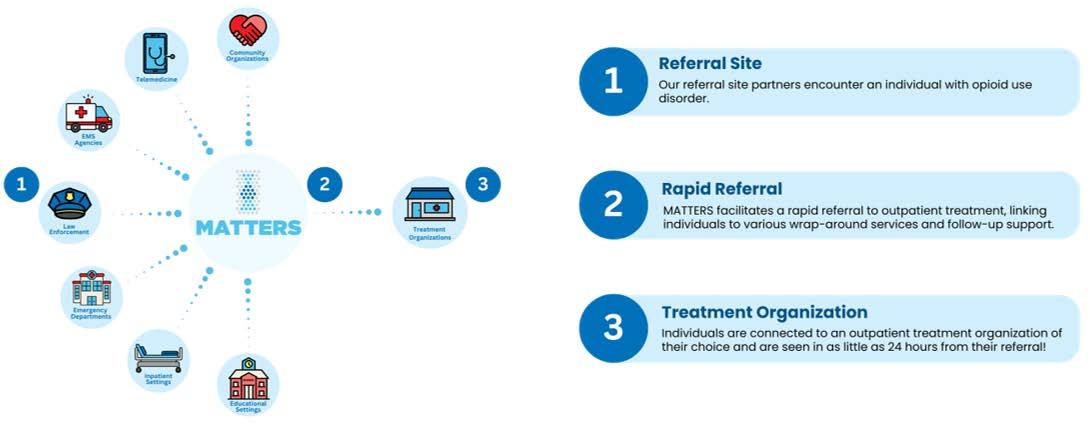
In only a few months, the MATTERS program expanded its test strip distribution service to allow any individual or organization to request free supplies. Today, it is the primary distributor of fentanyl and xylazine test strips in New York state, shipping over 20 million strips across the region. The MATTERS team is currently evaluating the behavioral changes associated with using test strips and plans to release its research for other health systems to utilize. To further augment its harm reduction services, the program is also researching the potential utilization of new test strips for medetomidine, benzodiazepines, and nitazenes.
To improve access to drug test strips and naloxone, MATTERS launched its harm reduction vending machine program and introduced nearly 20 machines into communities across New York state in 2024. Introducing these resources to the community required vetting applicants, building strategic partnerships, and establishing memorandums of understanding with organizations seeking to host a machine. Vending machines are accessible 24/7, temperature-controlled, and hosted at various locations, including treatment organizations, bus stops, law enforcement agencies, and convenience stores. These machines currently dispense free drug test strips and naloxone to anyone and collect basic demographic information to support future research on the success of these programs.
In 2023 the United States saw its first decrease in opioid overdose deaths since the opioid crisis was named a public health emergency in 2017.7 However, this decline was not evenly distributed across demographic groups. Opioid overdose deaths decreased among white people by 14%
References
*Associate Professor of Emergency & Addiction Medicine, University at Buffalo, Jacobs School of Medicine and Biomedical Sciences
†Marketing Coordinator, MATTERS Network
1. Clemency, B.M., Hoopsick, R.A., Burnett, S.J., Kahn, L.S., & Lynch, J.J. (2022, July). Implementing a novel statewide network to support emergency department-initiated buprenorphine treatment. Western Journal of Emergency Medicine, 23(4). https://doi.org/10.5811/ westjem.2022.3.54680
2. Connery, L. & Lynch, J.J. (2022, April). Partnership on MATprescription drug and opioid use disorder grant. Retrieved from: https://mattersnetwork.org/mat-prescription-drug-opioid-grant/
3. D’Onofrio, G., Chawarski, M. C., O’Connor, P. G., Pantalon, M. V., Busch, S. H., Owens, P. H., Hawk, K., Bernstein, S.L., & Fiellin, D. A. (2017, February). Emergency department-initiated buprenorphine for opioid dependence with continuation in primary care: Outcomes during and after intervention. Journal of General Internal Medicine: JGIM, 32(6), 660–666. https://doi.org/10.1007/s11606-017-3993-2
4. Kruger, D.J., Kirk, H.M., Leonard, K. E., Lynch, J.J., Nielsen, N., & Clemency, B.M. (2024, December). Assessing challenges and
but decreased by only 6% for Black communities and 2% for Asian or Pacific Islanders. Overdose deaths also increased for Native American/ American Indian populations by 2%.7 These rates also increased for individuals over age 65, which underscores the need for targeted, population-specific interventions and equitable access to evidence-based treatments such as medication for addiction treatment (MAT).
MATTERS is constantly expanding and responding to the ongoing opioid crisis. The program plans to expand its referral system to support inter-state referrals between New York, New Jersey, and Pennsylvania. Additionally, MATTERS recently formalized its follow-up support services; staff members follow up with everyone referred through the program 72 hours after linkage to treatment. These dedicated staff follow up again 30, 60, and 90 days after the referral was submitted to navigate any barriers to treatment and support continuity of care (see Figure 3).
In 2025, MATTERS will launch its syringe services program, a mailbased initiative to provide sterile injection supplies to individuals across New York. Supplies will be delivered via mail, through vending machines, and through emergency departments. The program also plans to install additional harm reduction vending machines into communities across New York state. MATTERS is proud to serve as a model for a rapid referral network linking individuals to treatment and resources for OUD. Interested in learning more on the program or how to collaborate on bringing MATTERS resources to your area? Contact the MATTERS team at 765-MATTERS (628-8377), download the free MATTERS Network app on Google Play or the Apple App Store, or visit mattersnetwork.org.
solutions in substance abuse prevention, harm reduction, and treatment services in New York State. SSM – Health Systems 3(100039. https://doi.org/10.1016/j.ssmhs.2024.100039
5. Lynch, J. J., Payne, E. R., Varughese, R., Kirk, H. M., Kruger, D. J., & Clemency, B. (2024, October). Comparison of 30-day retention in treatment among patients referred to opioid use disorder treatment from emergency department and telemedicine settings. Journal of Substance Use and Addiction Treatment, 165, 209446. https://doi. org/10.1016/j.josat.2024.209446
6. Reuter, Q. R., Santos, A. D., McKinnon, J., Gothard, D., Jouriles, N., & Seaberg, D. (2022, May). Long-term treatment retention of an emergency department initiated medication for opioid use disorder program. The American Journal of Emergency Medicine, 55, 98–102. https://doi.org/10.1016/j.ajem.2022.02.041
7. Saunders, H., Panchal, N., & Zitter, S. (2024, September). Opioid deaths fell in mid-2023, but progress is uneven and future trends are uncertain. The Kaiser Family Foundation. Retrieved from: https://www. kff.org/mental-health/issue-brief/opioid-deaths-fell-in-mid-2023-butprogress-is-uneven-and-future-trends-are-uncertain
Melissa Myers, MD FAAEM, Brian Kenny, DO FAAEM, and Dan Mayer, MD FAAEM
Apatient presents to a small rural ED with chest pain. His high-sensitivity troponin comes back at 1200. You recommended transferring him to a larger facility with cardiology, but he refused the transfer and asked to be discharged. What do you do now? Do you just let him leave? Call the police for an emergency detention? Pull out the haloperidol?
It is estimated that about one to three percent of patients will leave the ED against medical advice. It is on us as emergency physicians to assess their capacity and ability to make a decision. We know that some patients do not have the ability to understand the consequences of their decisions, and yet some do. How can we determine the difference, and why should you care?
The ethical principle of autonomy presumes that patients have the right to self-determination. A patient’s capacity can vary in time and must be assessed with each decision. This is different from competency, which is more permanent and a legal and not medical assessment.
Let’s start with a very familiar situation. A patient presents after a motor vehicle collision. He admits to you that he had “one beer” before the accident but says that he feels well. You’ve recommended that he undergo imaging, but he’s declining, stating that he doesn’t have pain and has to leave. What’s next? How do you know if he has the capacity to make a medical decision? If only there were clear criteria…
Capacity is determined by several criteria. The patient must be able to understand what you are telling them, what their choices are, understand what the decision will mean for their health, and then make a decision that is consistent with internal logic. The decision made by the patient should be consistent and not change during the time that the patient is being evaluated. Patients with a history of a mental illness, or who have consumed drugs or alcohol before arriving at the emergency department, may still have capacity, which should be tested regardless of the presence of these factors. A patient with capacity also has the right to base their understanding of your care on their personal values, even if they disagree with your medical information and advice.
Ability to render a choice.
1. Have you decided whether to go along with your doctor’s suggestions for treatment? Can you tell me what your decision is? (Can be repeated to assess stability of choice)
Ability to understand relevant information.
1. Please tell me in your own words what your doctor told you about:
a. The nature of your condition
b. The recommended treatment (or diagnostic test)
c. The possible benefits from the treatment
d. The possible risks (or discomforts) of the treatment
e. Any other possible treatments that could be used and their risks and benefits
f. The possible risks and benefits of no treatment at all
2. You mentioned that your doctor told you of a [percentage] chance the [named risk] might occur with treatment. In your own words, how likely do you think the occurrence of [named risk] might be?
3. Why is your doctor giving you all this information? What role does he/she expect you to play in deciding whether you receive treatment? What will happen if you decide not to go along with your doctor’s recommendation?
Ability to appreciate the situation and its consequences.
1. Please explain to me what you really believe is wrong with your health now.
2. Do you believe you need some kind of treatment? What is treatment likely to do for you?
3. What do you believe will happen if you are not treated?
4. Why do you think your doctor has recommended [specific treatment] for you?
Ability for rational manipulation of information.
1. Tell me how you reached the decision to accept [reject] the recommended treatment.
2. What were the factors that were important to you in reaching the decision?
3. How did you balance those factors?
Adapted from: Appelbaum PS, Gutheil TG: Clinical Handbook of Psychiatry and the Law, ed 2. Baltimore, Williams & Wilkins, 1990. >>
There are some patients who will lack the capacity to make medical decisions. Potentially concerning factors include chronic psychiatric conditions, extremes of age, and developmental delay. A very young child will not have developed the mental ability required for full capacity. An older patient should be presumed to have capacity, but an in depth evaluation may be indicated if there is concern for dementia. A patient with frequent changes in mental status, who frequently changes their decision, which disagrees with a treatment in a way that puts them at significant risk, should be evaluated carefully and if they cannot maintain a single and consistent viewpoint on your care, may lack capacity.
So, how do we assess capacity? It is imperative to have the patient be able to repeat the information you have given them back to you. This would include anything about their diagnosis, treatment plan, and options. These should be repeated back to you while explaining their perception of the risks and benefits of their decision. It would also be helpful to inquire about the reasons behind the patient’s decision. It is often helpful to present the information to the patient and allow a period of time for the patient to reflect on their decision before engaging in further talks about the treatment plan if you initially disagree with their decision. It is also helpful to discuss this with any family members or other accompanying persons to enlist them in clarifying the patient’s wishes.
If you and the patient continue to disagree and you think they have the capacity, then we must respect the patient’s autonomy. Ultimately, the patient has the final say in their own care in this instance. You should offer alternatives if there are any reasonable ones available. Always explain that they are welcome (and even encouraged) to come back and be treated with respect if they change their mind. Explain that refusing
care does not mean that their insurance won’t pay for the visit, and that you will continue to provide care. It would be unethical to threaten the patient or withhold appropriate treatments such as pain control and further symptomatic management.
Capacity can be relative in that a patient may have capacity to refuse care for a minor illness or injury without having to demonstrate the same high level of capacity required for refusing an immediately life-threatening illness. For example, a mildly intoxicated patient would not have capacity to refuse lifesaving surgery but could make a decision to refuse suturing of a wound that is only cosmetic. When possible, patients should be extended the ability to make any decision within their capacity.
In our case, when asked, the patient explains that he is homeless, lives out of his car, and all his possessions are in a car at a truck stop near the hospital. He is concerned that if he leaves the car where it is, it will be stolen, and he’ll lose his few possessions, transportation, and his job. The patient was determined to have capacity. After a discussion of options, which included determining that he only needed to move his car across the street, he was discharged from the emergency department. He moved his car to a safe location, returned to the ED, and was safely transferred to a higher level of care. While a bit nerve-wracking for the ED team, respect for his autonomy was ensured, and the patient could receive the care he needed.
Author Disclaimer: The opinions and assertions expressed herein are those of the author, and do not reflect the official policy or position of the Uniformed Services University of the Health Sciences or the Department of Defense.
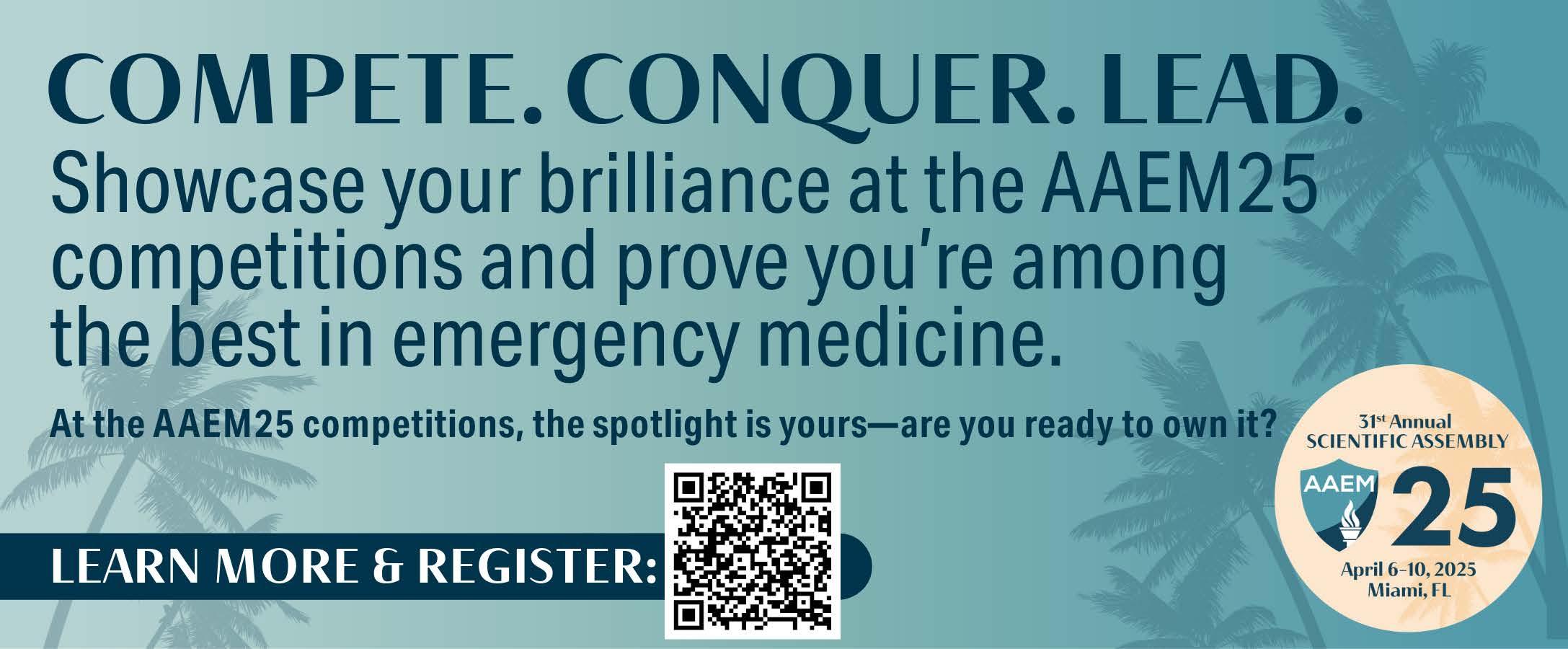
Supid Bose, MD FAAEM

Afew years ago, while addressing veterans about my nonprofit, The Battle Continues, I was approached by a cameraman from “Texas Country Reporter,” the longest-running independently produced television program in the U.S. Since its inception in 1972, it has earned over 30 Emmy Awards. It highlights diversity, culture, and unique stories across Texas.
With the support of my workplace, Odessa Medical Center Hospital, HIPAA compliance was addressed, and filming commenced. The directors, intrigued by emergency medicine challenges, developed a docuseries around my experiences titled “Desert Doc,” later released on Amazon Prime in the U.S. and U.K.
Before the show, I had experienced media exposure, notably as an Army physician who examined Saddam Hussein after his capture, which brought recognition as a CNN Hero.
However, being on camera during emergency shifts requires a significant adjustment.
“Desert Doc” highlights the critical decision-making and resourcefulness required of emergency physicians in rural settings. It explores socio-cultural factors impacting healthcare and the importance of building trust with diverse patient populations. Viewers gain a deeper understanding of the complexities of emergency medicine in a fragmented healthcare system, emphasizing teamwork and resilience.
The series covers scenarios such as oilfield injuries, opioid overdoses, mass shooting aftermaths, and heat-related emergencies, paralleling my experiences as a combat physician in Iraq. These stories underscore the challenges of providing care under harsh conditions, whether in the deserts of West Texas or a war zone.
I invite you to watch “Desert Doc” and reflect on its message about overcoming the challenges of rural emergency medicine.
Dr. Sudip Bose has been an AAEM member for over 25 years and is a former combat physician during the Iraq War. He advances emergency medicine and veteran care through speaking engagements, his role in the Amazon Prime docuseries “Desert Doc,” and as co-founder of ABEMPrep.com, supporting emergency physicians preparing for ABEM exams. Scan the QR code to learn more about “Desert Doc.”
T hese stories underscore the challenges of providing care under harsh conditions, whether in the deserts of West Texas or a war zone.”

Sean Buehler, MD, Christian M Garcia, MD, and Christopher Root, MD
As emergency physicians in New Mexico—the fifth largest state by land mass yet ranking 45th in population density—we depend on a robust network of aeromedical and ground transport teams to connect patients with definitive care. As both sending physicians and members of a transport team, we appreciate how a well-prepared sending physician can support the transport team’s care and enhance the patient’s outcomes. These teams are best positioned for success when physicians respect their expertise, understand their capabilities, prepare them appropriately, and clearly communicate critical aspects of the care plan. Whether transport times are hours or minutes, patients benefit from well-prepared and high-quality transports.
Transport teams play a high-risk role in our healthcare system. They not only expose themselves to medicolegal risks by caring for critically ill patients in resource-limited settings, but they also face substantial physical risks each time they lift a patient from a helicopter pad or navigate busy highways. Despite these challenges, transport teams consistently demonstrate a steadfast commitment to delivering high-quality care to some of our most vulnerable patients. They are trained to apply their clinical skills and judgment to enhance patient care, often initiating interventions that the receiving facilities recognize as beneficial and choose to continue. As sending physicians, we must recognize the transport team as an integral part of the patient’s care team, rather than merely a conduit to the next intervention.
First and foremost, sending physicians must understand their obligations under the Emergency Medical Treatment and Labor Act (EMTALA). They must determine that the patient’s condition is stable enough to withstand transport. Once this assessment is made and transport arranged, the sending facility must continue providing ongoing care to minimize risks, ensure the receiving facility has the
[Transport] teams are best positioned for success when physicians respect their expertise, understand their capabilities, prepare them appropriately, and clearly communicate critical aspects of the care plan.”
necessary space and qualified personnel, and prepare and send all relevant medical records.
The sending physician remains responsible for the patient until they arrive at the receiving facility. Selecting appropriate transport resources and understanding the transport team’s capabilities is not only in the patient’s best interest but also a legal imperative.

The sending physician’s role in interfacility transport begins with understanding the transport team’s capabilities prior to their arrival and adjusting the treatment plan accordingly to facilitate their success. It may be beneficial for the sending physician to prepare for transport as if they were accompanying the patient. If the transport team does not carry essential medications or desired concentrations, consider supplying these from the sending facility’s pharmacy. Anticipating the patient’s worst-case scenario can help identify adjuncts and tools, such as appropriately sized airways or specialized devices that can be also provided by the sending facility. Furthermore, maximizing resuscitation and stabilization efforts before the transport team arrives will provide them with a greater buffer against potential decompensation. Resource-intensive procedures, such as central venous access or arterial pressure monitoring, should ideally be performed by the sending facility before the transport team’s arrival to expedite transport time and expand the tools available for the team to monitor the patient and intervene if necessary.
It is critical to develop contingency plans that prepare transport crews for possible patient decompensation. These plans should be
communicated to the transport team clearly and precisely using closed-loop communication. The sending physician should be present at the bedside during the transfer of care to articulate overarching clinical goals and reinforce the critical details conveyed during the nursing report. Sending physicians should also foster a culture that allows transport crews to ask questions, raise concerns, and establish communication plans if further direction is needed during transport. These details should be documented in a well-organized written format. Many electronic medical records (EMRs) produce printed documents that can be cumbersome for transport teams. Consider drafting a concise SOAP note tailored specifically for the transport team or developing a standardized dot phrase for efficient reproduction across cases. Additionally, ensure that any imaging and associated reports are provided on a disc or transmitted electronically.
While EMTALA mandates certain obligations to ensure safe transport, sending physicians should strive to exceed these legal minimums by utilizing clear and concise communication, leveraging their facility’s resources, and recognizing the dedication and capabilities of the transport team. Critical access hospitals should consider creation of reference material that has a list of transporting agencies, their capabilities or limitations and work to streamline processes between clinical sites and tertiary referral centers to allow for expediated transport in time sensitive emergencies. This approach will maximize the patient’s chances of safe and efficient transport.
Bruce Lo, MD FAAEM and Melissa Myers, MD FAAEM
Background
A 26-year-old woman presents with a one-day history of lower abdominal cramping. She reports a positive home pregnancy test, with her last menstrual period occurring six weeks ago. On examination, she is hemodynamically stable but has mild tenderness in the suprapubic region. You perform a bedside transvaginal ultrasound confirming a 6-week intrauterine pregnancy with an appropriate fetal heart rate and no adnexal masses. After reassuring her, you arrange follow-up with the on-call OB/ GYN and discharge her within 90 minutes of her arrival. As you hand the transvaginal ultrasound probe to the ED technician, they ask for guidance on how to properly clean it.
Typically, probes used on the skin surface are cleaned after each use by removing visible contamination, followed by disinfection with a low-level disinfectant (LLD). LLDs, which are often alcohol- or quaternary ammonium compound-based, are applied via spray or wipes.
However, internal probes, such as those used for transvaginal imaging, are more prone to contamination, even when probe covers and LLDs are used. One study reported a condom breakage rate of up to 13% during transvaginal examinations.1 Another study found bacterial contamination rates of 33.7% after sheath removal, which decreased to 12.9% after LLD cleaning. Similarly, viral contamination rates were 19.4% after sheath removal and dropped to 1.0% following LLD cleaning.2 Due to the significant risk of cross-contamination, current guidelines recommend high-level disinfection (HLD) for ultrasound transducers after internal use.3
Traditional HLD systems often utilize chemical solutions like glutaraldehyde or hydrogen peroxide and require a separate device for cleaning. However, in 2023, the FDA approved an HLD solution in a wipe form, which is now available in the U.S. as an alternative to machine-based HLD platforms. These wipes have been approved and used in Europe since 2008.4
One of the biggest challenges with current HLD systems is the cost. These systems require a significant upfront investment for the equipment if installed in the emergency department (ED). Additionally, each use incurs ongoing expenses for disposable supplies needed to clean the probes. Maintenance of the equipment can also involve substantial fees. Furthermore, some systems require a dedicated ventilated area to manage fumes produced during the cleaning process, which can add additional costs.
Some HLD consumables, such as glutaraldehyde-based solutions, are highly caustic. These solutions can cause irritation or injury upon contact and may produce significant discomfort if inhaled. Additionally, many of these chemicals can degrade ultrasound probes over time, reducing their lifespan. Each HLD device requires specific training and ongoing competency maintenance for ED staff, which can be time-consuming. Improper use of these devices or solutions can result in damage to the HLD equipment, the ultrasound probes, or both.
High level disinfection for ultrasound probes can present a logistical challenge, but is essential for patient safety.”
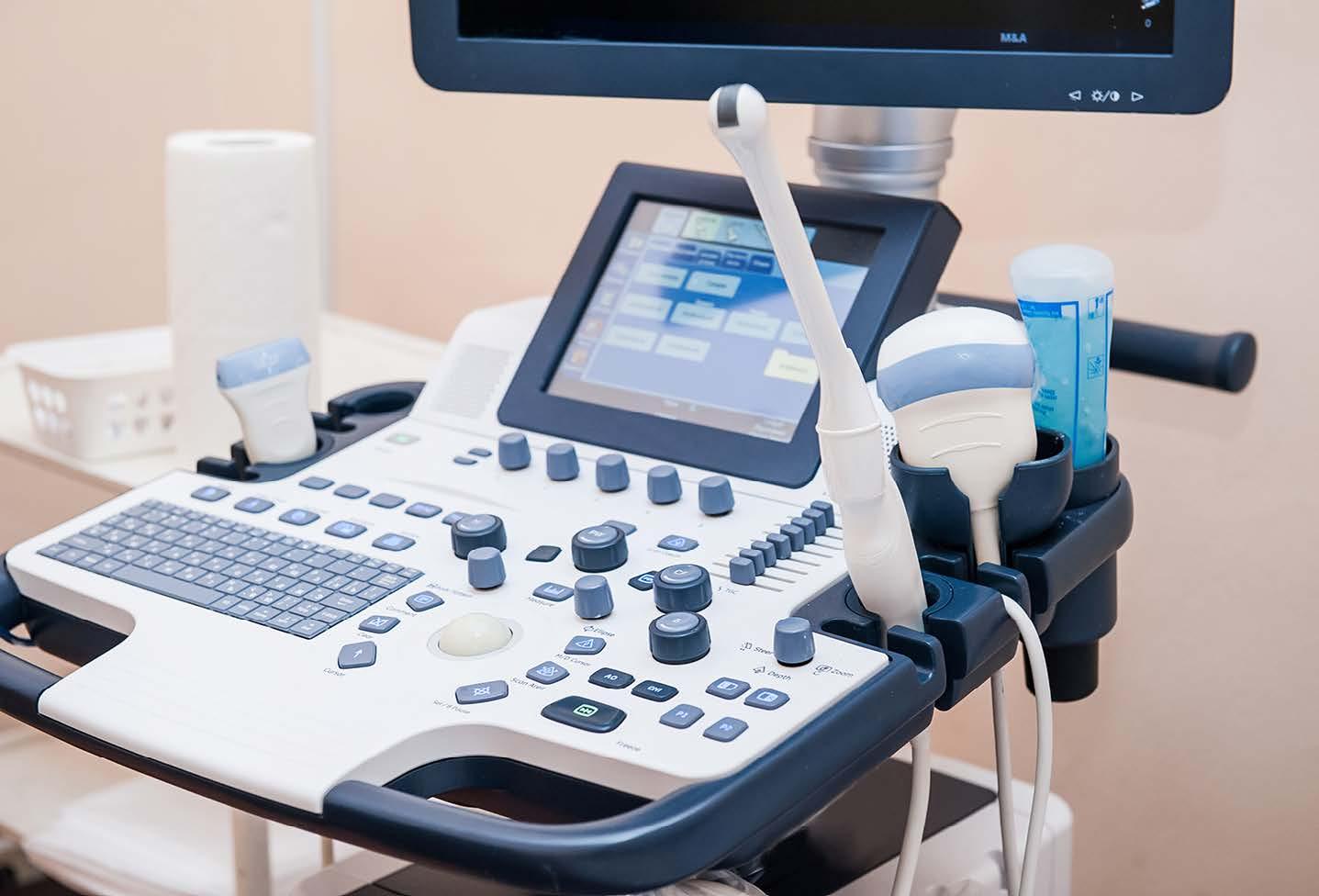
If the HLD system is not within the ED, then staff will need to send the probes to another department (e.g. radiology) for cleaning, which can have a significant turnaround time. This could limit the availability for the next case.
In contrast, HLD wipes eliminate the need for costly equipment and the associated expenses. Applying the HLD solution is quick, taking only two minutes, after which the probe is wiped dry and ready for use. Additionally, because these wipes do not require a specialized ventilation system, cleaning can be performed anywhere in the ED, including at the bedside. HLD wipes are also not known to degrade or damage the ultrasound probes.
While the high level disinfectant wipes present several clear advantages, there are some disadvantages which should be considered as well. The first is that the manufacturer’s instructions require two minutes of contact between the wipe and the probe. This presents a time burden to the physician, and it is unlikely that a busy emergency physician would truly wipe the probe for two minutes. In that case, the probe would not be fully disinfected and would present an infectious risk. In addition, the probe would need to be grossly decontaminated, similar to the current HLD systems. ED staff may not remember this step and it is unclear if the wipes would be effective in the setting of gross contamination, such as that commonly seen in the trauma bay.
A second consideration is cost. Sending a probe to hospital disinfection incurs minimal cost to the ED as the high cost of installing disinfection equipment is a sunk cost. However, the high level disinfection wipes cost
References
1. Basseal JM, Westerway SC, Hyett JA. Analysis of the integrity of ultrasound probe covers used for transvaginal examinations. Infect Dis Health. 2020 Mar;25(2):77-81.
2. Leroy S. Infectious risk of endovaginal and transrectal ultrasonography: systematic review and meta-analysis. J Hosp Infect. 2013 Feb;83(2):99106.
approximately $2.50 to $3 per application, which, while not an insurmountable barrier, could present a significant cost if used consistently.
Finally, there is no published data on the long-term effect of these wipes on the probe. Further data is needed to see if consistent use of these wipes would cause degradation of the probe. Although the wipes have been used in Europe for over a decade, it is unclear if any specific evaluation on probe degradation has been performed.
High level disinfection for ultrasound probes can present a logistical challenge, but is essential for patient safety. Sending probes out of the ED for high level disinfection requires a prolonged turnaround time, and installing necessary equipment for high level disinfection in the ED requires a significant up front cost and ongoing dedicated personnel and training. HLD wipes present a potential way to alleviate both problems, with no dedicated equipment installation required and minimal training requirement. In addition, HLD wipes are portable and relatively cost effective. However, HLD wipes do have potential concerns such as compliance with proper use as recommended by the manufacturer and limited long-term data on effect on probe integrity. EDs considering the use of HLD wipes should consider both risks and benefits prior to implementation.
Author Disclaimer: The opinions and assertions expressed herein are those of the author, and do not reflect the official policy or position of the Uniformed Services University of the Health Sciences or the Department of Defense.
3. AIUM Official Statement: Guidelines for Cleaning and Preparing Externaland Internal-Use Ultrasound Transducers and Equipment Between Patients as Well as Safe Handling and Use of Ultrasound Coupling Gel. J Ultrasound Med. 2023 Jul;42(7):E13-E22.
4. https://www.parkerlabs.com/products/tristel-ult/. Accessed 11/20/2024

The American Academy of Emergency Medicine would like to share the 2024-2025 Chapter Division Leadership and congratulate them on their election! If you are interested in an open position below, please reach out to us at info@aaem.org.
California Chapter Division (CAL/AAEM)
Delaware Valley Chapter Division (DVAAEM)
Great Lakes Cha pter Division (GLAAEM)
Missouri Chapter Division (MOAAEM)
President
Faith Quenzer, DO MPH FAAEM
Vice President
Open Position
Secretary
Danielle Goodrich, MD FAAEM
Treasurer
Shahram Lotfipour, MD MPH FAAEM
Immediate Past President
Jesse Borke, MD CPE FAAEM
At-Large Directors
Victor M. Cisneros, MD MPH CPH FAAEM
Jessica Muñoz, MD
Daniel Nelson, MD FAAEM
Jennifer Kanapicki Comer, MD FAAEM
Associate Representative
Carl Preiksaitis, MD
Resident Representative
One Open Position
Nicole McAmis, MD
Kevin Cabrera, DO, MS
Student Representative
Patrick Bryan
Capital Region Chapter Division (CR/AAEM)
President – Delaware
Eli Zeserson, MD FAAEM
President – New Jersey
Emerson Franke, MD FAAEM
President – Pennsylvania
Rebecca Mills, MD FAAEM
At-Large Director – Delaware
J. Daniel Hess, MD FAAEM FACEP
At-Large Director – New Jersey
Open Position
At-Large Director – Pennsylvania
Katrina Kissman, MD FAAEM
Resident Representative – Delaware
Blythe Fiscella, MD
Resident Representative – New Jersey
John D. Genova, MD
Resident Representative – Pennsylvania
Michelle Joyner, DO MS
Resident Representative – Pennsylvania
Rahul Kathard, MD
Florida Chapter Division (FLAAEM)
President Open Position
Immediate Past President
Brady McIntosh, MD FAAEM
Vice President
Open Position
Secretary/Treasurer
Bob Zemple, MD MBA FAAEM
IA State Representative Olivia Bailey, MD FAAEM
IN State Representative
Courtney Soley, MD FAAEM
MI State Representative
Larisa Traill, MD FAAEM
OH State Representative Eric Brader, MD FAAEM
WI State Representative
Jon Rubin, MD FAAEM
Resident Representatives Two Open Positions
Louisiana Chapter Division (AAEMLa)
President
Open Position
Vice President
Open Position
Secretary Treasurer Open Position
Immediate Past President
Jennifer A. Cooper-Lewis, DO FAAEM
At-Large Director
Gary M. Gaddis, MD PhD MAAEM FAAEM FIFEM
Allison Zanaboni, MD FAAEM
Three Open Positions
Resident Representative Open Position
Student Representative Open Position
New York-Connecticut Chapter Division (NY-CT/ AAEM)
President
Kevin Reed, MD FAAEM
Vice President
Open Position
Past President
Terrence M. Mulligan, DO MPH FAAEM
FACOEP FIFEM FACEP FNVSHA FFSEM HPF
Secretary/Treasurer
Joshua Easter, MD MSc FAAEM
At-Large Directors
Four Open Positions
Resident Representative
Robert Dunn, MD
One Open Position
Student Representative
Carolina Fernandez
President
Michael Dalley, DO FAAEM
Vice President
Mark A. Newberry, DO FAAEM
Secretary Treasurer
Rian Pillitteri, MD FAAEM
Past President’s Council Representative
Mark A. Foppe, DO FAAEM FACOEP
Immediate Past President
Steven Parr, DO FAAEM
Scientific Assembly Planning Committee
Director
Joseph Shiber, MD FACP FCCM FNCS
David A. Farcy, MD MAAEM FAAEM FCCM
At-Large Director
Sagar Galwanker, MD FAAEM
Rose V. Goncalves, MD FAAEM
Loice Swisher, MD MAAEM FAAEM
Alexandra Terskiy, MD FAAEM
Resident Member Representative
Ryan Kelly, MD
Yongoon “Nick” Lee, MD
Medical Student Member Representative Lexington Lemmon
President
Christopher Wolcott, MD FAAEM
Vice President
Meghan Maslanka, MD FAAEM
Secretary Treasurer
Open Position
Immediate Past President
Deborah D. Fletcher, MD FAAEM
At-Large Director
Lauren Theriot, MD
Michael H. Truax, Jr., MD FAAEM Two Open Positions
Resident Representative
Benjamin Castin, MD
Joshua Lara, MD One Open Position
Student Representative Open Position
President
Nicholas A. Schwartz, MD FAAEM
Vice President
Leah B. Colucci, MD MS
Secretary/Treasurer
Alex Sneddon, DO
Immediate Past President
Lillian Oshva, MD FAAEM
At-Large Board Members
Deborah Dean, MD FAAEM
Leyam Kewson, MD FAAEM
Shenequa Mcleod, MD FAAEM
Matthew Morrison, MD
Resident Representative
Spencer Matson, MD
Student Representative
Gabriela Hernandez
To learn more about AAEM chapters and to get involved, scan the QR code or visit aaem.org/get-involved/ chapters
President
Jeffrey M. Pinnow, MD FAAEM FACEP
Vice President
Saba A. Rizvi, MD FAAEM
Secretary Treasurer
Kendall I. Moore, MD MBA FAAEM
At-Large Director
Richard J. Wiltse, MD FAAEM Five Open Positions
Resident Representative Two Open Positions
Medical Student Representative Open Position
President
William E. Lummus, MD FAAEM
Vice President
Brian T. Hawkins, MD FAAEM
Secretary-Treasurer
Arthur Smolensky, MD FAAEM
Immediate Past President
James Parnell, MD FAAEM
At-Large Director
Jacqueline Dovgalyuk, MD FAAEM Four Open Positions
Resident Representative
Ashley Dailey, DO One Open Position
Student Representative Open Position
President
Alexander F. Barbuto, MD FAAEM
Vice President
Undergoing Election
Secretary-Treasurer
Open Position
Immediate Past President
Jacob L. Arnold, MD FAAEM
Air Force Representative
Rachel Ely, DO FAAEM
Army Representative
Juliette Conte, MD FACEP FAAEM
Navy Representative
Sean Stuart, DO FAAEM FACEP FAWM
Resident Representative
CPT Logan Morin, DO
Medical Student Member Representative 2LT Virginia Thomas
Reserve/Retired Representative
Bret T. Ackermann, DO MSS FAAEM

Frederick W. Cheney, Richard T. Connis, Orin F. Guidry, David G. Nickinovich, Andranik Ovassapian. Practice Guidelines for Management of the Difficult Airway: An Updated Report by the American Society of Anesthesiologists Task Force on Management of the Difficult Airway. Anesthesiology. 2003;98(5):1269-1277. doi:10.1097/00000542-200305000-00032
4. White LD, Melhuish TM, White LK, Wallace LA. Apnoeic Oxygenation during Intubation: A Systematic Review and Meta-analysis. Anaesth Intensive Care. 2017;45(1):21-27. doi:10.1177/0310057X1704500104
5. Cabrini L, Landoni G, Baiardo Redaelli M, et al. Tracheal intubation in critically ill patients: a comprehensive systematic review of randomized trials. Crit Care. 2018;22(1):6. doi:10.1186/s13054-017-1927-3
6. Henderson JJ, Popat MT, Latto IP, Pearce AC. Difficult Airway Society guidelines for management of the unanticipated difficult intubation. Anaesthesia. 2004;59(7):675-694. doi:10.1111/j.1365-2044.2004.03831.x
7. Russotto V, Myatra SN, Laffey JG, et al. Intubation Practices and Adverse Peri-intubation Events in Critically Ill Patients From 29 Countries. JAMA. 2021;325(12):1164-1172. doi:10.1001/ jama.2021.1727
8. Detsky ME, Jivraj N, Adhikari NK, et al. Will This Patient Be Difficult to Intubate?: The Rational Clinical Examination Systematic Review. JAMA. 2019;321(5):493-503. doi:10.1001/jama.2018.21413
9. Acquisto NM, Mosier JM, Bittner EA, et al. Society of Critical Care Medicine Clinical Practice Guidelines for Rapid Sequence Intubation in the Critically Ill Adult Patient. Crit Care Med. 2023;51(10):1411. doi:10.1097/CCM.0000000000006000
10.Engstrom K, Brown CS, Mattson AE, Lyons N, Rech MA. Pharmacotherapy optimization for rapid sequence intubation in the emergency department. Am J Emerg Med. 2023;70:19-29. doi:10.1016/j.ajem.2023.05.004
11.Michael Lipnick, Cornelius Sendagire, Rich Branson, Rebecca Silvers. Overview of oxygen delivery devices. Open Critical Care. Accessed October 11, 2024. https://opencriticalcare.org/ encyclopedia/overview-of-oxygen-delivery-devices/
12.Karamchandani K, Nasa P, Jarzebowski M, et al. Tracheal intubation in critically ill adults with a physiologically difficult airway. An international Delphi study. Intensive Care Med. 2024;50(10):1563-1579. doi:10.1007/s00134-024-07578-2
13.Baillard C, Fosse JP, Sebbane M, et al. Noninvasive ventilation improves preoxygenation before intubation of hypoxic patients. Am J Respir Crit Care Med. 2006;174(2):171-177. doi:10.1164/ rccm.200509-1507OC
14.Baillard C, Prat G, Jung B, et al. Effect of preoxygenation using non-invasive ventilation before intubation on subsequent organ failures in hypoxaemic patients: a randomised clinical trial. Br J Anaesth. 2018;120(2):361-367. doi:10.1016/j.bja.2017.11.067
15.Gibbs KW, Semler MW, Driver BE, et al. Noninvasive Ventilation for Preoxygenation during Emergency Intubation. N Engl J Med. 2024;390(23):2165-2177. doi:10.1056/NEJMoa2313680
16.Guitton C, Ehrmann S, Volteau C, et al. Nasal high-flow preoxygenation for endotracheal intubation in the critically ill patient: a randomized clinical trial. Intensive Care Med. 2019;45(4):447-458. doi:10.1007/s00134-019-05529-w
17.Frat JP, Ricard JD, Quenot JP, et al. Non-invasive ventilation versus high-flow nasal cannula oxygen therapy with apnoeic oxygenation for preoxygenation before intubation of patients with acute hypoxaemic respiratory failure: a randomised, multicentre, open-label trial. Lancet Respir Med. 2019;7(4):303-312. doi:10.1016/S2213-2600(19)30048-7
18.von Goedecke A, Wenzel V, Hörmann C, et al. Effects of face mask ventilation in apneic patients with a resuscitation ventilator in comparison with a bag-valve-mask. J Emerg Med. 2006;30(1):63-67. doi:10.1016/j.jemermed.2005.02.021
19.von Goedecke A, Wagner-Berger HG, Stadlbauer KH, et al. Effects of decreasing peak flow rate on stomach inflation during bag-valvemask ventilation. Resuscitation. 2004;63(2):131-136. doi:10.1016/j. resuscitation.2004.04.012
20.Apfelbaum JL, Hagberg CA, Connis RT, et al. 2022 American Society of Anesthesiologists Practice Guidelines for Management of the Difficult Airway. Anesthesiology. 2022;136(1):31-81. doi:10.1097/ ALN.0000000000004002

To place an ad in the Job Bank: Equitable positions consistent with the Mission Statement of the American Academy of Emergency Medicine and absent of restrictive covenants, will be published (upon approval). All ads run for a six month period or until canceled and will appear in the AAEM member magazine Common Sense and online. For pricing and more information visit www.aaem.org/membership/benefits/ job-bank.
Complete a Job Bank registration form, along with the Criteria for Advertising Section, and submit payment. If you are an outside recruiting agent, the Job Bank Criteria for Advertising must be downloaded and completed by a representative from the recruiting hospital/group.
Direct all inquiries to: www.aaem.org/membership/benefits/job-bank or email info@aaem.org.

Positions Available
For further information on a particular listing, please use the contact information listed.
Section I: Positions listed in Section I are in compliance with elements AAEM deems essential to advertising in our job bank. Fairness practices include democratic and equitable work environments, due process, no post contractual restrictions, no lay ownership, and no restrictions on residency training and have been given the AAEM Certificate of Workplace Fairness.
Section II: Positions listed in Section II are in compliance with elements AAEM deems essential to advertising in our job bank. Fairness practices include democratic and equitable work environments, due process, no post contractual restrictions, no lay ownership, and no restrictions on residency training but have not been given the AAEM Certificate of Workplace Fairness.
Section III: Positions listed in Section III are hospital, non-profit or medical school employed positions, military/government employed positions, or an independent contractor position and therefore cannot be in complete compliance with AAEM workplace fairness practices.
SECTION I: POSITIONS RECOGNIZED AS BEING IN FULL COMPLIANCE WITH AAEM’S JOB BANK CRITERIA AND GIVEN THE AAEM CERTIFICATE OF WORKPLACE FAIRNESS
Southern Colorado Emergency Medical Associates (SCEMA) is hiring full and part time emergency physicians. SCEMA is a democratic group of over 30 years based in Southern Colorado staffing UCHealth Parkview Medical Center in Pueblo, CO and UCHealth Parkview Pueblo West Hospital in Pueblo West, CO. SCEMA holds an AAEM Certificate of Workplace Fairness and is an AAEM practice group member. Come live and work in the beautiful Front Range of Colorado. We offer a superior financial package with a 2-year partnership track and subsequent income as a partner based upon productivity. Receive a competitive hourly rate pre-partnership with an average annual compensation of $250k. Alternative non-partnership
track, part-time hourly rate available. Partners average annual compensation is $470k per year including profit sharing, 401k plan, and a SCEMA funded cash balance plan. Additional benefits include health insurance, CME, malpractice insurance, compensation for licensing examinations and travel, medical and DEA licensing fees, as well as relocation expenses coverage. Full time status is approximately 13-14 shifts per month with 8-10 hour shifts. Must be BE/BC in emergency medicine. Please email Dr. Mary Russo at mary.russo@uchealth.org or Dr. Tyler Keller at tyler.keller@uchealth.org if interested. (PA 2104) Email: mary.russo@uchealth.org
Salinas Valley Emergency Medical Group is seeking a fulltime addition to our work family. Our small, democratic group staffs a busy, high-acuity ED at a regional tertiary care/STEMI/ stroke receiving facility with ~65,000 ED visits annually and excellent subspecialty backup. We have strong relationships with administration and consultants and have maintained a stable contract for over 20 years. We care for a culturally and medically diverse population, and there are abundant leadership opportunities within the group, hospital, and broader community. 12 10-hour shifts/month for 3-year partnership track. Currently Meditech, transitioning to Epic in 2025. Scribes, Dragon. (PA 2113)
Email: svemgcareers@gmail.com
Website: https://www.svemg-emergencymedicine.com/
MARYLAND
Doctors Emergency Services PA (DESPA) is seeking a full time board certified/board eligible Emergency Medicine Physician to join our independent group serving Luminis Anne Arundel Medical Center in Annapolis, Maryland. This is a high volume ED with 97,0000 visits annually with a diverse patient population with most specialist services available for consultation to minimize transfers. Epic EMR + Dragon dictation. We are proud of our stability at the hospital with low physician turnover because of
our supportive environment and our prime location in Annapolis convenient to DC and Baltimore. Separate pediatric ED opportunities also available. (PA 2096) Email: thaagdespa@gmail.com
CityMD is a network of urgent care centers dedicated to setting an unprecedented standard of care for our patients and an edifying, intuitive work environment for our employees. We are looking for board-certified Emergency and Family Practice trained physicians who thrive in an environment surrounded by highly trained and motivated individuals and operate on one of the most advanced administrative systems in healthcare today. Your responsibilities will include the diagnosis and treatment of patients of all ages and interpreting and archiving medical information. We are hiring board-certified physicians who are Emergency Medicine or Family Medicine trained to work in our state-of-the-art urgent care centers. Our facilities are staffed with highly trained and motivated individuals who operate one of the most advanced administrative systems in healthcare today. Highlights • Scribes on staff. This allows you to focus your time on direct patient care. • Advanced imaging available on a routine and STAT basis, including CT, US and MRI. • Specialist consultation allows for 48 hour turn around and same day results for urgent cases. • State-of-the-art facilities, digital
X-Ray, laboratory services with modern, clean and aesthetically designed work environments. • Dedicated physician led Aftercare team following up on all aspects of patient care. • Integrated Electronic Medical Records across all CityMD locations. Our commitment to our patients and employees, along with our stateof-the-art personalized healthcare delivery system, has taken CityMD from one location on the Upper East Side to over 130 in the New York/New Jersey area including Northern/Central/ Southern New Jersey and Manhattan, Brooklyn, Queens, Long Island, Rockland, and Westchester County. As a proud “People First” company, we are centered on the values of integrity, excellence, professionalism, and quality. Our Compensation package is broken down as follows: • Competitive hourly rate plus performance-based bonus • 4 weeks of paid time off • $3000 annually in CME • Full medical, dental and vision benefits, as well as short term and long term disability benefits and company paid life insurance • Medical Professional Liability Insurance Covered • Holiday Pay & Extended Hour Site Differentials up to $45/hour on top of base • $120 - $185 per hour The provided compensation range is based on industry standards and salary determinations will be made based on numerous factors including but not limited to years of experience, individual performance, quality measures and location of position. (PA 2107)
Email: slameira@summithealth.com Website: https://www.citymd.com
The Emergency Department of Saskatoon is seeking Emergency Medicine physicians, full time and locums. The successful candidate(s) will provide services in three tertiary care facilities serving Saskatoon and Northern Saskatchewan. There will also be an opportunity and responsibility to teach residents and medical students training at the University of Saskatchewan, College of Medicine. Please visit www.saskdocs. ca for the full job postings Compensation details – Competitive, independent, Alternative Payment Plan (APP) contract Location of practice – Saskatoon, Saskatchewan Language of work - English Qualifications/Requirements of the position –The successful candidate will hold the designation of FRCPCEM, CCFP-EM or ABEM and be eligible for licensure with the College of Physicians and Surgeons of Saskatchewan. This
opportunity may be eligible to receive the Emergency Medicine Emergency Medicine Recruitment and Retention Incentive of up to $200,000! The program applies to Specialist Emergency Medicine physicians and Family Medicine Emergency Medicine physicians. Residents currently in their 4th or 5th year of residency may be eligible for a $30,000 resident bursary! If you have specific questions about this position, please contact: Dr. James Stempien Provincial Head Emergency Medicine Email: james.stempien@usask.ca (PA 2110) Email: amanda.lee@saskhealthauthority.ca Website: https://www.saskhealthauthority.ca/
Fox Valley Emergency Medicine in Neenah, WI is recruiting to hire a full time doc. We are a single democratic group of 8 docs. We staff a single hospital with stable contract for last 20 years.
Highlights: Hospital- Thedacare in Neenah WI, trauma level II & comprehensive stroke center Patients per hour - 1.5 to 1.7 avg Compensation- 1st year: W2 rate of $250/hr, 144 hrs per month. 1 year partnership track and partners made $375+/hr. Shifts: 10 hour shifts, with a full time nocturnist. 54 hours of coverage per day. (PA 2109) Email: srikarkaranam@gmail.com
COLORADO
As a full-time faculty member in our community and academic clinical sites, be a part of a remarkable team dedicated to an inclusive learning and work environment and driven to save lives, educate health professionals and scientists, advance science, serve our communities, improve patient safety, experience, and clinical quality. We seek passionate physicians to join us at the University of Colorado Department of Emergency Medicine academic and community sites, which may include any affiliated free-standing emergency department, virtual healthcare, Broomfield Hospital, Highlands Ranch Hospital, or the University of Colorado Hospital. Your commitment to professional development is essential, and we support your continuous growth by providing the necessary Continuing Medical Education (CME) opportunities, competitive salary, and a robust benefits package. The University of Colorado is deeply committed to recruiting and supporting a diverse student body, faculty, and administrative staff; fostering a culture of inclusiveness, respect, communication, and understanding. We strongly encourage applications from persons of all backgrounds, genders, minorities, and abilities. Apply now for a Clinical Faculty Position in our academic and community sites at the University of Colorado Department of Emergency Medicine. (PA 2079)
Email: felicia.gallegospettis@CUANSCHUTZ.EDU
Website: https://cu.taleo.net/careersection/2/jobdetail. ftl?job=34105&lang=en
COLORADO
The Department of Emergency Medicine at Denver Health, in conjunction with the Denver Health Paramedic Division, is recruiting a full-time academic emergency physician to serve as an Associate EMS Medical Director with focus on EMS education and prehospital medical direction. Our highly functioning and established EMS team consists of the Paramedic Division Medical Director/Associate Department Chair of EMS and three associate directors, all subspecialty certified in EMS, working collaboratively to provide medical direction to over 265 Denver Paramedics and EMT’s, Denver Paramedics Dispatch and the Denver Health Paramedic School. This faculty position will directly report to the Associate Chair for EMS and ultimately to the Chair of Emergency Medicine at Denver Health. As a full-time academic faculty position, based at the sponsoring institution for the Denver Health Residency in Emergency Medicine, there will be a heavy emphasis on, and expectation for, scholarship/research, teaching, and education. All faculty are expected to contribute and promote in the Department of Emergency Medicine at the University of Colorado School of Medicine. The Denver Health Paramedic Division (DHPD) provides 911 Advanced Life Support (ALS) Emergency Medical Services (EMS) and ambulance transportation to the City and County of Denver, Denver International Airport, as well as the cities of Glendale, Sheridan, Englewood, and areas of unincorporated Arapahoe County. The Denver Health Paramedic Division consists of 269 front line paramedics and emergency medical technicians (EMT), 41 command staff, and an additional 100 employees in communications, education, vehicle, and administration support. Our system responds to more than
128,000 calls for Emergency Medical Services annually. Interested applicants can apply online or submit CV/Cover Letter to: Aaron Ortiz, Manager of Provider Recruitment Denver Health Medical Center Aaron.ortiz@dhha.org (PA 2091)
Email: aaron.ortiz@dhha.org
Website: https://www.denverhealth.org
The Department of Emergency Medicine at Denver Health is recruiting a full-time academic emergency physician scientist to serve as a core member of our research program with focus on Social Emergency Medicine. Preference will be given to individuals who have advanced training, dedicated interest, and a track record of accomplishment in this area. Faculty are expected to be highly motivated and engaged academicians, robustly contributing to, and aligned with, our departmental mission of ‘Serving Our Patients and Leading Our Specialty.’ As such, our recruitment will place a strong emphasis on teamwork and collaboration. This faculty position will directly report to the Director of Emergency Medicine Research and ultimately to the Chair of Emergency Medicine at Denver Health. As a full-time academic faculty position, based at the sponsoring institution for the Denver Health Residency in Emergency Medicine, there will be a heavy emphasis on, and expectation for, scholarship/research, teaching, and education, particularly in Social Emergency Medicine. All faculty are expected to contribute and promote in the Department of Emergency Medicine at the University of Colorado School of Medicine. The emergency department (ED) at Denver Health includes a 57-bed adult ED, a 19-bed pediatric ED and urgent care, and a 23-bed CDU providing observation medicine. With a combined annual census of more than 100,000 patient visits from highly diverse cultures and backgrounds, the ED at Denver Health is the second busiest in Colorado. The Ernest E Moore Shock Trauma Center at Denver Health is a Level 1 adult and Level 2 pediatric trauma referral center for the Rocky Mountain Region. Additionally, the acuity managed by the adult ED is high, with a 25% admission rate. Staffing in the adult and pediatric EDs is provided by board-eligible or board-certified emergency physicians, emergency medicine residents and subspecialty fellows, and advanced practice providers. Strong and extremely collaborative relationships exist among physicians, advanced practice providers, nursing, and consultative services. As an institution, Denver Health is a nationally recognized integrated health care system that serves as the primary Anchor Institution to the Denver metropolitan area and its diverse community. Denver Health and the Department of Emergency Medicine are firmly committed to diversity of our workforce. As medical providers, we are passionate about serving our diverse patient population and providing them with the best care. To achieve this, we dedicate significant resources as a team to incorporate cultural responsiveness, equity, and inclusion into every aspect of our work. Interested applicants can apply online or submit CV/ Cover Letter to: Aaron Ortiz, Manager of Provider Recruitment Denver Health Medical Center Aaron.ortiz@dhha.org (PA 2092)
Email: aaron.ortiz@dhha.org
Website: https://www.denverhealth.org
Trinity Health Of New England seeks BC/BE EM Physicians to join our emergency medicine teams at Mercy Medical Center in Springfield, Massachusetts and Saint Mary’s Hospital in Waterbury, Connecticut. Our practice model empowers our physicians to work at their highest level, while allowing time for professional development and family life. Whether you are focused on providing outstanding patient-centered care or driven to grow into a leadership role, you will thrive at Trinity Health Of New England. To learn more, visit our provider portal at www. JoinTrinityNE.org (PA 2099)
Email: dhowe@TrinityHealthofNE.org
Website: https://www.jointrinityne.org/Physicians
ChristianaCare, the largest healthcare system in Delaware is searching for a Physician Executive to serve as the Chair, Department of Emergency Medicine and Service Line Leader. The Physician Executive will have a broad scope of authority and accountability for quality, value-based outcomes, workforce stability, financial vitality, and strategic direction of clinical services delivered by the Emergency Medicine service line across the health system in support of system strategy. ChristianaCare is seeking an individual who will continue to expand and enhance Emergency Medicine and Trauma Care leveraging innovative approaches to care while advancing health equity and health preparedness initiatives. (PA 2102)
Email: megan.hopkins@christianacare.org
Website: https://careers.christianacare.org/posting/ JR74677/?page=1
The Department of Emergency Medicine at Indiana University School of Medicine and Riley Children’s Health invites applications for the Chief, Division of Pediatric Emergency Medicine and Vice-Chair, Pediatric Emergency Medicine, Department of Emergency Medicine. We seek a visionary leader dedicated to improving children’s health. The division is supported by a comprehensive system-wide commitment to building a nationally pre-eminent program. Candidates must possess: • MD, MD/PhD or equivalent degree • Board certified or board eligible in Pediatric Emergency Medicine or both EM and Pediatrics • Eligible for an unrestricted medical license in Indiana • Academic credentials for appointment at associate or full professor level (PA 2094)
Email: kerry@careerphysician.com
Website: https://www.rileychildrens.org
Emergency Physician Opening! Pittsfield, MA. Berkshire Health Systems Berkshire Health Systems is seeking a passionate and skilled Emergency Room Physician to join our team at Berkshire Medical Center. With an annual patient volume of 55,000, we are a regional referral center and trauma center committed to providing exceptional care to our community. Collaborative Environment: Join a very stable and collaborative group of professionals who share a commitment to high-quality patient care. Comprehensive Support: Work alongside seasoned
Hospitalists, along with a team of Inpatient Psychiatrists, and various other specialists. Clinical Teaching Opportunities: Engage in periodic clinical teaching with medical students and off-service residents, enhancing the training of the next generation of healthcare providers. No Single Coverage: Enjoy the benefits of a team based approach to patient care, with no single coverage responsibilities. Comprehensive Benefits: • Competitive Sign on Bonus • Professional Liability Insurance • 403(b) & 457(b) Pension Plans • 12 weeks PTO • Short Term and Long Term Disability at no cost to you! • Life and AD&D Insurance at no cost to you! All Interested candidates may apply online at www.berkshirehealthsystems.org or reach out directly to Cody Emond at cemond@bhs1.org. (PA 2105) Email: cemond@bhs1.org
Website: https://www.berkshirehealthsystems.org/
Mercy Emergency Medicine is currently seeking multiple board certified or board eligible Emergency Medicine Physicians to join our practices in Cape Girardeau, Dexter, and Perryville, Missouri. These positions offer: Competitive, shift-based model; Comprehensive, day one benefits including health, dental, vision and CME.; System-wide Epic EMR; As a not-for-profit system, Mercy qualifies for Public Service Loan Forgiveness (PSLF); These locations are eligible for J1 and H-1B sponsorship.; Select locations can accept Family Medicine trained physicians. Your life is our life’s work For more information, contact: Camryn Rivenburgh, Physician Recruiter Phone: 573-902-2676 Camryn. Rivenburgh@Mercy.net | Providers - Mercy Careers AA/EEO/ Minorities/Females/Disabled/Veterans (PA 2087)
Email: sandra.jones@mercy.net
Website: https://careers.mercy.net/
Atrium Health Seeking Pediatric Emergency Medicine Physician - Charlotte, NC The Department of Emergency Medicine at Atrium Health Carolinas Medical Center and Atrium Health Levine Children’s Hospital at the Wake Forest School of Medicine in Charlotte, NC seeks to hire a full-time pediatric emergency physician to join our faculty. Atrium Health is now part of Advocate Health, the third largest non-profit healthcare system in the country. Academic rank at the time of the appointment is commensurate with the candidate’s experience and qualifications. Our Children’s Emergency Department is a level I, academic, tertiary care pediatric emergency department serving just over 38,000 children per year. Charlotte is a growing, welcoming community in a bustling city just a few hours from the coast and the mountains. At the Department of Emergency
Medicine at Carolinas Medical Center, we believe in an inclusive and equitable working and learning environment for all learners, staff, and faculty. Contact: Dr. Stacy Reynolds at stacy.reynolds@ atriumhealth.org. (PA 2089)
Email: Laneisha.Faggart@atriumhealth.org
Website: https://careers.atriumhealth.org/jobs/14581950physician-pediatric-emergency-medicine-charlotte-nc
Brody School of Medicine at East Carolina University is seeking to hire a full-time Associate Dean of Clinical Simulation to lead its Interprofessional Clinical Simulation Program. Responsibilities include leadership and oversight to all activities including; Teaching/Instruction, Administration, Strategic Planning, and Research/Creative Activity. The current program is 10,000 sq. ft with 24-rooms in addition to a 44-foot specialized vehicle that provides simulation education throughout the region, and an MV-22 Osprey Military Transport Simulator. A new 30,000 sq ft Simulation Center will begin construction in spring 2025. (opening Fall 2027). https://apptrkr.com/5634863 (PA 2097) Website: https://apptrkr.com/5634863
Department Chair & System Leader for Emergency Medicine, Thomas Jefferson University | Jefferson Health The successful candidate will serve as both Dept Chair for Emergency Medicine at Sidney Kimmel Medical College and System Leader for Jefferson Health’s 170 academic and community-based ED physicians, who saw 585,567 patients across the system’s 13 EDs last year. The Chair will oversee the academic department’s 55 clinical faculty, 55 residents & fellows, and 21 APPs who staff Thomas Jefferson University Hospitals’ 3 EDs, which saw 127,000 visits last year. For the full position description, email Jennifer.Rumain@jefferson.edu. (PA 2076)
Email: jennifer.rumain@jefferson.edu
Penn State Health Holy Spirit Hospital and Hampden Medical Center is seeking an experienced Emergency Medicine physician to join our team to rotate shifts between these two facilities located in the metro Harrisburg, PA region. This is an excellent opportunity for physicians who wish to enjoy a highquality of life while providing care within a community setting employed by the Penn State Health system. What we’re offering: • Competitive Salary & Sign-On bonus • Commitment to patient safety in a team approach model • Experienced colleagues and collaborative leadership • Comprehensive benefit and retirement package What we’re seeking: • M.D., D.O., or foreign equivalent •
Completion of accredited training program • BC/BE in emergency medicine • Ability to acquire a license to practice in the State of Pennsylvania • Must be able to obtain valid federal and state narcotics certificates About Us: Penn State Health is a multihospital health system serving patients and communities across 29 counties in central Pennsylvania. Located in a safe familyfriendly setting, Hershey, PA, our local neighborhoods boast a reasonable cost of living whether you prefer a more suburban setting or thriving city rich in theater, arts, and culture. We’re conveniently located within a short distance to major cities such as Philadelphia, Pittsburgh, NYC, Baltimore, and Washington DC. We’re proud of our community involvement and encourage you to learn more about Penn State Health and our values. Penn State Health is fundamentally committed to the diversity of our faculty and staff. We believe diversity is unapologetically expressing itself through every person’s perspectives and lived experiences. We are an equal opportunity and affirmative action employer. All qualified applicants will receive consideration for employment without regard to age, color, disability, gender identity or expression, marital status, national or ethnic origin, political affiliation, race, religion, sex (including pregnancy), sexual orientation, veteran status, and family medical or genetic information. (PA 2106)
Email: hpeffley@pennstatehealth.psu.edu
Website: https://www.pennstatehealth.org/careers/jobopportunities/physicians
Temple Health is accepting applications from BC/BE emergency medicine physicians interested in joining the team as faculty. Our EM faculty covers three distinct clinical sites: Temple University Hospital (TUH) – Main Campus, a level 1 Trauma Center; the busy inner city emergency department at TUH - Episcopal Campus; and TUH - Jeanes Campus located in the northern suburbs of Philadelphia. All sites are part of the EM residency program and medical student experience so candidates should have a strong interest in clinical teaching. Clinical time distribution will be matched to the candidate’s interest and qualifications in regards to staffing needs at each. The department prides itself on transparency and equitable treatment of faculty. For additional information and/or to apply, please visit: https://bit. ly/3C4pgAY Lewis Katz School of Medicine at Temple University is an Affirmative Action/Equal Opportunity Employer and strongly encourages applications from women, minorities, veterans, and persons with disabilities. (PA 2108)
Email: Francis.Gallagher@tuhs.temple.edu
